Discharges and Environmental Monitoring Annual Report 2021
Published 8 December 2022
SI Units
| Quantity | SI unit and abbreviation |
|---|---|
| Absorbed dose | Gray (Gy) |
| Dose equivalent | Sievert (Sv) |
| Radioactivity | Becquerel (Bq) |
Multiples and submultiples of SI units
| Factor | Prefix and abbreviation | Factor | Prefix and abbreviation |
|---|---|---|---|
| 10 18 | exa (E) | 10- 3 | milli (m) |
| 10 15 | peta (P) | 10 -6 | micro (μ) |
| 10 12 | tera (T) | 10 -9 | nano (n) |
| 10 9 | giga (G) | 10 -12 | pico (p) |
| 10 6 | mega (M) | 10 -15 | femto (f) |
| 10 3 | kilo (k) | 10 -18 | atto (a) |
The tonne (metric ton) has the official abbreviation ‘t’. However, in this report ‘te’ has been used to avoid confusion with the British ton.
1. Executive Summary
This 2021 report marks the 50th year that such reports have been produced for the Sellafield site in Cumbria.
It provides detailed information on radioactive discharges and disposals, monitoring of the environment and radiological impact, and information on non-radioactive discharges and disposals. It also includes information on beach monitoring, groundwater investigations, corporate carbon footprinting and future effluent discharge projections.
The report provides a summary of the comprehensive data that are available for inspection by members of the public on the Public Registers maintained by the Environment Agency.
There were no instances in 2021 of non-compliance with the numerical limits of permits regulating discharges and disposals of radioactive wastes at Sellafield. Radioactive discharges (aerial and liquid) were well below the permitted limits and were generally lower than those in 2020.
The estimated radiological doses to members of the public in 2021 are summarised in the table below.
Doses due to discharges to sea from Sellafield to adult members of the marine critical group were estimated as 60 µSv, which is lower than the dose estimated for 2020 (71 µSv).
The most significant radionuclides contributing to this dose are plutonium-alpha and americium-241, with the environmental concentrations of these radionuclides being mostly due to historic discharges.
The estimated dose in 2021 due to the consumption of terrestrial foodstuffs was about 5 µSv. Inclusion of dose contributions to this group from inhalation, immersion, external radiation from beach occupancy and marine food consumption results in a dose of about 9 µSv. Doses due to direct radiation from the Sellafield site were estimated as 2.9 µSv to the most exposed members of the public (those who both live and work nearby).
The total dose to the terrestrial critical group (adults) was estimated as 12 µSv which is unchanged from the dose reported for 2020. The most significant radionuclide contributing to adult dose received from the consumption of terrestrial foodstuffs is iodine-129 in potatoes (0.4 µSv).
The estimated doses for the marine and terrestrial critical groups are much lower than the dose constraint for exposure of members of the UK public to man-made controlled sources of radiation (1000 µSv).
Groundwater investigations in 2021 have shown that the concentrations of tritium, technetium-99, strontium-90, total alpha and total beta all remain similar to 2020 results.
The monitoring of the wells located around the site perimeter (which detect any migration of radioactivity from the site) have shown consistent results, indicating no significant levels of radioactivity have reached the site perimeter over this time period.
In considering future effluent discharge projections, the operational liquid and gaseous discharges are projected to reduce substantially as reprocessing activities are completed. For example, tritium discharges are dominated by operational activities.
The distributions of caesium-137 and americium-241 activities for particles and larger objects recovered by the beach monitoring programme in 2021 were similar to those measured in 2020 and within the ranges previously observed.
This provides reassurance that they are part of the same general population and are within the range of activities that were considered in the health risk assessment.
Sellafield Ltd’s carbon footprint was reduced by 6% from 2020/21. It is dominated by the use of electricity and steam at the Sellafield site.
| Critical group doses from operations at Sellafield (µSv) | ||
|---|---|---|
| Pathway | 2020 | 2021 |
| Marine critical group (adults) | ||
| seafood consumption | 32 | 24 |
| aerial pathways | 1.6 | 1.5 |
| external radiation from beach occupancy (marine) | 37 | 35 |
| Total dose to marine critical group (adults) | 71 | 60 |
| Terrestrial critical group (adults) | ||
| inhalation | 0.67 | 0.52 |
| immersion | 0.05 | 0.03 |
| external radiation from beach occupancy (terrestrial) | 3.0 | 2.9 |
| terrestrial foodstuff consumption | 4.6 | 4.7 |
| marine foodstuff consumption | 0.70 | 0.58 |
| direct radiation | 2.8 | 2.9 |
| Total dose to terrestrial critical group (adults) | 12 | 12 |
2. Introduction
Sellafield Ltd
Sellafield Ltd is the company responsible for safely delivering decommissioning, reprocessing and nuclear waste management at Sellafield on behalf of the Nuclear Decommissioning Authority (NDA).
The Company also has an engineering design capability based at Risley in Warrington and a number of satellite offices.
Since April 2016 Sellafield Ltd has been a wholly owned subsidiary of the NDA. The strategy and focus of Sellafield Ltd are to deliver accelerated nuclear clean-up programmes safely and cost-effectively.
Sellafield Ltd (established in April 2007) previously operated as British Nuclear Group Sellafield Ltd (BNGSL). BNGSL was established following the restructuring of its parent company British Nuclear Fuels Limited (BNFL) in response to the formation of the NDA.
The NDA is the public body tasked by government with taking strategic responsibility for the decommissioning of civil public sector nuclear sites in the UK.
Sellafield Ltd hold the Nuclear Site Licence and Environmental Permits for the Sellafield site and is regulated by UK independent regulators including the Office for Nuclear Regulation (ONR) and the Environment Agency (EA).
Decommissioning of legacy buildings contributes to the safe and efficient acceleration of high hazard risk reduction on site.
Decommissioning has been underway for many years on the Sellafield site; such buildings include the Windscale Pile Chimneys, the Separation Purification Plant and fuel fabrication facilities. Material resulting from decommissioning practices is appropriately categorised, processed and stored or disposed of.
The majority of material from decommissioning efforts is in a solid state and is either stored on site or transferred to the Low-Level Waste Repository (LLWR). Any liquid or gaseous material resulting from decommissioning practices is accommodated within current liquid and aerial discharge permits.
Regulation of radioactive discharges and disposals
The control of radioactive wastes is subject to the provisions of the environmental permit for radioactive substances.
Under this permit and its supporting requirements, operators are permitted to discharge and dispose of radioactive waste only in accordance with the terms issued by the Environment Agency (EA) in England and Wales, including a range of discharge limits and requirements.
It is the policy of the EA to review permits regularly. In establishing discharge limits for permits, they take into account the radiation protection principles presented in the latest relevant government White Paper¹ (table 1).
These principles are based on government policy and the advice of the UK Health Security Agency (UKHSA) (see Appendix A). Those parts of the Euratom Basic Safety Standards Directive (BSS) 1996 relating to dose limits were incorporated into UK law in the Radioactive Substances BSS Directive 2000.
Other provisions of the BSS Directive were implemented through the Ionising Radiation Regulations 2017.
Sellafield discharges are regulated through the Environmental Permit for Radioactive Substances². The Environmental Permitting Regulations were introduced on 6 April 2010 and superseded the Radioactive Substances Act 1993 in England and Wales.
The 2010 regulations were updated in December 2016. The permit covers all the discharge and disposal routes under a single permit. Additional requirements are specified by the EA in a supplementary document, the ‘Compilation of Environment Agency Requirements, Approvals and Specifications’ (CEAR).
As well as being subject to discharge limits, all discharges of radioactivity are subject to the requirement to use Best Available Technique (BAT) to limit the amount of radioactivity discharged.
To enable the EA to monitor the application of BAT, Plant Notification Levels (PNLs) apply at Sellafield to discharges of certain radionuclides. Exceeding a PNL requires the operator to submit a written justification of the BAT used to minimise discharges.
The Food Standards Agency (FSA), which reports to health ministers, was formed on 1 April 2000. Its responsibilities include the food safety implications of discharges of radioactive waste, in support of which it undertakes a substantial radiological surveillance programme both for marine and terrestrial samples.
It has taken on the role, formerly exercised by the Ministry of Agriculture, Fisheries and Foods (MAFF), as statutory consultee to the EA in matters relating to radioactive discharge authorisations.
The Office for Nuclear Regulations (ONR) has a similar role as statutory consultee because it regulates the accumulation of radioactive waste on licensed sites and the exposure of the general public to direct radiation from those sites.
The nuclear regulators employed by the EA regularly conduct inspection visits to nuclear sites to critically review operations against radiological protection standards and the application of BAT. Thus, the permitting process is one of continual review.
This process not only reviews operations, effluent control and treatment arrangements, on-site sampling and analytical methods, but also the results of environmental and groundwater monitoring, habits surveys and advances in the methodology for assessing radiological impacts.
The latest BAT assessment for environmental radioactivity monitoring was completed by Sellafield Ltd in October 2020 where many of the recommendations have been incorporated into the 2021 sampling and monitoring programme.
The permit and inspection process embrace important aspects of radiation protection by:
- controlling, monitoring and recording discharges to the environment in accordance with BAT
- monitoring of the environment and groundwater to establish resultant radionuclide concentrations
- carrying out appropriate research, investigations and assessments to determine pathways for the transport of radioactivity through the environment
- assessing radiation doses to the public
- predictive assessment of radiation doses to the public arising from future discharges to the environment
The company is involved in all these activities with respect to discharges from its site. Under the terms of the environmental permits, there is a statutory obligation to carry out defined programmes (including sampling, monitoring and reporting), both for discharges and for environmental radioactivity.
In addition, the ONR requires the assessment of doses to members of the public from direct radiation.
Agencies regulating sites which discharge radioactive material also take into account other international and national commitments and policies, such as the OSPAR Convention’s North-East Atlantic Environment Strategy and the UK Radioactive Discharges Strategy (3).
These are also considered by Sellafield Ltd when making decisions relating to development of Sellafield’s forward-looking plan and effluent management at site.
Regulation of non-radiological discharges and disposals
The regulation of non-radioactive discharges and disposals is the responsibility of the EA and local authorities who regulate discharges under the Environmental Permitting (England and Wales) Regulations 2016(²).
In 2007 the EPR regulations combined the Pollution Prevention and Control (PPC) and Waste Management Licensing (WML) regulations. Their scope has since been widened to include the discharges to controlled waters of sewage and trade effluent. The main permit covering non-radioactive substances is termed the ‘Installations environmental permit’.
Sellafield Ltd’s operations fall under these regulations in terms of operating listed activities, including large combustion plant; waste operations (including exemptions and recovery operations) and water discharge activities.
Sellafield Ltd also holds a greenhouse gas permit, under the Greenhouse Gas Emissions Trading Scheme Regulations 2010 (4).
Disposals of non-radioactive wastes are regulated through EPA 19905 and the Hazardous Waste Regulations 2005 (6).
Where wastes are transferred to another organisation for treatment or disposal, there is a legal duty of care on producers, carriers and disposers to ensure that waste is only disposed of under the terms of an environmental permit.
Where non-hazardous and inert waste is transferred, it is accompanied by a transfer note which includes a full written description of the waste.
Where hazardous waste is transferred in accordance with the Hazardous Waste Regulations 2005, it is accompanied by a consignment note.
Landfill disposals are subject to The Environmental Permitting (England and Wales) Regulations 2016: Schedule 10 Landfill which implement the requirements of the Landfill Directive (7) and place additional requirements on both landfill site operators and waste consignors.
Monitoring of environmental radioactivity and dose assessment
The structure of the Statutory Environmental Monitoring Programme (SEMP) reflects the emphasis placed on assessing radiation doses to the public in the areas local to the Sellafield site.
Essential considerations of the SEMP are to take account of the most important pathways by which radiation exposure of the public may occur; conduct appropriate sampling and analysis relevant to those pathways and to combine the monitoring results with data on habits to yield estimates of radiation doses to the public.
It should be noted that these dose estimates, being based on environmental concentrations, will include contributions from radionuclides discharged in earlier years.
They will therefore differ from those dose estimates in technical submissions to Radioactive Substances Regulations environmental permit reviews which relate to projected doses at expected future levels of discharge and at proposed discharge limits.
A description of the concept of critical group doses and collective doses, referred to here and elsewhere within this report, is given in Appendix A. Representative person dose calculations are given in Appendix C.
Data identifying critical groups and their habits by pathway have been provided by the FSA, EA and the Centre for Environment, Fisheries and Aquaculture Science (Cefas), or their predecessors, based on published survey work (8).
Site-specific habits data used in dose assessments may relate to single years or to 5-year averages as appropriate. Generalised food consumption rates for use in radiological dose assessments (particularly for terrestrial pathways) are reviewed by UKHSA with current guidelines issued in 2003 (9).
Where appropriate, such generalised advice may be supplemented by other UKHSA advice (10), or by information from local habits surveys.
The dose assessments take account of research studies carried out both nationally and internationally. In addition, throughout this report the guidance of UKHSA (11), the National Dose Assessment Working Group (12) (NDAWG) and the most recent dose coefficients in the International Commission for Radiological Protection (ICRP) Publication 119 (13,14) are adopted where available and appropriate.
For the specific calculation of the dose from krypton-85, where UKHSA does not provide advice, a cloud immersion dose is calculated from the recommendations of the ICRP15.
In general, default values recommended by the ICRP for each radionuclide are assumed for the purpose of dose calculations unless specific studies indicate that an alternative is appropriate (see Appendix A).
In accordance with regulatory guidance (16), radiation dose rates in air (‘air kerma’) are generally measured in primary units of µGy h (-1). In order to express this as an effective dose rate, µSv h (-1), a conversion factor of 1.07 µSv per µGy is appropriate in most cases (16).
This reflects the differing energy deposition of ionising radiation in differing media: in this case air and tissue. By expressing the radiation dose rate in µSv h (-1) and making allowance for background dose rates (11,17) a direct estimate of the dose to man can be obtained.
Independent environmental monitoring programmes and dose assessments in the areas both local to Sellafield Ltd’s site and further afield are carried out and reported by government agencies and other groups (18-21).
Collective doses have been calculated, using a 500-year integration period (Appendix A), based on the most recent European Union (EU) methodology (22,23).
Analytical measurements, limits of detection and rounding of data
All measurements of radioactive discharges, concentrations of radionuclides in the environment and radiation dose rates are subject, as with any other type of measurement, to uncertainties arising from the measurement process itself.
These may become important when the quantities involved are very small compared with the measurement uncertainty, and the result is then quoted as a ‘limit of detection’ (LOD) (i.e. with a ‘<’ sign). This value is chosen to give a high degree of confidence that the actual result is less than that value.
Results from the environmental monitoring programmes are reported here as the arithmetic means of measurements taken throughout the year.
The concentrations of many radionuclides in the environment are now sufficiently low that measurements are reported as limit of detection values, as explained above.
They continue to be included in the monitoring and analysis programmes for reassurance that new pathways involving, for example, remobilised historical materials, have not arisen. Dose calculations either conservatively use such ‘limit of detection’ values or use more realistic estimates of concentrations derived using environmental models.
For example, modelling techniques have been applied to derive a conservative estimate of doses received by members of the critical group from the intake of ruthenium-106 in foodstuffs and iodine-131 in milk (Appendix B).
For clarity of presentation (and after calculations have been completed), discharges, concentration and dose rate data are normally rounded to two significant figures, or just one where the numbers are very small. Dashes are shown in tables to indicate where data have not been collected.
It should also be noted that measurements of ‘total alpha’ and ‘total beta’ activity do not necessarily equate to the sum of individually measured radionuclides. This is because of differing counting efficiencies and the presence of naturally occurring radionuclides.
Protection of the environment
In its 1990 Recommendations (24), the ICRP considered that ‘the standard of environmental control needed to protect man to the degree presently thought desirable will ensure that other species are not put at risk.’
This view is defensible in most situations, particularly where critical groups are exposed in the areas of highest environmental concentrations, close to the point of discharge, through a variety of pathways.
However, ICRP acknowledges that the protection of the environment needs to be considered in the wider sense and has performed work addressing this matter since the late 1990s.
The OSPAR North-East Atlantic Environment Strategy incorporates the guiding theme of an Ecosystem Approach and includes a requirement that effective action is to be taken when there are reasonable grounds for concern that radioactive substances introduced into the marine environment may harm living resources and marine ecosystems.
Sellafield Ltd has contributed to a number of initiatives that developed criteria for the protection of the environment and carried out assessments of exposure against the guidelines given in national and international publications (25-28). On the basis of work to date there is no reason to believe that radioactive discharges from Sellafield Ltd are harming the environment.
Natural radioactivity
To put into context the data presented in this report, it is important to recognise that natural radioactivity is the dominant source of radiation exposure to the population as a whole, including individuals living close to nuclear establishments.
In addition, the widespread radioactive fallout from the testing of nuclear weapons and from the Chernobyl accident make small contributions to overall doses. The subject has been reviewed comprehensively by UKHSA (11,17) and others (29).
Individual doses from natural radioactivity in the UK range broadly from 1,000 µSv to 100,000 µSv per year (17).
The upper end of the range stems from homes with particularly high indoor levels of radon and its decay products. Dose limits set for the industry do not apply to natural background radiation, such as that from radon.
Nevertheless, it may be noted for comparative purposes only that these upper figures substantially exceed the dose limits to the public (and indeed the workforce) applicable to the operation of nuclear establishments.
UKHSA recommends that measures be taken to reduce levels of radon in homes if the annual indoor activity concentrations exceed 200 Bq m (-3) and suggests that a radon-222 concentration of 20 Bq m (-3) corresponds to an annual dose of 1,200 µSv (17).
The measurements in this report relate to environmental radioactivity that is mainly attributable to discharges from the Sellafield site.
However, natural radioactivity makes an appreciable contribution to the reported values in some instances. Where it is practicable to do so, the appropriate correction is made and noted.
Thus, gamma dose rates quoted in this report are total dose rates including natural terrestrial background and cosmic ray contributions. For dose assessment purposes, the natural contributions are deducted.
A comparison of the most recently reviewed (2010) annually averaged doses to individuals in the UK population from all sources of radioactivity (30) is presented in table 2 and figure 1.
Typically, natural background accounts for some 84% of the total dose and medical uses of radiation for a further 16%. On this basis, the annual average dose is around 2,700 µSv, of which 2,300 µSv is derived from natural sources (mainly cosmic rays, rocks and soils, radon gas and foodstuffs - see table 2), 440 µSv from medical exposures, 0.4 µSv from occupational exposure, 5 µSv from nuclear weapons fallout and 0.19 µSv from discharges and disposals, including those from the nuclear industry30. In areas of higher natural background radiation (e.g. Cornwall), the average dose may exceed 7,000 µSv per year (15).
Environmental reporting by Sellafield Ltd
This 2021 report has been produced by Sellafield Ltd and covers the Sellafield Ltd site in Cumbria. It provides detailed information on radioactive discharges and disposals, monitoring of the environment and radiological impact, groundwater investigations, beach monitoring and also includes information on non-radioactive discharges and disposals.
It may be noted that the report provides a summary of the comprehensive data that are available for inspection by members of the public on the Public Registers maintained by the Environment Agency. This report is also available on the Sellafield Ltd website.
Wherever practicable, this report continues to present annual discharge and disposal data over 5 years for all radionuclides specified in the environmental permit for radioactive substances; the results of environmental monitoring for the report year; information on trends; and radiological impact in terms of critical group and collective doses. Any non-compliance with numerical limits is reported.
For non-radioactive discharges, it would be impracticable to report the discharges of all chemical species and performance against every condition in all permits and consents, even more so for a five-year period (many consent conditions relate to concentrations in individual samples).
Accordingly, discharges and disposals are normally reported for just the year of the report and other quantitative conditions, such as temperature, pH and volume, are only reported where non-compliances have occurred.
All current permits and consents, as well as waste disposal and waste management licences, are available for inspection on the public registers.
Acknowledgements
This report was prepared, designed and produced by Sellafield Ltd’s Environmental Technical Assessments Group, Land Quality and End State Group and Effluent Management Strategy Group.
The contributions of staff at Sellafield Ltd who collected the environmental and groundwater samples and measured environmental dose rates are acknowledged. Analytical Services (Sellafield Ltd) and Cavendish Nuclear Laboratory at Westlakes Science Park, Cumbria, analysed the samples presented in this report.
Members of the public who co-operated with the staff collecting samples and making measurements are especially thanked.
References
- Cmnd 2919 (1995). Review of radioactive waste management policy: Final conclusions. HMSO, London.
- HMSO (2016). The Environmental Permitting (England and Wales) Regulations 2016. Her Majesty’s Stationery Office, London.
- Department for Business, Energy and Industrial Strategy (2018). UK strategy for radioactive discharges. 2018 review of the 2009 strategy. Department for Business, Energy and Industrial Strategy.
- HMSO (2010). The Aviation Greenhouse Gas Emissions Trading Scheme Regulations 2010. Her Majesty’s Stationery Office, London.
- HSMO (1990). Environmental Protection Act, 1990. Her Majesty’s Stationery Office, London.
- HMSO (2005). Hazardous Waste (England and Wales) Regulations 2005. Her Majesty’s Stationery Office, London.
- Official Journal of the European Union (2018). Directive (EU) 2018/850 of the European Parliament and of the Council of 30 May 2018 amending Directive 1999/31/EC on the Landfill of waste. OJEU, Luxembourg.
- Moore K J, Greenhill B J and Clyne F J (2018). Radiological habits survey: Sellafield review, 2018. Environment Report RL08/18. Cefas, Lowestoft (under contract to the EA and the FSA).
- Smith K R and Jones, A L (2003). Generalised habit data for radiological assessments. NRPB Report W41.
- Cabianca T, Fayers C A, Mayall A, Robinson C A and Simmonds J R (1995). Peer review of BNFL radiological assessment methodologies. NRPB Report M815. 11.Hughes J S and Shaw K B (1996). Radiation doses from natural radiation. NRPB Report M748.
- Allott R (2005). Assessment of compliance with the public dose limit. Principles for the assessment of total retrospective public doses. NDAWG/2/2005. National Dose Assessment Working Group.
- International Commission on Radiological Protection (2010). Conversion coefficients for radiological protection quantities for external radiation exposures. ICRP Publication 116. Ann. ICRP 40 (2-5).
- International Commission on Radiological Protection (2012). Compendium of dose coefficients based on ICRP Publication 60. ICRP Publication 119. Ann. ICRP 41 (Suppl.).
- International Commission on Radiological Protection (1979, 1980). Limits for intakes of radionuclides by workers. ICRP Publication 30, Parts 1 and 2. Ann. ICRP 2 (3/4) and 4 (3/4).
- Her Majesty’s Inspectorate of Pollution (1995). Routine measurement of gamma ray kerma rate in the environment. Technical Guidance Note (Monitoring) M5. HMSO, London.
- Watson S J, Jones A L, Oatway W B and Hughes J S (2005). Ionising radiation exposure of the UK population: 2005 Review. UK HSA Report HPA-RPD-001, HMSO, London.
- McKay W A and Stephens B A (1990). A survey of fish and shellfish radioactivity levels in Cumbrian near- shore waters, 1989. AEA-EE-0041, Harwell.
- McKay W A and Walker M I (1990). Plutonium and americium behaviour in Cumbrian near-shore waters. J. Environ. Radioactivity 12: 49-77.
- Walker M I and McKay W A (1991). Radionuclide distributions in seawater around the Sellafield pipeline. Est. Coast. Shelf Sci. 32: 385-393.
- Isle of Man Government Laboratory (2011). Radioactivity monitoring on the Isle of Man 2010.
- Smith J, Oatway W, Brown I and Sherwood J (2009). PC-CREAM 08 user guide. RPD-EA-9-2009. UKHSA.
- Smith G and Simmonds J R (2009). The methodology for assessing the radiological consequences of routine releases of radionuclides to the environment used in PC-CREAM 08. HPA-RPD-058. UKHSA.
- International Commission on Radiological Protection (1991). The 1990 recommendations of the ICRP. ICRP Publication 60. Ann. ICRP 21 (1-3).
- Copplestone D, Bielby S, Jones S R, Patton D, Daniel P and Gize I (2001). Impact assessment of ionising radiation on wildlife. R&D Publication 128. Environment Agency.
- Brown J, Alfonso B, Avila R, Beresford N A, Copplestone D, Proehl G and Ulanovsky A (2008). The ERICA tool. Journal of Environmental Radioactivity 99(9): 1371-1383.
- International Atomic Energy Agency (1999). Protection of the environment from the effects of ionizing radiation. A report for discussion. IAEA-TECDOC-1091.
- International Commission on Radiological Protection (2008). Environmental Protection - the concept and use of reference animals and plants. ICRP Publication 108. Ann. ICRP 38 (4-6).
- Saunders P (1990). Radiation and you. Banson.
- Oatway, W B, Jones, A L, Holmes, S, Watson, S and Cabianca, T (2016). Ionising radiation exposure of the UK population: 2010 review. Public Health England Report PHE-CRCE-026, Crown Copyright.
Table 1. Summary of radiation protection principles in the government’s review of radioactive waste management policy (1995) (1)
| Annual dose | Applicability | Comments |
|---|---|---|
| 1000 μSv | Limits the overall exposure to the general public from man-made controlled sources of radiation (excluding medical uses), including the effects of past and current discharges and summing across all relevant exposure pathways. | The previous flexibility to average exposure over more than one year is no longer considered necessary, and this limit is now a cap on annual exposure. |
| 500 μSv | A ‘site constraint’ to limit the aggregate exposure from a number of sources with contiguous boundaries at a single location. | Applies irrespective of whether different sources on the site are owned or operated by the same or different organisations. |
| 300 μSv | A ‘dose constraint’ used as the principal criterion in determining applications for discharge authorisations from new facilities. It applies to the sum of all relevant exposures resulting from the operation of a single new source only. | Existing facilities may seek a higher dose constraint in certain circumstances. In most cases this should not be necessary and, in any case, the dose limit and the As Low As Reasonably Achievable (ALARA) principle continue to apply. |
| 10 μSv | Threshold for optimisation below which the regulators will not seek further reduction in public exposures, provided they are satisfied that ‘Best Available Technique’ is being applied to safeguard the public. | The introduction of this concept is consistent with the current practice of the Health and Safety Executive. |
Table 2. Summary of doses to the UK population from ubiquitous radiation in the environment (27)
| Source | Per caput dose (μSv) |
|---|---|
| Radon and thoron | 1300 |
| Intake of natural radionuclides (excluding thoron) | 270 |
| Terrestrial gamma radiation | 350 |
| Cosmic radiation | 330 |
| Medical exposures | 440 |
| Weapons fallout | 5 |
| Other anthropogenic radioactivity in the environment (a) | 0.8 |
| Total | 2700 |
(a) Includes exposure to radionuclides routinely discharged or accidentally released into the environment Reproduced (with minor presentational changes) by kind permission of the UKHSA.
Figure 1. Breakdown of the per caput dose to the UK population in 2010 by source of exposure (27)
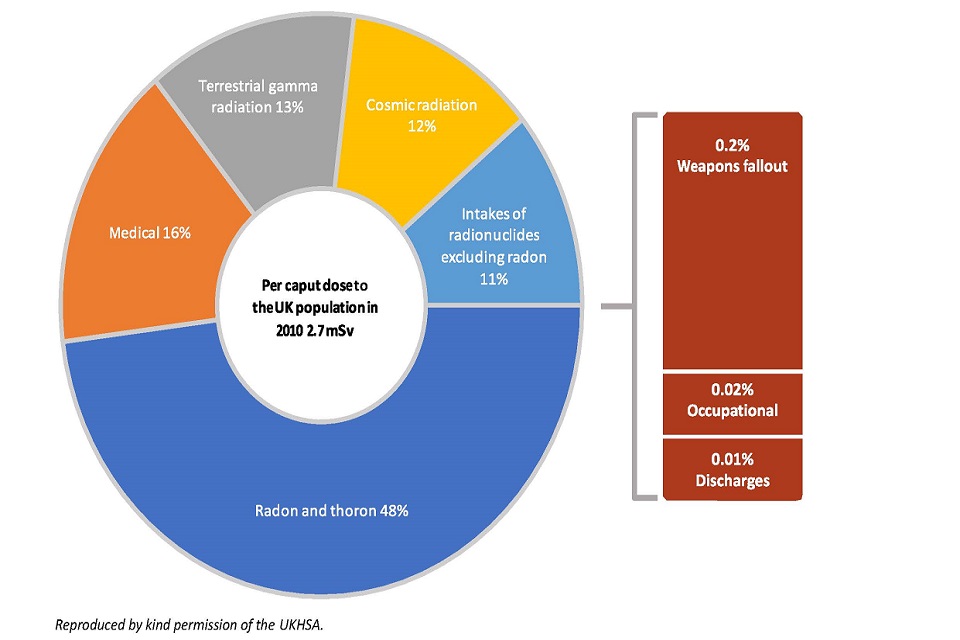
3. Radioactive and Non-radioactive Discharges and Disposals
Operations at Sellafield
Sellafield is the most complex nuclear site in the UK, home to the Thermal Oxide Reprocessing plant (Thorp) and Magnox Reprocessing plants and a wide range of waste management and effluent treatment facilities.
Reprocessing operations completed in July 2022 hence the emphasis is shifting to remediation, decommissioning and clean-up of the historical legacy.
During reprocessing operations, some effluents containing a small fraction of the radioactivity originally present in the used fuel are discharged to the sea and atmosphere or disposed of as solid wastes to the Low-Level Waste Repository (LLWR) near Drigg.
Discharges of radioactivity to sea have declined significantly since the 1970s as a result of considerable investments and improvements in effluent treatment plants that have been described in previous reports in this series.
Since 1990, a number of plants that encapsulate solid intermediate-level radioactive waste in stainless steel drums have been, and continue to be, brought online.
Sellafield also operates the Waste Vitrification Plant (WVP) which converts both historical and current arisings of liquid high-level waste into a form of glass. The molten glass is allowed to solidify inside stainless steel containers, which are then placed in a specially designed, self-cooling storage facility.
The Solvent Treatment Plant (STP), which was commissioned in 2002, treats arisings of solvent as well as historical solvent wastes currently stored at Sellafield.
Magnox reprocessing throughput in 2021 was 140 te slightly lower than in 2020 (160 te). Decommissioning work on older Magnox plants continued throughout the year.
Thorp reprocessing ceased in November 2018 therefore throughput in 2021 was zero.
Radioactive liquid discharges via the pipeline
Radioactive liquid effluents arise from fuel reprocessing and storage operations, on-site decommissioning operations, and Sellafield Ltd and National Nuclear Laboratory (NNL) laboratories.
Liquors from the reprocessing plants that contain the highest levels of activity are routed directly to storage, pending incorporation into solid glass form in the Waste Vitrification Plant; they are not therefore discharged from the site.
Where practicable, the medium active waste streams from reprocessing are routed via the Medium Active Evaporator, or the Salt Evaporator, to interim decay storage pending treatment in the Enhanced Actinide Removal Plant (EARP) prior to discharge. Where this is not possible, the effluents are routed directly to EARP or other plants for treatment prior to discharge.
The remaining low-level liquid effluents are discharged to sea, after monitoring, via the Sellafield pipeline. The main sources of such effluents are:
- Storage pond water from the old Magnox decanning plants and the Fuel Handling Plant (FHP). This water is treated in the Site Ion-Exchange Effluent Plant (SIXEP) to remove radioactive contaminants, principally caesium-137 and strontium-90
- Storage pond water from Thorp
- Enhanced Actinide Removal Plant (EARP) bulk discharges, consisting of treated Magnox effluents and some effluents from Thorp and ‘EARP concentrate’ discharges, consisting of treated batches of effluent from interim storage and other concentrates
- Remaining process liquors are routed to the Segregated Effluent Treatment Plant (SETP) where effluent is adjusted for pH and held for confirmation of its composition prior to discharge. Three discharge tanks are in operation, permitting flexible effluent management and the extended retention of effluent if required
- Minor waste streams, such as surface drainage water and laundry effluent
The RSA environmental permit includes tiered site limits for aqueous effluents with rolling 12-month limits and quarterly notification levels for ‘total alpha’ and ‘total beta’ activity as well as for individual radionuclides.
In addition, the permit places annual notification levels on individual radionuclides on an individual plant basis. They are referred to as plant notification levels. For this report, only performance against the site limits is considered (noting whether the limit was in force at the upper or lower level for the period).
To comply with the permit, samples from each waste stream are analysed either daily (Thorp Receipt and Storage, SIXEP, laundry, surface drainage water) or prior to discharge (SETP, EARP bulks and concentrates) for ‘total alpha’ and ‘total beta’.
More detailed analyses for a wide range of radionuclides, including all those listed in the permit, are carried out on monthly or quarterly bulks of daily samples.
Data on discharges over the last 5 years are given in table 1 and provides a basis for comparison with current permitted limits.
All discharges during 2021 were within those limits. The discharges of actinides (and hence of ‘total alpha’) in 2021 were marginally lower than 2020 and have remained below 0.25 TBq since 2005.
Trends in liquid effluent discharges between 1990 and 2021 from the Sellafield pipeline for radionuclides that contribute to the largest proportions of the marine critical group dose are illustrated in figures 1 and 2.
Maximum annual discharges of plutonium-alpha and americium-241 occurred in 1973 (65 TBq) and 1974 (120 TBq) respectively. The 2021 annual discharges are orders of magnitude lower than peak discharge rates in 1993 (table 1, figures 1 and 2).
Radioactive liquid discharges via the factory sewer
The factory sewer discharges into the River Ehen just above the confluence with the River Calder. The primary source of the effluent is treated sewage and surface water drainage from areas of the Sellafield site to the north of the River Calder.
This water may contain trace amounts of radioactivity and therefore discharges are included in the environmental permit for radioactive substances for the Sellafield site.
Total quantities of radioactivity discharged over the last 5 years and current permitted limits are shown in table 2.
All discharges during 2021 were within permitted limits. Compared to 2020, discharges of total alpha and tritium decreased, and total beta increased.
In March 2015 the Calder interceptor sewer was included in the site permit. Radioactive discharges during 2021 from this route are shown in table 2.
Radioactive aerial discharges
Aerial effluents are discharged from a number of stacks (chimneys) on the Sellafield site. They mainly consist of ventilation air from the process plants.
Their radioactive constituents comprise of noble gases (e.g. krypton), other gases and vapours (e.g. hydrogen, water vapour, iodine and carbon dioxide) and suspended particulates.
Most release points are monitored continuously and fitted with appropriate abatement equipment, such as high efficiency particulate air filters or scrubbers.
The Radioactive Substances Regulation environmental permit includes tiered site limits for aerial effluent discharges with rolling 12-month limits and quarterly notification levels for ‘total alpha’ and ‘total beta’ activity as well as for individual radionuclides.
In addition, the permit places annual notification levels on individual radionuclides on an individual plant (individual stack) basis. These are referred to as plant notification levels.
The individual radionuclide stack discharges are summed to produce the total site discharge for comparison with the site limits. In this report, only performance against the site limits is presented (noting whether the limit was in force at the upper or lower level for period).
Discharges of radioactivity to the atmosphere also take place from open fuel storage ponds and other approved outlets (OFSPs and OOs). These are largely associated with the re-suspension of radioactivity from open fuel storage ponds and other approved places.
As in previous years, releases in 2021 from OFSPs and OOs were calculated by a methodology agreed with the Environment Agency using data on activity concentrations in air at the site perimeter. These data are included in the total alpha and total beta discharges detailed in table 3.
Discharges for the years 2017 to 2021 are summarised in table 3. The discharges of krypton-85, iodine-129, tritium and carbon-14 generally reflect the reprocessing throughput.
Most of the remaining radionuclides are associated with particulate material and their annual discharges are due to remediation, waste retrievals and storage activities rather than reprocessing.
Figures 3 and 4 shows the annual aerial discharge trends for carbon-14 and iodine-129 since 2000. These trends will be used as a baseline record for future discharges during the post-reprocessing phase of the Sellafield site (Thorp reprocessing ended in 2018 and Magnox reprocessing ended in 2022).
Solid low level radioactive wastes
A number of inter-site transfer authorisations cover the transfer of radioactive waste between Sellafield, the Low-Level Waste Repository (LLWR) and other permitted disposal facilities.
Details of these waste disposals are described below.
Solid low level radioactive waste arises on the Sellafield site from process operations and decommissioning.
Arisings of process wastes have been reduced in recent years to a fairly constant level so that fluctuations in total arisings now mainly reflect decommissioning operations.
The wastes are sent to the LLWR or diverted to other facilities under the LLWR framework under the terms of the environmental permit, which also covers use of the Waste Monitoring and Compaction (WAMAC) facility at Sellafield.
This facility reduces the volume of waste being sent for disposal at the LLWR. It also offers a compaction service to other generators of low-level radioactive waste across the UK. Therefore, the environmental permit (and limits) also includes allowances for the transfer of non- Sellafield Ltd waste from WAMAC to the LLWR.
The Sellafield site seeks to minimise the amount of waste disposed to LLWR by applying the waste management hierarchy and by seeking to utilise other resources through the LLWR framework.
In 2021, 6% of site low level waste was disposed of to LLWR. The remaining 94% was reused/recycled or disposed of 2 other facilities, such as off-site Low-Active Low-Level Waste (LA-LLW) facilities.
These routes include on-site disposal to the Calder Landfill Extension Segregated Area (CLESA) in addition to disposals to off-site specified landfills, metals recycling facilities, and thermal treatment facilities.
Routing of wastes to these facilities is carried out in accordance with a Best Available Techniques (BAT) decision tree, with disposal to LLWR always the last resort. Low level radioactive and non-radioactive waste arisings from Sellafield for 2017 to 2021 are presented in table 4.
Historically, contaminated soil arising at Sellafield from construction and excavation was disposed of at permitted landfill sites on the Sellafield site.
Only one of these sites, CLESA, is now permitted. The previous landfill sites are now in closure and aftercare status. CLESA received 3,100 m³ in 2021.
These disposals are included in the site’s environmental permit, which includes a specific activity limit of 200 Bq g-1, above which waste has to be disposed of at the LLWR as low-level radioactive waste.
Disposals made under the terms of Waste Disposal or Waste Management Licences
Radioactive wastes (including hazardous radioactive wastes) were historically disposed to the LLWR, now managed by Nuclear Waste Services Ltd.
CLESA is permitted to take a range of very low-level radioactive wastes (VLLW)/low active– low level waste (LA-LLW), such as concrete, soil and stones with a specific activity limit of 200 Bq g (-1).
Other LA-LLW and VLLW wastes (including hazardous wastes) are sent to off-site specified facilities.
Where appropriate, some wastes arising on the site from both radiologically controlled areas and “non-active” areas, are carefully monitored and assessed (for example via intrusive sampling) to confirm that they are not radioactive.
These activities are carried out in accordance with the UK Nuclear Industry Guide (1). Such wastes are ‘out of scope’ under the Environmental Permitting Regulations.
All wastes assessed as ‘out of scope’ under the Environmental Permitting Regulations 2016, as well as wastes deemed to be clean, are sent for disposal off-site as controlled wastes (paragraph 31).
Non-radioactive liquid and aerial discharges
Non-radioactive liquid effluent discharges between 2017 and 2021 are summarised in table 5 and include all discharges for which annual mass limits are specified.
Aerial discharges between 2017 and 2021 are summarised in table 6 and 7.
Non-radioactive discharges remained below the installation permit limits for the vast majority of emission points and parameters.
There were confirmed exceedances of the suspended solids limit for the Sewage Treatment Works and Thorp Receipt and Storage cooling tower. These were investigated and action taken to improve the situation.
Ozone depleting substances and fluorinated gases
Sellafield Ltd is committed to minimising the use of ozone depleting substances and fluorinated greenhouse gases and replacing equipment containing them.
Routine releases are estimated from the amounts of refrigerants used to top-up systems on site.
Site releases between 2017 and 2021 of ozone depleting substances and fluorinated greenhouse gases are summarised in table 8.
Carbon dioxide and other greenhouse gases
Discharges of carbon dioxide and methane are mainly from Fellside Combined Heat and Power plant (CHP), which is managed and operated by Sellafield Ltd and its emissions controlled by the Sellafield environmental permit and an emissions trading permit.
Carbon dioxide may also be emitted from standby generators on Sellafield site which also have an emissions trading permit.
In addition, small amounts of carbon dioxide are released from the process plants (table 7). Details of the corporate carbon footprint are provided in a later chapter of this report.
Off-site disposals of solid waste
Non-radioactive (controlled) wastes consisting of, for example concrete, soil and stones, office/canteen or workshop waste (predominantly solid but including sludges and liquids) are disposed of off-site via the Site Waste Management contractor, where possible, using the Waste Management Hierarchy.
Such wastes are reused or recycled where possible. Consideration is given by Sellafield Ltd to avoid the production of the waste in the first instance or whether the waste can be reduced in either classification or volume.
Hazardous waste is usually unable to be reused/recycled, with some exceptions (e.g. fluorescent tubes, batteries and oil wastes for example), and are normally disposed of to specially licensed disposal facilities.
In 2021, 3.1% of Sellafield inert, non-hazardous and 9.2% of hazardous waste was reused or recycled (table 9).
The general increase in solid waste arisings in 2021 is due to increased activities on site as impacts of the COVID-19 pandemic were less severe than those experienced in 2020.
Natural resources
Annual quantities of some natural resources used at the Sellafield site between 2017 and 2021 are given in table 10.
Electricity is primarily generated at the Combined Heat and Power (CHP) Plant situated adjacent to the site. Electricity consumption for Sellafield operations in total has been relatively stable over this time (approximately 260,000 to 300,000 MWh).
Steam is also generated at the CHP Plant in the form of high pressure (HP) or low pressure (LP) supply.
Steam consumption varies with operational demands. LP steam in particular varies with fluctuating weather conditions.
Fresh water, which is abstracted under licence from the Environment Agency, is distributed as untreated and treated (potable and demineralised) and is consumed in operations and for staff welfare.
Electricity and steam consumption has been consistent over the last 5 years, whereas water demands in 2021 were at their lowest in 5 years. Measures are in place to continually improve natural resource consumption efficiencies.
Summary
There were no instances in 2021 of non-compliance with the numerical limits of permits regulating discharges and disposals of radioactive wastes at Sellafield.
Radioactive discharges (aerial and liquid) were generally lower than those in 2020 and were well below the permitted limits.
There were breaches in 2021 under the environmental permit for the Sellafield Part A Installation and Large Combustion Plant Permit. The Environment Agency was notified, and action was taken to improve the situation.
Reference
- NISDF (2017). The UK Nuclear Industry Guide to: Clearance and Radiological Sentencing: Principles, Process and Practices. Nuclear Industry Safety Director’s Forum, pp187.
Table 1. Radioactive discharges to the Irish Sea via the pipeline, 2017 - 2021
| Radionuclides | Annual discharge (TBq) 2017 | Annual discharge (TBq) 2018 | Annual discharge (TBq) 2019 | Annual discharge (TBq) 2020 | Annual discharge (TBq) 2021 | Authorised Limits |
|---|---|---|---|---|---|---|
| Tritium | 1,300 | 1,300 | 420 | 190 | 180 | 3,000b |
| Carbon-14 | 3.6 | 2.9 | 2.8 | 1.2 | 1.3 | 13b |
| Cobalt-60 | 0.02 | 0.02 | 0.02 | 0.02 | 0.01 | 2.5 |
| Zinc-65 | 0.007 | 0.007 | 0.005 | 0.003 | - | - |
| Strontium-90 | 2.1 | 1.3 | 1.2 | 1.4 | 2.4 | 14 |
| Zirconium-95 | 0.04 | 0.03 | 0.03 | 0.03 | - | - |
| Niobium-95 | 0.03 | 0.03 | 0.02 | - | - | - |
| Technetium-99 | 1.6 | 0.93 | 0.94 | 0.62 | 0.48 | 7.5 (b) |
| Ruthenium-106 | 1.0 | 0.54 | 0.46 | 0.27 | 0.17 | 3.1 |
| Antimony-125 | 1.0 | 0.38 | 0.21 | 0.21 | - | - |
| Iodine-129 | 0.26 | 0.30 | 0.04 | 0.03 | 0.02 | 0.32 |
| Caesium-134 | 0.04 | 0.04 | 0.02 | 0.03 | - | - |
| Caesium-137 | 3.3 | 4.4 | 1.6 | 2.5 | 1.4 | 17 |
| Cerium-144 | 0.12 | 0.09 | 0.07 | 0.07 | - | - |
| Europium-152 | 0.03 | 0.03 | - | - | - | - |
| Europium-154 | 0.006 | 0.006 | - | - | - | - |
| Europium-155 | 0.006 | 0.006 | - | - | - | - |
| Neptunium-237 | 0.04 | 0.05 | 0.03 | 0.02 | - | - |
| Plutonium-alpha | 0.15 | 0.14 | 0.11 | 0.10 | 0.08 | 0.29 |
| Plutonium-241 | 2.1 | 1.9 | 1.2 | 1.1 | 0.83 | 6 |
| Americium-241 | 0.02 | 0.02 | 0.02 | 0.01 | 0.01 | 0.14 |
| Curium-243+244 | 0.002 | 0.001 | 0.001 | 0.0007 | - | - |
| Total alpha (a) | 0.18 | 0.16 | 0.13 | 0.12 | 0.09 | 0.34 |
| Total beta (a) | - | - | 6.8 | 7.1 | 7.4 | 63 |
| Uranium (kg) | 350 | 310 | 260 | 180 | 130 | - |
a. ‘Total alpha’ and ‘Total beta’ are control measures relating to specified analytical determinations. They do not reproduce precisely the contributions from all individual isotopes.
b. Upper limit of authorised limit in force until the completion of Magnox reprocessing.
Table 2. Radioactive discharges to the Irish Sea via the Factory Sewer and Calder Interceptor Sewer, 2017 - 2021
| Radionuclides | Annual discharge (TBq) 2017 | Annual discharge (TBq) 2018 | Annual discharge (TBq) 2019 | Annual discharge (TBq) 2020 | Annual discharge (TBq) 2021 | Plant Notification Level |
|---|---|---|---|---|---|---|
| Factory Sewer - total alpha | 0.12 | 0.09 | 0.13 | 0.15 | 0.07 | 0.15 |
| Factory Sewer - total beta | -3.5 | 3.4 | 4.2 | 5.1 | 5.9 | 7.0 |
| Factory Sewer - Tritium | 6.4 | 7.3 | 11 | 12 | 9.0 | 10 |
| Calder Interceptor Sewer - total alpha | - | 0.0056 | 0.0055 | - | 0.028 | 0.1 |
| Calder Interceptor Sewer - total beta | - | 0.045 | 0.040 | - | 0.23 | 1 |
| Calder Interceptor Sewer - Tritium | - | 0.64 | 0.24 | - | 2.1 | 10 |
Table 3. Total airborne radioactive discharges, 2017 - 2021
| Radionuclides | Annual discharge (TBq) 2017 | Annual discharge (TBq) 2018 | Annual discharge (TBq) 2019 | Annual discharge (TBq) 2020 | Annual discharge (TBq) 2021 | Authorised Limits (all sources) |
|---|---|---|---|---|---|---|
| Tritium | 99 | 90 | 56 | 38 | 39 | 370 (a) |
| Carbon-14 | 0.42 | 0.43 | 0.25 | 0.13 | 0.07 | 2.3 (a) |
| Krypton-85 | 43,000 | 65,000 | 7,800 | 4,300 | 4,300 | 70,000(a) |
| Radionuclides | Annual discharge (GBq) 2017 | Annual discharge (GBq) 2018 | Annual discharge (GBq) 2019 | Annual discharge (GBq) 2020 | Annual discharge (GBq) 2021 | |
|---|---|---|---|---|---|---|
| Strontium-90 | 0.03 | 0.01 | 0.009 | 0.01 | 0.004 | 0.50 (b) |
| Ruthenium-106 | 0.65 | 0.49 | 0.56 | 0.55 | 0.55 | 2.8 |
| Antimony-125 | 1.7 | 1.3 | 1.5 | 1.1 | 0.53 | 30 (a) |
| Iodine-129 | 6.5 | 10 | 3.2 | 2.1 | 1.8 | 42 (a) |
| Iodine-131 | 0.37 | 0.39 | 0.23 | 0.12 | - | - |
| Caesium-137 | 0.04 | 0.05 | 0.07 | 0.08 | 0.05 | 4.8 (b) |
| Plutonium-alpha | 0.03 | 0.03 | 0.01 | 0.01 | 0.009 | 0.13 (b) |
| Plutonium-241 | 0.33 | 0.23 | 0.10 | 0.09 | - | - |
| Americium-241 + Curium-242 | 0.02 | 0.02 | 0.01 | 0.01 | 0.009 | 0.08 (b) |
| Total alpha | 0.11 | 0.10 | 0.08 | 0.10 | 0.07 | 0.66 (b) |
| Total beta | 0.78 | 0.66 | 0.64 | 0.74 | 0.70 | 32 (b) |
a. Upper limit of authorised limit in force until the completion of Magnox reprocessing. b. Upper limit of authorised limit in force until the completion of the active commissioning of HEPA filtration in the Magnox Swarf Storage Silo stack.
Table 4. Solid low level waste arisings from Sellafield, 2017 - 2021
| Low level waste (LLW) arisings (m3) | 2017 | 2018 | 2019 | 2020 | 2021 |
|---|---|---|---|---|---|
| LLW produced on site which has been reused, recycled or disposed of | 11,000 | 9,000 | 9,400 | 5,100 | 12,000 |
| LLW metal waste recycled | 2,000 | 3,100 | 2,900 | 1,700 | 140 |
| Combustible LLW treated | 2,100 | 2,200 | 2,100 | 2,500 | 2,100 |
| LLW disposed of directly to landfill (as LLW, high volume - very low level waste or exempt waste but excluding waste that is out of scope of regulation) | 1,600 | 580 | 850 | 210 | 400 |
| LLW disposed of on-site | 4,000 | 2,300 | 3,100 | 600 | 9,300 |
| Volume of LLW disposed of at LLWR | 1,300ᵃ | 880ᵃ | 520 (a) | 80 | 300 |
a. Volume now includes volume of compactable LLW
Table 5. Non-radioactive liquid effluent discharges (kg), 2017 - 2021
| Substance | Release points | 2017 | 2018 | 2019 | 2020 | 2021 | Annual Limit (a) |
|---|---|---|---|---|---|---|---|
| Mercury | SETP, SIXEP, EARP, Laundry, Inactive Tank Farm Neutralising Pit, Thorp-C14 Removal Plant, Water Treatment Plant | 0.04 | 0.03 | - | - | 0.03 | - |
| Chromium | SIXEP, SETP, EARP | 120 | 40 | 5.6 | 14 | 4.1 | 1,200 |
| N as NO2 and NO3 | SETP, EARP | 1,000,000 | 1,000,000 | 1,000,000 | 410,000 | 590,000 | 4,080,000 |
| N as NO2 and NO3 | Thorp-C14 Removal Plant | 3,600 | 4,600 | 420 | 110 | 260 | 26,900 |
| Glycol | SETP, SIXEP, EARP, Lagoon | 2,500 | 1,500 | 7,600 | 2,000 | 3,400 | 12,000 |
a. Annual mass limits reported under the Installations environmental permit.
Table 6. Non-radioactive aerial effluent discharges (kg), 2017 - 2021
| Substance | Release points | 2017 | 2018 | 2019 | 2020 | 2021 | Annual Limit (a) |
|---|---|---|---|---|---|---|---|
| Oxides of nitrogen (as NO2) | Vitrification Test Rig | 29 | 33 | 40 | 43 | 48 | 1,000 |
| Oxides of nitrogen (as NO2) | NNL Central Laboratory | 11 | 14 | 11 | 5.4 | 7.3 | 500 |
| Particulate matter | Fellside CHP (as PM10) | 410 | 360 | 230 | 190 | 160 | - |
a. Annual mass limits reported under the Installations environmental permit.
Table 7. Non-radioactive aerial effluent discharges (tonne), 2017 – 2021ᵃ
| Substance | Release points (b) | 2017 | 2018 | 2019 | 2020 | 2021 |
|---|---|---|---|---|---|---|
| Oxides of nitrogen (as NO2) | Site total | 420 | 330 | 250 | 180 | 83 |
| Carbon dioxide | Site total | 360,000 | 320,000 | 260,000 | 260,000 | 137,000 |
| Carbon monoxide (c) | Site total | 36 | 42 | 0.03 | 17 | 6.94 |
| Non-Methane Volatile organic compounds (NMVOCs) | Site total | 60 | 63 | 32 | 23 | 23 |
| Methane | Site total | 18 | 17 | 0.01 | 14 | 10 |
a. No annual limits apply. b. Site Total includes Fellside CHP plant. c. EA agreed reporting value as carbon monoxide discharges significantly below reporting threshold (BRT) values.
Table 8. Discharges of ozone depleting substances and fluorinated greenhouse gases (kg), 2017 - 2021
| Substance (a) | 2017 | 2018 | 2019 | 2020 | 2021 |
|---|---|---|---|---|---|
| R22 HCFC | - | - | 4 | - | - |
| R134A HFC | 110 | 70 | 1000 | 320 | 203 |
| R407C HFC | 43 | 19 | 50 | 100 | 70 |
| R404A HFC | 33 | 5.3 | 3.6 | - | 7 |
| R410A HFC | 57 | 12 | 82 | 42 | 56 |
a. HCFCs are ozone depleting substances and HFCs are fluorinated greenhouse gases.
Note: the range of substances discharged varies each year depending on which equipment is topped up with refrigerants. No annual mass limits apply.
Table 9. Non-radioactive solid waste arisings from Sellafield, 2017 - 2021
| Non-Radioactive Waste Arisings (te) | 2017 | 2018 | 2019 | 2020 | 2021 | |
|---|---|---|---|---|---|---|
| Non-Hazardous Waste Arisings | Non-hazardous waste produced on site | 63,000 | 38,000 | 92,000 | 43,000 | 22,000 |
| Non-Hazardous Waste Arisings | Non-hazardous waste reused or recycled | 39,000 | 9,300 | 2,800 | 30,000 | 21,000 |
| Non-Hazardous Waste Arisings | % of non-hazardous waste reused or recycled | 62 % | 24 % | 3.1 % | 69% | 94% |
| Hazardous Waste Arisings | Hazardous waste produced on site | 1,300 | 1,200 | 1,100 | 2,900 | 1,700 |
| Hazardous Waste Arisings | Hazardous waste reused or recycled | 190 | 500 | 99 | 170 | 290 |
| Hazardous Waste Arisings | % of hazardous waste reused or recycled | 14 % | 42 % | 9.2 % | 5.8% | 17% |
Whilst every effort is made to centrally record all non-Rad waste arisings, some sub-contractors may not provide this information, so the actual quantity produced may be higher than the centrally recorded figure. No annual mass limits apply.
Table 10. Summary of natural resources used at the Sellafield site, 2017 - 2021
| Resource | 2017 | 2018 | 2019 | 2020 | 2021 |
|---|---|---|---|---|---|
| Electricity (MWh) | 300,000 | 300,000 | 290,000 | 280,000 | 260,000 |
| Water (tonnes) | 7,200,000 | 7,100,000 | 6,200,000 | 4,900,000 | 5,000,000 |
| High Pressure Steam (tonnes) | 380,000 | 360,000 | 350,000 | 240,000 | 220,000 |
| Low Pressure Steam (tonnes) | 240,000 | 220,000 | 260,000 | 240,000 | 220,000 |
No annual mass limits apply.
Figure 1. Pu-alpha discharge from marine pipeline and concentration in winkles, mussels and Nephrops
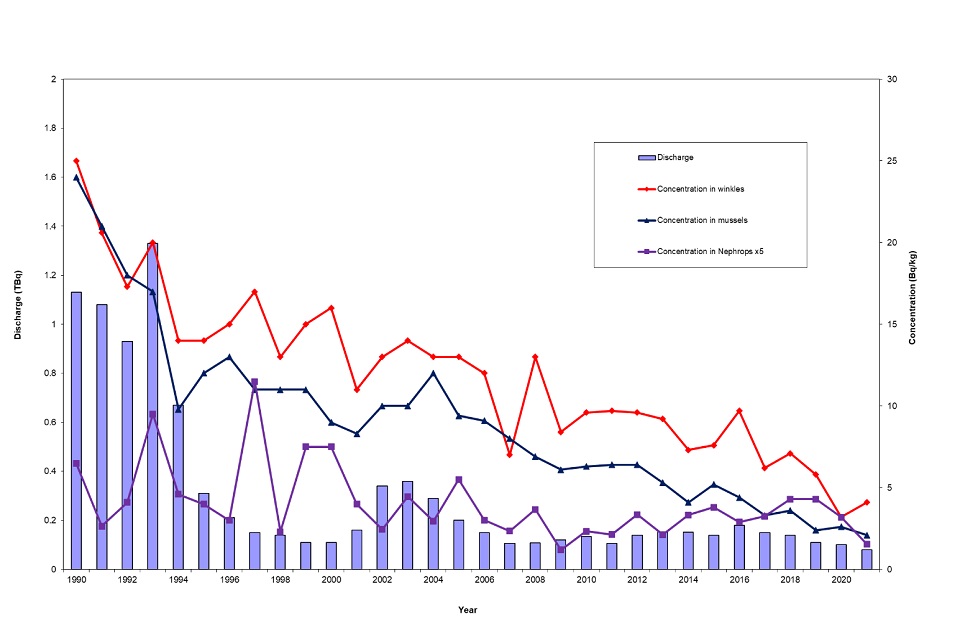
Figure 2. Am-241 discharge from marine pipeline and concentration in winkles, mussels and Nephrops
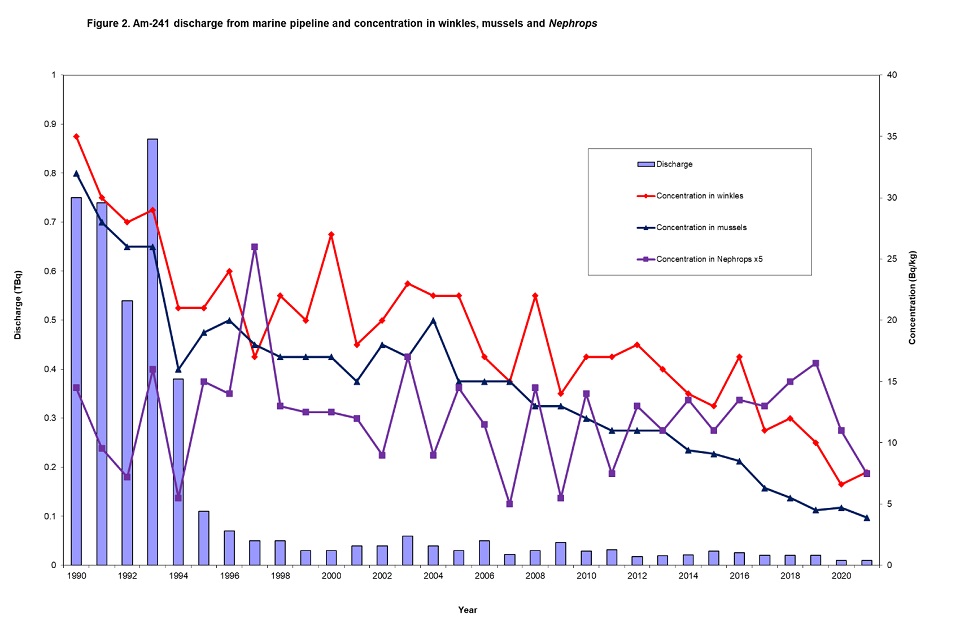
Figure 3. Annual aerial discharges of Carbon-14 (TBq)
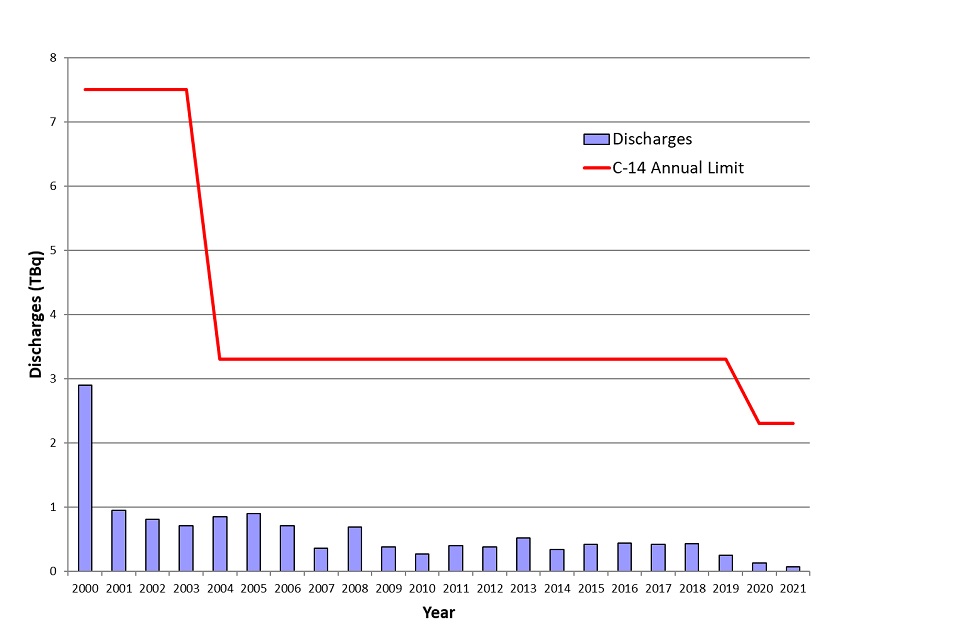
Figure 4. Annual aerial discharges of Iodine-129 (GBq)
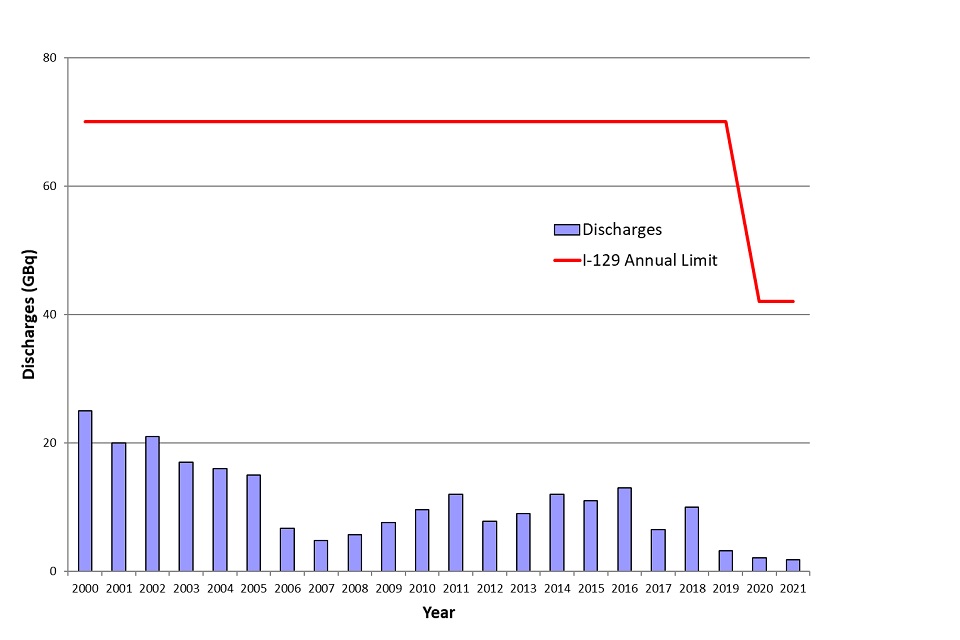
4. Radiological and Non-radiological Monitoring of the Environment
Environmental Monitoring
The results of the Sellafield Ltd environmental monitoring programme (SEMP) for 2021 are presented within this report alongside supplementary data, for foodstuffs and radionuclides pertinent to dose calculations, published by the Food Standards Agency (FSA) (tables 11 and 12).
Further background information relating to analytical measurements, limit of detection and rounding of data is given in the Introduction. Detailed data from the monitoring programme are presented in Appendix B.
The main pathways identified by Sellafield Ltd, the Environment Agency (EA) and FSA as relevant to calculating critical group doses attributable to radioactive discharges from Sellafield are:
- Internal exposure from the high-rate consumption of seafood (particularly crustaceans and shellfish) and of local agricultural produce
- External gamma radiation from exposed intertidal sediments, particularly the silts and muds of estuaries and harbours
- Inhalation of, and exposure to, airborne radioactivity
The habits and consumption rates relating to each pathway are kept under regular review (1,2,3). The SEMP, as supplemented by data from the EA and FSA monitoring programmes, reflects these pathways.
In addition to pathways of radiation exposure, the monitoring programme also includes the analysis of ‘indicators’. These are usually biological materials which accumulate radioactivity and therefore are more likely to produce positive analytical results and provide trends in environmental concentrations; examples are grass and seaweed.
Concentrations of radioactivity in the marine environment reflect discharges from the Sellafield pipelines, whereas radioactivity in the terrestrial environment generally reflects discharges to atmosphere.
Some overlap does occur however, with sea to land transfer processes (4,5) and on tidally inundated pastures (6). Concentrations of caesium-137, plutonium and americium-241 in most environmental materials are predominantly as a consequence of historical discharges between 1968 and 1984.
Marine pathways
The extent of the marine environmental monitoring programme is illustrated in figure 1. Samples are regularly collected from the Cumbrian coast. The precise locations are reviewed periodically.
In certain cases, additional samples are obtained through commercial suppliers, representing foodstuffs available for general consumption.
Foodstuffs
The concentrations of radionuclides in the edible parts of fish, molluscs and crustaceans from the Sellafield Area are given in tables 1, 2 and 3 and summarised in table 4.
Trends in seafood generally reflect the annual discharges from the pipeline (see Discharges and Disposals chapter) and as such were generally similar to those in recent years.
Plutonium-alpha and americium-241 concentrations in mussels and winkles were similar to 2020.
Data for carbon-14 presented in tables 1 to 4 are not corrected for the levels which are present naturally (7). However, background corrected values for carbon-14 in fish, molluscs and crustaceans have been used in the assessment of radiation doses to critical groups.
For these marine foodstuffs, the natural concentration of carbon-14 of 218 Bq carbon-14 per kg carbon has been taken from data published by the EA and FSA (1).
Indicators
Seaweeds are useful marine indicators. Fucus vesiculosus is collected because it accumulates many radionuclides (particularly technetium-99) and is sensitive to fluctuations in their concentrations in seawater.
Thus, the reduction in discharges from 2002 onwards was soon reflected in the levels in this species (Appendix B). Porphyra umbilicalis is also collected and monitored as an indicator species due to its historical exposure pathway role for ruthenium-106.
Seawater and sediments
Sellafield Ltd routinely collects samples of seawater from the shore at locations close to Sellafield.
Concentrations of radioactivity in seawater were broadly similar to those of recent years. Specific examples of concentration trends in seawater filtrate from 2000 are given for caesium-137 and plutonium- alpha at Sellafield beach in Appendix B.
A gradual decrease over time is observed for caesium-137 whereas plutonium-alpha has remained at a consistently low level over this time period despite there being an increase in plutonium-alpha discharges between 2002 and 2004 due to increased pond water activity concentrations in the Fuel Handling Plant.
Concentrations of radioactivity in sediments were generally similar to those of recent years (Appendix B). Redistribution of sub-surface sediments may have led to small fluctuations in radionuclide concentrations.
External pathways
Gamma dose rate surveys are carried out in the areas most often frequented by members of the public (table 5).
Particular attention is paid to areas where silt or mud accumulates, such as in harbours or estuaries, where dose rates tend to be higher because of the presence of finely divided sediments. Several measurements are made in each area allowing temporal and geographical trends to be observed.
The gradual decline in external gamma dose rates at Newbiggin saltmarsh between 1993 and 2021 is shown in Appendix B, figure B4.
This decline is consistent with the decline in activity concentrations of cobalt-60, ruthenium-106 and caesium-137 reported in Newbiggin sediment (due to a combination of discharge trends and radioactive decay).
The major external gamma dose rate contributor is caesium-137 and the external gamma dose rates decrease according to its half-life (30.1 years) combined with potential burial rates due to sediment accretion.
Gamma dose rate surveys are also conducted around the site perimeter and the surrounding district (tables 6 and 7). In general, dose rates are declining towards background levels.
Airborne and terrestrial pathways
The extent of the terrestrial environmental monitoring programme is illustrated in figure 2.
Airborne
High volume air sampling equipment, located close to the site perimeter (table 8) and in nearby centres of population (table 9), is used to sample airborne particulates for radiochemical analysis.
Levels off-site were generally below the limit of detection, with most positive values reflecting sea to land transfer from marine discharges.
Total deposition collectors are located in the vicinity of each of the five high volume air samplers close to the site perimeter. Higher activity concentrations for beta-emitters are measured at North Gate, reflecting its close proximity to the open ponds (Appendix B).
Sampling for atmospheric krypton-85 is conducted at the Sellafield Meteorological station on the edge of Sellafield site.
Concentrations averaged 4.5 Bq m-3 with global background accounting for approximately 1.6 Bq m-3 and the discharges from the site accounting for approximately 2.9 Bq m-3.
This is equivalent to an immersion dose due to krypton-85 discharges from Sellafield of 0.03 µSv a-1 for the adult age group.
Foodstuffs and water
Milk is sampled from local farms located within 4 km of the Sellafield site. The average concentrations of radioactivity in milk are summarised in table 10.
The figures include the residual effects of weapons testing and the 1986 Chernobyl reactor accident.
Data for carbon-14 includes the contribution from natural background. However, estimates of effective dose have been made by subtracting natural background levels of carbon-14.
For milk and other terrestrial foodstuffs, vegetation and soil, a background level of 218 Bq carbon-14 per kg carbon is used1.
The milk results for 2021 are broadly similar to, or lower than, those observed for previous years, with many analyses at the limit of detection.
The results of the Sellafield environmental monitoring programme for 2021 are presented alongside supplementary data published by the Food Standards Agency in tables 11 and 12.
The Sellafield Ltd samples were mainly collected from within 4 km of the Sellafield site as they became available throughout the year. Data for carbon-14 are presented as total and net (background subtracted) values (1).
For terrestrial foodstuffs no longer monitored by Sellafield Ltd, natural carbon-14 background concentrations have been taken from data published by the Environment Agency and Food Standards Agency ¹.
For 2021, the consumption of domestic fruit and potatoes have been calculated to be the main contributors to the critical group dose from terrestrial foodstuffs.
Water samples are collected from the River Calder and River Ehen, lakes and domestic supplies.
The results (table 13) are all very low and rarely above the limits of detection, except for strontium-90 which is generally present in rainwater and surface water at levels typical of those throughout the UK1.
The higher strontium-90 concentration in the River Calder at Sellafield is due to the seepage of strontium-90 in groundwater from site to the river.
This transport route is considered within the groundwater assessment of site. The higher concentration of caesium-137 in the River Ehen, 5 metres upstream from the factory sewer is a result of there being seawater present within the river water sample, despite samples being collected at low tide.
Indicators
Grass and soil sampling are included in the monitoring programme as they provide time trend data on environmental concentrations of radioactivity (Appendix B).
Grass samples are collected quarterly from 5 locations on the Sellafield site. Soil samples (5cm cores) are collected annually from the same locations. Concentrations in soil are similar to previous years.
Direct radiation
Some of the older Magnox buildings, including the Calder reactors, have lower levels of radiation shielding than the modern buildings, such as Thorp.
Consequently, it is possible to measure radiation dose rates above natural background at the site perimeter fence. These dose rates were largely due to direct radiation from the unshielded heat exchangers on the Calder reactors and therefore were dependent upon the amount of power being produced by the reactors (until they were shut down in March 2003).
The perimeter radiation levels still show a contribution due to contamination within the heat exchangers but at a much lower level.
Gamma dose rates are monitored continuously and analysed quarterly using thermo luminescent dosimeters (TLDs) at 19 locations around the site perimeter (table 6) and at a further seven locations in the surrounding district (table 7).
Dose rates at the site perimeter averaged 0.08 µSv h-1, significantly lower than when the Calder Hall reactors were fully operational. Dose rates in the surrounding district averaged 0.07 µSv h-1.
These are total dose rates, which include contributions from natural terrestrial background and cosmic rays. For dose assessment purposes the natural contributions are deducted.
Non-radiological monitoring of the environment
The Installations environmental permit includes a requirement for a non-radiological monitoring programme.
Compared to the radiological environmental monitoring programme, its scope is limited and comprises local air sampling on the Sellafield site, water sampling from the rivers Calder and Ehen and seawater sampling from local beaches.
A more comprehensive summary of non-radioactive releases to air, controlled waters, land and off-site transfers of waste is given in the pollution inventory supplied to the Environment Agency each year and is available from their website.
Air sampling
Measurements of nitrogen dioxide concentrations in air are made at 5 locations on the Sellafield site: West Ring Road, Meteorological Station, North Group roundabout, Calder Gate and South Side.
Measurements are made using passive diffusion tubes which are exposed for one month before being analysed. Air sampling results are summarised in table 14.
Water sampling
Water samples are obtained from the rivers Calder and Ehen at locations both upstream and downstream of the site (table 15).
The downstream samples are taken above the confluence of the two rivers, and at times which minimise contamination with seawater. Seawater samples are obtained from the shoreline areas given in table 16.
Monitoring of Sellafield’s landfill sites
The Waste Management Licences for the North Landfill Site and Calder floodplain landfill extensions require that environmental monitoring be carried out in the vicinity of the 2 sites.
The monitoring comprises water sampling from the River Calder and New Mill Beck upstream and downstream of the landfills and gas monitoring over their surfaces. The results are summarised in tables 17 and 18.
Environmental impact of non-radioactive discharges
In this report, the impact of aerial discharges has been addressed (table 14) by comparing the measured environmental concentrations with the most stringent (annual mean) national air quality limit values (9) for nitrogen dioxide.
The interpretation of these results is not straightforward since discharges are made not only from Sellafield but also from other industrial sites in West Cumbria and from natural sources.
The data in table 14 show that the measured concentrations in air on the Sellafield site were all below the air quality limit value.
The results in table 15 and 16 confirm that the liquid discharges from Sellafield are not causing the Environmental Quality Standards (EQS) and Environmental Assessment Levels (EAL) to be exceeded and therefore are of negligible impact.
Environmental monitoring results (table 17 and 18) confirm that the impact of Sellafield’s landfill sites remains negligible. No significant concentrations of carbon dioxide or methane have been measured at these sites.
References
- Environment Agency, Food Standards Agency, Food Standards Scotland, Natural Resources Wales, Northern Ireland Environment Agency and Scottish Environment Protection Agency (2021). Radioactivity in food and the environment, 2020. RIFE-26. EA, FSA, FSS, NRW, NIEA and SEPA; Preston, London, Aberdeen, Cardiff, Belfast and Stirling.
- Food Standards Agency (2010). Radiological Habits Survey: Cumbrian coast beach occupancy, 2009. Environment Report RL 01/10.
- Moore K J, Clyne F J and Greenhill B J (2019). Radiological habits survey: Sellafield, 2018. Environment Report RL07/19. Cefas, Lowestoft (under contract to the EA and the FSA).
- Peirson DH (1988). Artificial radioactivity in Cumbria: A summary of an assessment by measurement and modelling. J. Env. Radioactivity 6: 61-75.
- Howarth JM and Eggleton AEJ (1988). Studies of environmental radioactivity in Cumbria. Part 12: Modelling of sea-to-land transfer of radionuclides and an assessment of the radiological consequences. AERE-R11733, HMSO, London.
- Howard BJ (1987). Cs-137 uptake by sheep grazing tidally inundated and inland pastures near the Sellafield reprocessing plant. In: Coughtrey P J et al (Eds) Pollutant Transport and Fate in Ecosystems, pp 371-383. Blackwell Scientific Publications, Oxford.
- Cook GT and McKenzie AB (1996). Marine background of carbon-14. Project RP/GNSR/5003, Scottish Universities Research and Reactor Centre, East Kilbride.
- Etherington G, Youngman M J, Brown J and Oatway W (2012). Evaluation of the Groundhog Synergy beach monitoring system for detection of alpha-rich objects and implications for the health risks to beach users, HPA- CRCE-038.
- Environment Agency (2010). Horizontal Guidance Note H1- Environmental risk assessment. Environment Agency, Bristol.
Table 1. Radioactivity in fish (Bq kg-1 wet weight), 2021
| Species | Location | Mean radionuclide concentration (Bq kg-1 wet weight) | |||||
|---|---|---|---|---|---|---|---|
| 14Ca | 99Tc | 106Ru | 137Cs | Pu(α) | 241Am | ||
| Cod | Seascale landed | 37 | <0.29 | <0.23 | 3.0 | 0.002 | 0.003 |
| Whitehaven landed | 36 | <0.32 | <0.21 | 2.4 | 0.003 | 0.005 | |
| Plaice | Seascale landed | 43 | 3.4 | <0.25 | 1.5 | 0.006 | 0.007 |
| Whitehaven landed | 41 | 1.1 | <0.25 | 1.3 | 0.003 | 0.006 |
a. (14)C data include natural background
Table 2. Radioactivity in molluscs (Bq kg-1 {wet weight}), 2021
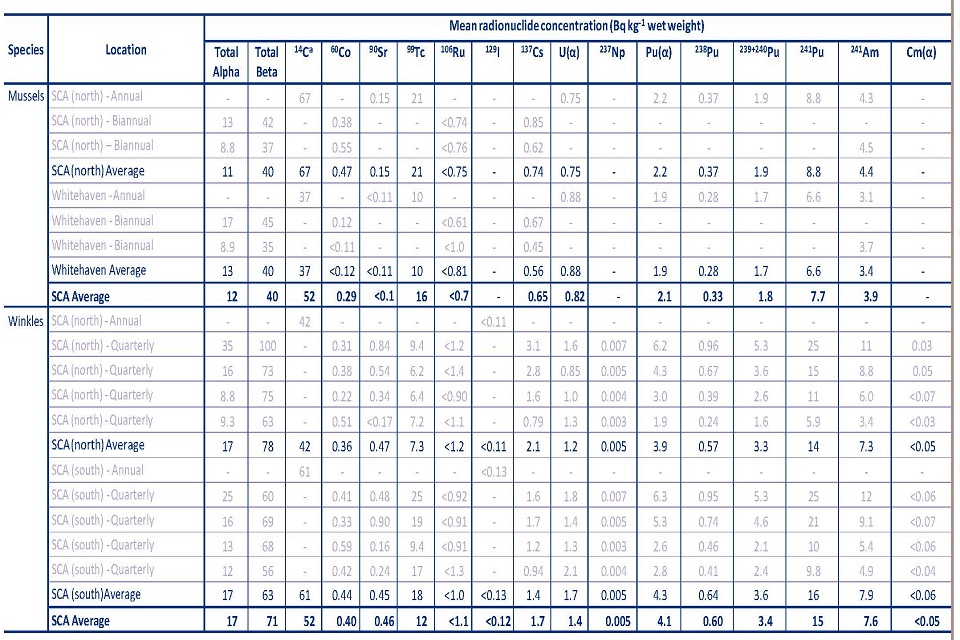
a. 14C data include natural background
SCA - Sellafield coastal area

a. 14C data include natural background; b. No sample available SCA – Sellafield coastal area; WL – Whitehaven Landed
Table 4. Summary of radioactivity in marine seafood (Bq kg-1 {wet weight}), 2021
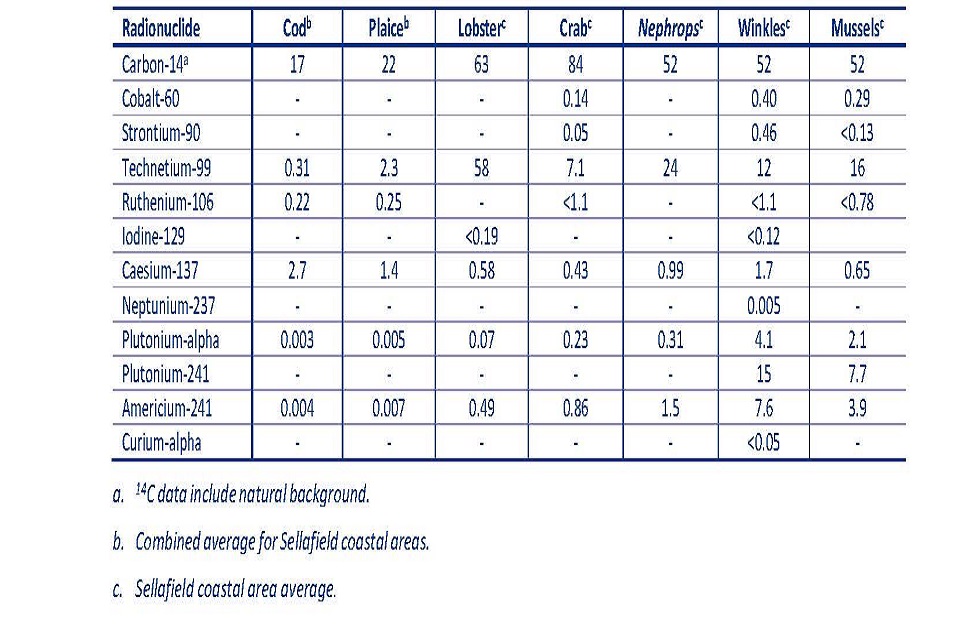
Table 5. Mean gamma dose rates measured in air in intertidal and other coastal areas of Cumbria, 2021

a. Figures include contributions from natural background, typically 0.05 μGy h-1 over sandy areas and 0.07 μGy h-1 over silt.
b. Number of observations
Table 6. Mean gamma dose rates measured in air at Sellafield site perimeter, 2021
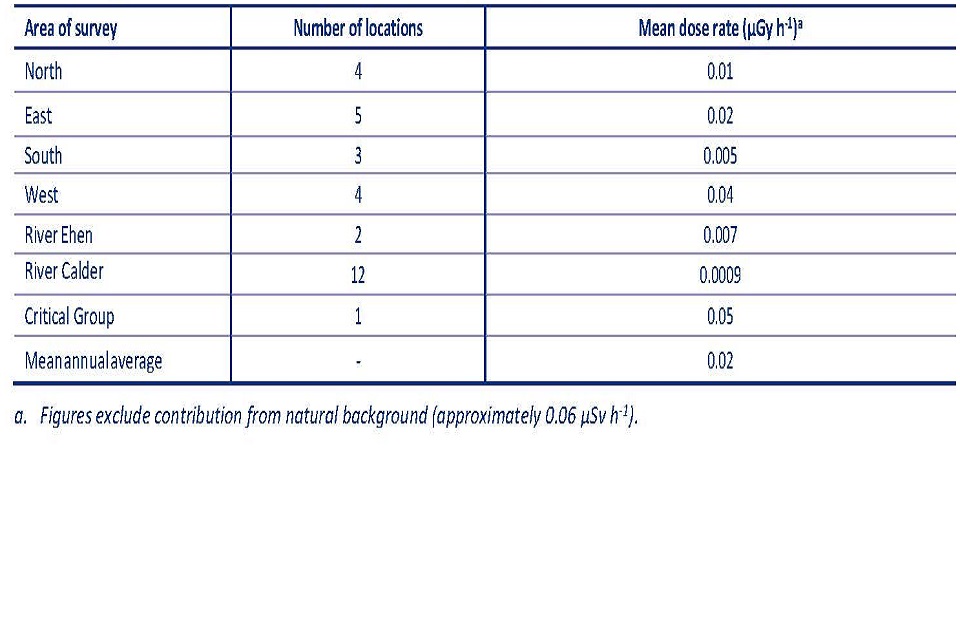
Table 7. Mean gamma dose rates measured in air in the vicinity of Sellafield, 2021
| Location | Mean dose rate (µGy h-1) a |
|---|---|
| Calderbridge | 0.08 |
| Seascale | 0.06 |
| Ravenglass | 0.06 |
| Braystones | 0.07 |
| Whitehaven | 0.05 |
| Gosforth | 0.07 |
| Brow Top | 0.07 |
a. Figures include contribution from natural background (approximately 0.06 μSv h-1).
Table 8. Radioactivity in air in the vicinity of Sellafield - Site Perimeter Locations, 2021
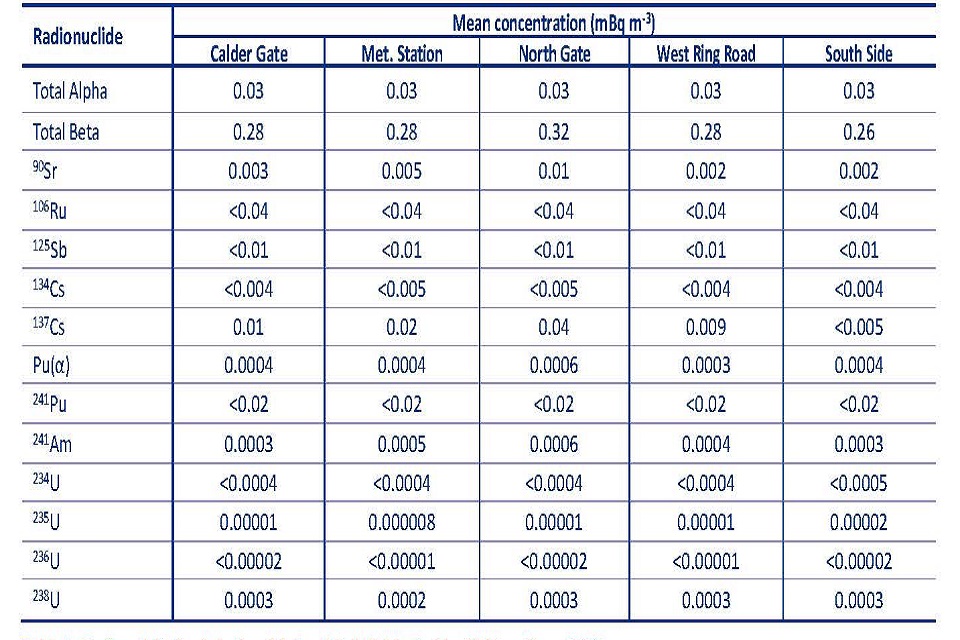
Table 9. Radioactivity in air in the vicinity of Sellafield - Residential Locations, 2021
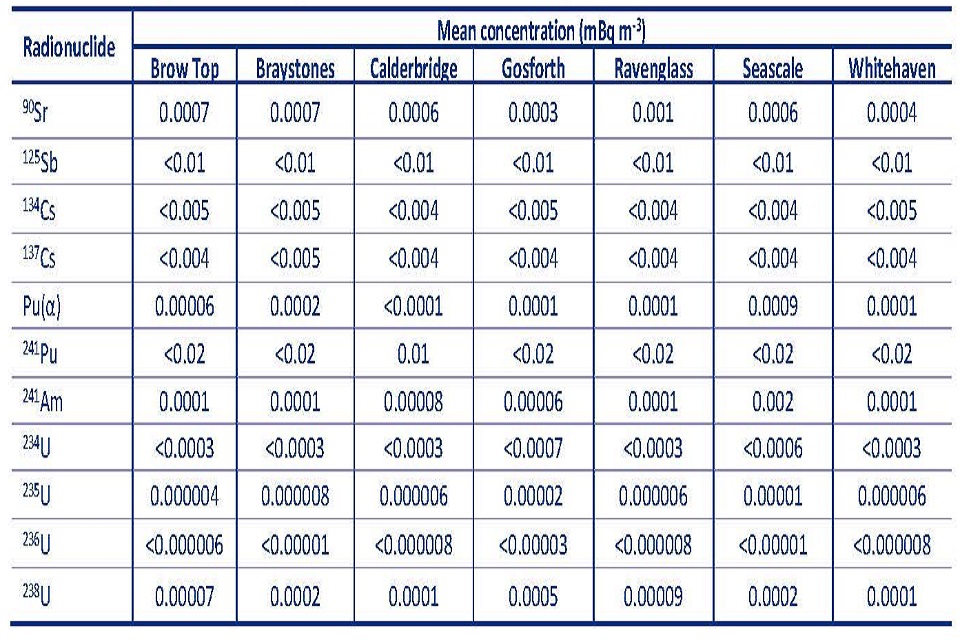
Table 10. Radioactivity in milk from farms near Sellafield, 2021
| Location | Mean concentration (Bq l-1) | ||||||||||
|---|---|---|---|---|---|---|---|---|---|---|---|
| Total α | Total β | 3H | 14Ca | 14Cb | 90Sr | 106Ru | 125Sb | 129I | 131I | 137Cs | |
| Farm A | <0.16 | 40 | <2.3 | 16 | <0.65 | 0.02 | <0.35 | <0.09 | <0.01 | <0.04 | 0.06 |
| Farm B c | <0.13 | 39 | <1.9 | 13 | <0.50 | 0.03 | <0.36 | <0.09 | <0.01 | <0.04 | <0.05 |
| Farm C | <0.17 | 42 | <2.0 | 17 | <0.65 | 0.03 | <0.35 | <0.09 | <0.01 | <0.04 | 0.08 |
a. Including natural background.
b. Excluding natural background.
c. Milk from Farm B has been used in the radiological assessment.
Table 11. Radioactivity in animal produce from farms near Sellafield, 2021
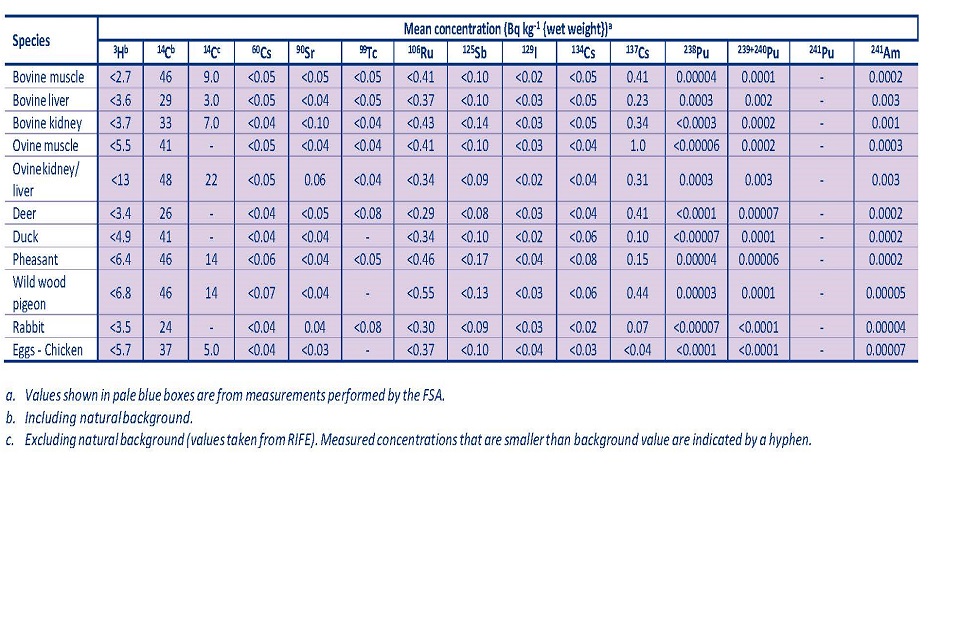
Table 12. Radioactivity in fruit and vegetable produce collected near Sellafield, 2021
Species

Table 13. Radioactivity in local waters, 2021
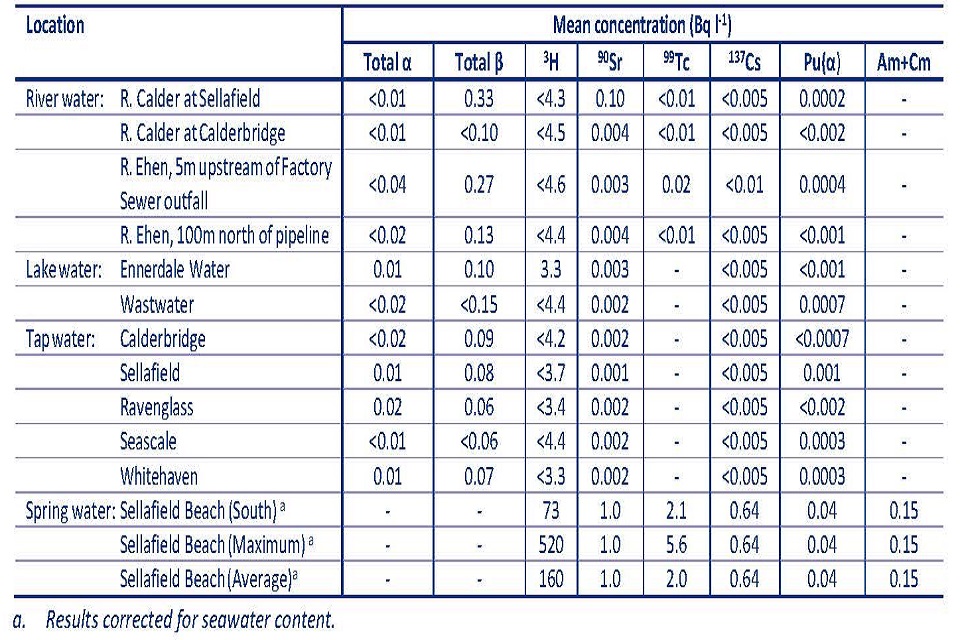
a. Results corrected for seawater content.
Table 14. Non-radioactive monitoring of nitrogen dioxide in air in the vicinity of Sellafield, 2021
| Location | Mean concentration (µg m-3) |
|---|---|
| Calder Gate | 7.6 |
| Met. Station | 5.7 |
| North Gate | 7.4 |
| West Ring Road | 8.1 |
| South Side | 7.5 |
| Air Quality Limit Value (annual mean) | 40 |
Table 15. Non-radioactive monitoring of nitrate in river waters, 2021
| Location | pH Mean concentration (mg l-1) | |
|---|---|---|
| River Calder - downstream of site | 7.9 | 1.4 |
| River Calder - upstream of site | 7.4 | 0.62 |
| River Ehen - upstream of Seaburn outfall | 8.3 | 1.1 |
| River Ehen - upstream of pipebridge | 8.0 | 1.1 |
| National Environmental Quality Standard | 6.0 - 9.0 | N/A |
Table 16. Non-radioactive monitoring of coastal waters, 2021
| Mean concentration (mg l-1) | Mean concentration (mg l-1) | |
|---|---|---|
| Location | nitrite | nitrate |
| St Bees | <0.009 | 0.12 |
| Sellafield | <0.004 | 0.09 |
| Seascale Neb | <0.005 | 0.19 |
| Drigg Barnscar | <0.005 | 0.05 |
Table 17. Non-radioactive monitoring of surface water around Calder Landfill Extension Segregated Area, 2021
| Location | BOD (mg l-1) | COD (mg l-1) | TOC (mg l-1) | Dissolved O2 (ppm) | NH4+ (mg l-1) | SO42- (mg l-1) | Conductivity (µS cm-1) |
|---|---|---|---|---|---|---|---|
| River Calder upstream | <1.0 | 8.8 | 2.7 | 11 | <0.004 | 4.4 | 94 |
| New Mill Beck upstream | <1.2 | 35 | 9.3 | 11 | 0.08 | 11 | 230 |
| New Mill Beck overflow drain (a) | <1.0 | 20 | 12 | 11 | 0.20 | 8.3 | 210 |
| River Calder downstream | <1.0 | 16 | 5.2 | 11 | 0.05 | 5.6 | 130 |
b. Sample only available under flood conditions.
BOD – Biological Oxygen Demand; COD – Chemical Oxygen Demand; TOC – Total Organic Carbon.
Table 18. Non-radioactive monitoring of gases on Sellafield’s landfill sites, 2021
| Gas spike probe monitoring | Mean concentration (% volume) | ||
|---|---|---|---|
| CH4 | CO2 | O2 | |
| Calder Landfill Complex Boreholes | 0.01 | 1.1 | 18 |
| Calder Landfill Complex Probes | 0.0 | 1.4 | 18 |
Figure 1. Marine environmental monitoring around Sellafield

Figure 2. Terrestrial environmental monitoring around Sellafield
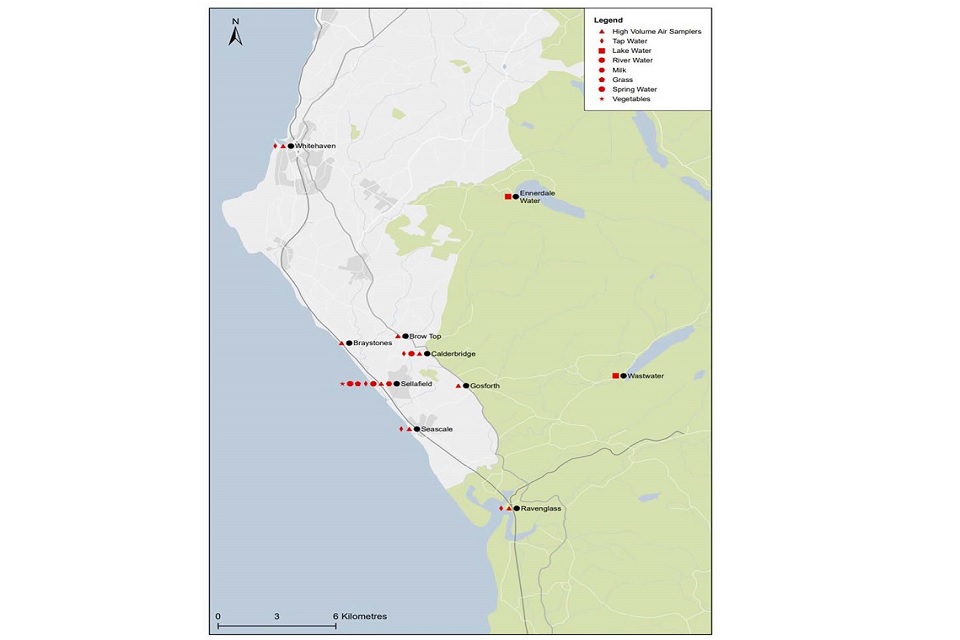
Figure 3. Terrestrial environmental monitoring at Sellafield
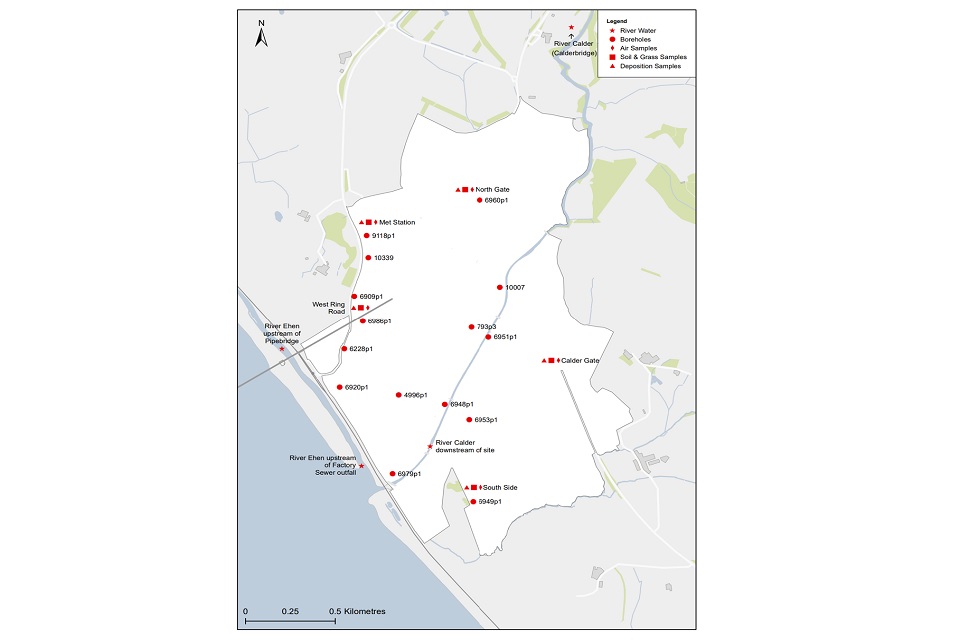
5. Radiological Impact of Operations at Sellafield
Critical group doses
Critical group doses have been calculated applying the Principles for Total Retrospective Dose Assessment (1) as follows:
- Milk dose is based on the mean concentration at a nearby farm with the highest individual result
- The age groups considered for terrestrial critical group dose includes pre-natal (foetal) dose, which has been calculated as an extension to the adult dose assessment using relevant dose coefficients
- Dose per unit intake factors for ingestion and inhalation have been taken from the latest values published by the Environment Agency (EA) and Food Standards Agency (FSA). These factors include the presence of short-lived daughter radionuclides assumed to be in equilibrium with their parent at the time of ingestion, inhalation etc.
- Doses from inhaled and ingested tritium have been assessed using the more conservative dose factor for organically bound tritium, rather than that for tritiated water
Marine pathways
Using habits surveys, the FSA has identified the marine critical group for seafood consumption as a small number of people in the Cumbrian coastal community who are high-rate consumers of fish and shellfish obtained from the Sellafield area between St Bees and Selker.
Consumption and occupancy rates are kept under regular review and are published annually (3).
The consumption rates used for dose assessment purposes (Appendix A, table A1) are taken from the most recent data provided by FSA for the 5 years 2017-2021 with updated consumption rates for crustaceans and molluscs and occupancy rates from 2021.
For dose assessment purposes, “other fish” reported by the FSA are assumed to be plaice.
The marine critical group is classed as adults consuming seafood caught locally between St Bees and Selker (table 1). The estimated critical group dose to adults was about 24 µSv which is less than was estimated in 2020 (32 µSv).
This is due to the change in the 5-year rolling average consumption rates between 2020 and 2021 and some reductions in concentrations of radioactivity in seafood.
The annual doses to child, infant and foetal members of the marine critical group are calculated to be 6, 3 and 4 µSv respectively.
The adult critical group may also receive doses from other pathways, such as inhalation and consumption of agricultural produce. An assessment has shown that these would increase the dose by about 1.5 µSv.
The doses from the consumption of molluscs are likely to be overestimated because no account has been taken of the effects of food preparation procedures, such as the soaking of winkles to eliminate their gut contents which contain most of the actinide radioactivity (adsorbed onto silt particles).
Doses to typical fish-eating members of the public were, as usual, very low (0.6 µSv). Doses to consumers associated with the Whitehaven fishery being lower than those reported last year (6 µSv).
Figures 1, 2 and 3 show doses to the marine critical group from seafood (for radionuclides contributing the highest proportions of dose) against the consumption rate of these foods.
Consumption of winkles fell between 2009 and 2014 and has since levelled off. This has resulted in a reduction in dose from plutonium-alpha and americium-241, despite stable discharges of these radionuclides and concentrations in winkles from 2010.
Consumption of mussels increased steadily between the mid 1990s and mid 2000s. Therefore this resulted in an increased dose up to 2006 from plutonium-alpha and americium-241, despite stable discharges and concentrations of these radionuclides in mussels.
Since 2006 the dose has fallen sharply due to a combination of reduced consumption and reduced plutonium-alpha concentration in mussels.
The consumption of Nephrops has risen steadily since 2011 to a highest 5-year average recorded rate in 2016 of 14.4 kg y-1 (figure 3).
Since then, the consumption rate has fallen to lower levels. Currently, the dose contribution from Nephrops is now similar to the dose contributed from the consumption of crabs and lobsters (table 1).
Figure 4 shows the contribution of individual radionuclides to the marine critical group’s dose. Over the last 21 years the main contributors to marine dose have been americium-241, plutonium-alpha and technetium-99.
The decrease in dose in the last decade has largely been caused by a reduction in technetium-99 dose resulting from decreased technetium-99 discharges and, more recently, from reduced consumption of molluscs leading to lower actinide doses.
Figure 5 shows the contribution of individual foodstuffs to the marine critical group’s dose. Over the last 21 years the main contributors to marine dose have been from mussels, winkles, Nephrops and lobster.
Variations in the proportion of dose from each food reflect changes in both consumption rate and radionuclide concentrations. Doses to adult, child, infant and foetal members of the critical group, through the consumption of seafood, are summarised in Appendix B.
The FSA and the EA (3,4) continue to keep under review the amount of time spent by members of the public on inter-tidal areas of the coastline bordering the north-east Irish Sea and more inland locations.
In particular it was assessed that members of the critical group received an external contribution to their radiation exposure from spending up to 700 hours each year on local beaches (Parton to Eskmeals) for 2017-2021. The additional dose was estimated to be 35 µSv.
Airborne and terrestrial pathways
For some years Sellafield Ltd has used consumption rates obtained from the approach used by UKHSA5, whereby dose assessments are carried out to establish which foodstuffs contribute the maximum dose at higher critical group consumption rates.
Using this process, the 2 food groups identified as making the highest contribution to dose are assigned critical group (higher) consumption rates.
The remainder are assigned national mean consumption rates. The 2 food groups assigned at critical group rates in recent years have been:
• domestic fruit and beef in 2017 and 2018 • domestic fruit and lamb in 2019 • domestic fruit and legumes in 2020
For 2021 these 2 food groups are domestic fruit and potatoes (Appendix B). The consumption rates used for 2021 are summarised in Appendix A.
In addition to changes in food consumption rates, Sellafield Ltd has adopted the generic advice of UKHSA on parameters relating to external radiation pathways (6,7). Since 2006, the dose from terrestrial foodstuffs has been based only on the foods sampled by Sellafield Ltd and Food Standards Agency in that year.
In the dose assessment reported here, where 2021 data were not collected, the most recent data available were used.
The doses from ruthenium-106 in all terrestrial foodstuffs (shown in Appendix B), are assessed using standard modelling techniques (6,8,9) (as used by UKHSA and others) which are based on knowledge of the transfer of these radionuclides through the food chain.
This is considered to be more realistic than using the limits of detection from the radiochemical analysis. Modelled concentrations of ruthenium-106 in terrestrial foodstuffs are given in Appendix B.
Adults would have received an estimated annual dose from terrestrial foodstuffs (Monitoring chapter, tables 8 to 12) of 4.7 µSv and a total dose from all pathways of 8.7 µSv.
The higher dose contributions to adults were 1.2 µSv from domestic fruit and 1.1 µSv from potatoes (table 2). Detailed data are provided in Appendix B and summarised in tables 2, 3 and 4.
Doses assessed as being less than 0.001 µSv have been presented as “<0.001”.
Figure 6 shows that between 1999 and 2013, the main radionuclides contributing to ingestion doses are strontium-90, ruthenium-106, iodine-129 and caesium-137 (see also Appendix B).
In 2014 the critical group changed from infants to adults and consequently the contribution from strontium-90 reduced and there was an increase in the relative contributions from plutonium-alpha and americium-241.
Doses from strontium-90, caesium-137, plutonium-alpha and americium-241 are dominated by pre-1980 discharges, the testing of nuclear weapons in the 1960s and (for caesium-137) the Chernobyl accident in 1986.
The relative proportions of radionuclides in recent years can largely be explained by changes in reprocessing rates and improvements in the analytical limits of detection.
Figure 7 shows the contribution of individual foodstuffs to the terrestrial critical group’s dose. Between 2002 and 2013 the critical group dose was infants and hence the terrestrial dose was dominated by milk consumption.
Since 2014 the terrestrial critical group dose has changed to adults. This change has been a consequence of the reduction in dose received by infants from milk consumption (a consequence of changes in farming practice, with those farms closest to the Sellafield site ceasing milk production) and the increased dose received by adults from direct radiation.
In figure 7, the domestic fruit contribution is contained within the green ‘other foodstuffs’ sections.
Members of the terrestrial critical group also received a dose of up to 3.5 µSv, arising from marine pathways.
This dose contained an external component (2.9 µSv) from radioactivity deposited on local beaches, based on an average beach occupancy of terrestrial practices published by the Environment Agency and Food Standards Agency of 48 hours, and a further 0.58 µSv dose from consumption of locally caught fish (tables 3 and 4).
A further external dose component of 2.9 µSv was received by adults in 2021 from direct radiation from the Sellafield site. These contributions are very similar to those received in 2020 (table 4).
In addition to exposure from the consumption of local produce, the critical group also receives exposure from immersion in a plume containing krypton-85 discharged from the reprocessing plants.
The doses in 2021 to adults, children, infants and foetuses living near to Sellafield (see table 3) were determined using modelling and dosimetry data published by the EU and the ICRP (8,9).
The doses to the terrestrial critical group are summarised in tables 3 and 4. If all the above pathways are considered to be additive, the highest dose in 2021 of 8.7 µSv was received by adult members of the critical group.
The dose to child, infant and foetus were lower at 6.5, 4.4 and 7.0 µSv respectively.
These doses however are considerably lower than offsite doses in earlier years when the Calder Hall reactors were operational.
Direct radiation
Members of the terrestrial critical group are also exposed to direct radiation. Due to the closure of Calder Hall in March 2003 direct radiation doses to local residents have reduced significantly.
An estimate of the direct radiation dose to the most exposed individuals (adults both living and working closest to the site) has been assessed to be 2.9 µSv.
Collective doses
Collective doses resulting from the effects of discharges from Sellafield in 2021, integrated over 500 years are detailed in Appendix A.
The results (table 5) give collective dose commitments (combined aerial and marine) of about 0.5 manSv to the UK population, 1.6 manSv to the European population (including the UK) and 12 manSv to the world population.
Most of the collective dose commitment from Sellafield discharges results from carbon-14 because of its long radioactive half-life (5730 years) and its incorporation into the global carbon cycle.
However, concentrations of carbon-14 in the atmosphere which are attributable to Sellafield are indistinguishable from naturally occurring background concentrations at distance from the site.
The natural background results in collective doses that are many orders of magnitude higher than the doses resulting from Sellafield’s discharges.
This reflects the fact that natural sources of radiation constitute the largest source of public radiation exposure on a national or global scale (10).
Dose summary
The estimated dose in 2021 due to discharges to sea from Sellafield to members of the critical group who consume fish and shellfish from the local area was about 24 µSv (table 1).
Taking into account doses due to beach occupancy and aerial pathways, the total dose to this group was about 60 µSv, which is lower than the dose reported for 2020.
Doses due to direct radiation from plants on site were estimated as being 2.9 µSv to the most exposed members of the public who live and work nearby.
The RIFE-27 report (11) quotes a representative person’s dose attributed to Sellafield discharges of 19 µSv.
This dose is to adult crustacea consumers and comparable representative person doses of 11 µSv (crustacea consumers) and 45 µSv (mollusc consumers) were derived in Appendix C.
These representive persons doses are lower than the critical group dose of 60 µSv that was determined in this section.
Whilst the detail of the methologies (and the underlying monitoring data) differ, it is clear that the range of dose estimates quoted herein is comparable to those from the regulators’ programme and that consistent conclusions are made that doses are well below the legal limit of 1000 µSv.
Radiological impact perspective
In their most recent review of ionising radiation exposure to the UK population (12), UKHSA provided information relating to the dose received due to cosmic radiation from return flights to popular global destinations from the UK.
Typically, a return flight time of 2.5 hours, e.g. a return flight to Paris, provides an exposure of 10 µSv, which is comparable to the annual dose received by a terrestrial critical group member in the vicinity of Sellafield from authorised discharges.
A return flight of 24 hours, e.g. to Cape Town or Tokyo, provides an exposure of 100 µSv, which is considerably higher than the annual dose received by a member of the marine critical group.
There are other typical practices in the UK that result in ionising radiation exposure similar to the rates above. A typical individual annual dose of 80 µSv is received through the use of conventional radiology (including dental examinations) (12).
Such comparisons provide a useful perspective, demonstrating similar ionising radiation exposure to that received offsite by the marine and terrestrial critical groups.
References
- Allott R (2005) Principles for the assessment of total retrospective public doses, NDAWG/2/2005. Environment Agency, Food Standards Agency, NRPB, NII, Chilton 2.NDAWG Paper 11-03 (2007) Use of measurements in determining retrospective dose assessments in RIFE 3.Moore K J, Greenhill B J and Clyne F J (2018). Radiological habits survey: Sellafield review, 2018. Environment Report RL08/18. Cefas, Lowestoft (under contract to the EA and the FSA).
- Environment Agency, Food Standards Agency, Food Standards Scotland, Natural Resources Wales, Northern Ireland Environment Agency and Scottish Environment Protection Agency (2018). Radioactivity in food and the environment, 2017. RIFE-23. EA, FSA, FSS, NRW, NIEA and SEPA; Preston, London, Aberdeen, Cardiff, Belfast and Stirling.
- Byrom J, Robinson CA, Simmonds JR, Walters B and Taylor RR (1995). Food consumption rates for use in generalised radiological dose assessments. J. Radiol. Prot. 15(4): 335-342.
- Cabianca T, Fayers CA, Mayall A, Robinson CA and Simmonds JR (1995). Peer review of BNFL radiological assessment methodologies. NRPB Report M815.
- Smith KR and Jones AL (2003). Generalised habit data for radiological assessments. NRPB Report W41.
- Simmonds JR et al. (1995). Methodology for assessing the consequences of routine releases to the environment. EUR 15760. Office for the Publication of the European Communities.
- International Commission on Radiological Protection (1996). Age-dependent doses to members of the public from intakes of radionuclides: Part 5. Compilation of ingestion and inhalation dose coefficients. ICRP Publication 72. Ann. ICRP 26 (1).
- Watson SJ, Jones AL, Oatway WB and Hughes JS (2005). Ionising radiation exposure of the UK population: 2005 Review. Health Protection Agency Report HPA- RPD-001, HMSO, London. 11.Environment Agency, Food Standards Agency, Food Standards Scotland, Natural Resources Wales, Northern Ireland Environment Agency and Scottish Environment Protection Agency (2022). Radioactivity in food and the environment, 2021. RIFE-27. EA, FSA, FSS, NRW, NIEA and SEPA; Preston, London, Aberdeen, Cardiff, Belfast and Stirling.
- Oatway, W B, Jones, A L, Holmes, S, Watson, S and Cabianca, T (2016). Ionising radiation exposure of the UK population: 2010 review. Public Health England Report PHE-CRCE-026, Crown Copyright.
Table 1. Summary of adult doses associated with marine discharges (µSv), 2021
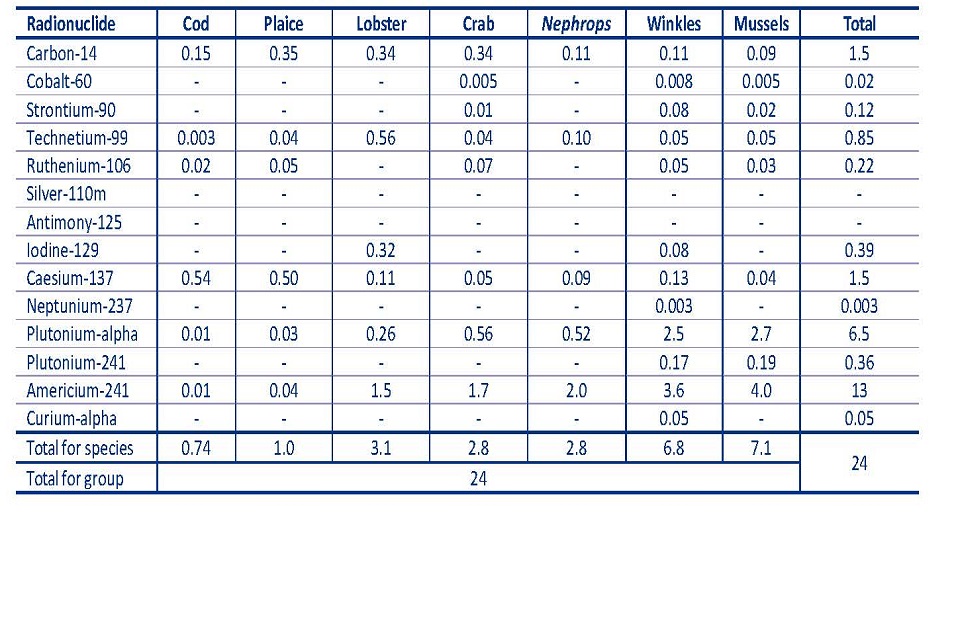
Table 2. Summary of adult doses associated with aerial discharges (µSv per year), 2021

Table 3. Summary of doses to the terrestrial critical group (µSv), 2021
| Pathway | Adult | Child | Infant | Foetus |
|---|---|---|---|---|
| Terrestrial food consumption | 4.7 | 4.6 | 4.1 | 3.7 |
| Marine food consumption | 0.58 | 0.12 | 0.05 | 0.39 |
| Inhalation | 0.52 | 0.28 | 0.15 | 0.01 |
| Immersion (krypton-85) | 0.03 | 0.02 | 0.02 | 0.03 |
| External (beach) | 2.9 | 1.5 | 0.09 | 2.9 |
| Total | 8.7 | 6.5 | 4.4 | 7.0 |
Table 4. Critical group doses from operations at Sellafield (µSv)
| Pathway | 2020 | 2021 |
|---|---|---|
| Marine critical group (adults) | ||
| seafood consumption | 32 | 24 |
| aerial pathways | 1.6 | 1.5 |
| external radiation from beach occupancy (marine) | 37 | 35 |
| Total dose to marine critical group (adults) | 71 | 60 |
| Terrestrial critical group (adults) | ||
| inhalation | 0.67 | 0.52 |
| immersion | 0.05 | 0.03 |
| external radiation from beach occupancy (terrestrial) | 3.0 | 2.9 |
| terrestrial foodstuff consumption | 4.6 | 4.7 |
| marine foodstuff consumption | 0.70 | 0.58 |
| direct radiation | 2.8 | 2.9 |
| Total dose to terrestrial critical group (adults) | 12 | 12 |
Table 5. Collective doses from Sellafield’s discharges, 2021
| Collective Dose (manSv) | ||||||
|---|---|---|---|---|---|---|
| Radionuclide | Aerial Discharges | Marine Discharges | ||||
| UK | Europe | World | UK | Europe | World | |
| Tritium | 0.03 | 0.05 | 0.06 | 0.0001 | 0.0003 | 0.006 |
| Carbon-14 | 0.01 | 0.07 | 0.9 | 0.3 | 0.8000 | 9 |
| Krypton-85 | 0.02 | 0.06 | 1.1 | - | - | - |
| Technetium-99 | - | - | - | 0.001 | 0.004 | 0.005 |
| Iodine-129 | 0.08 | 0.4 | 0.5 | 0.0004 | 0.001 | 0.005 |
| Caesium-137 | 0.001 | 0.003 | 0.003 | 0.02 | 0.06 | 0.1 |
| Plutonium-alpha | 0.008 | 0.01 | 0.01 | 0.02 | 0.06 | 0.07 |
| Americium-241 | 0.001 | 0.002 | 0.002 | 0.01 | 0.04 | 0.04 |
| Other nuclides | 0.0002 | 0.0004 | 0.0004 | 0.03 | 0.07 | 0.09 |
| Total | 0.2 | 0.6 | 3 | 0.3 | 1 | 9 |
Figure 1. Dose to marine critical group from Pu-α and Am-241 in winkles and consumption rate
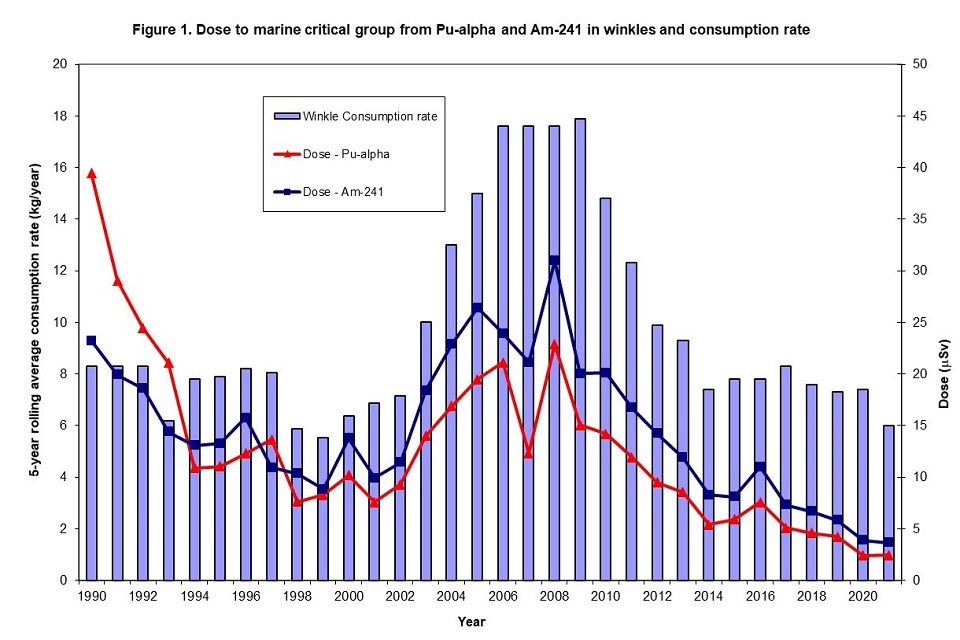
Figure 2. Dose to marine critical group from Pu-α and Am-241 in mussels and consumption rate
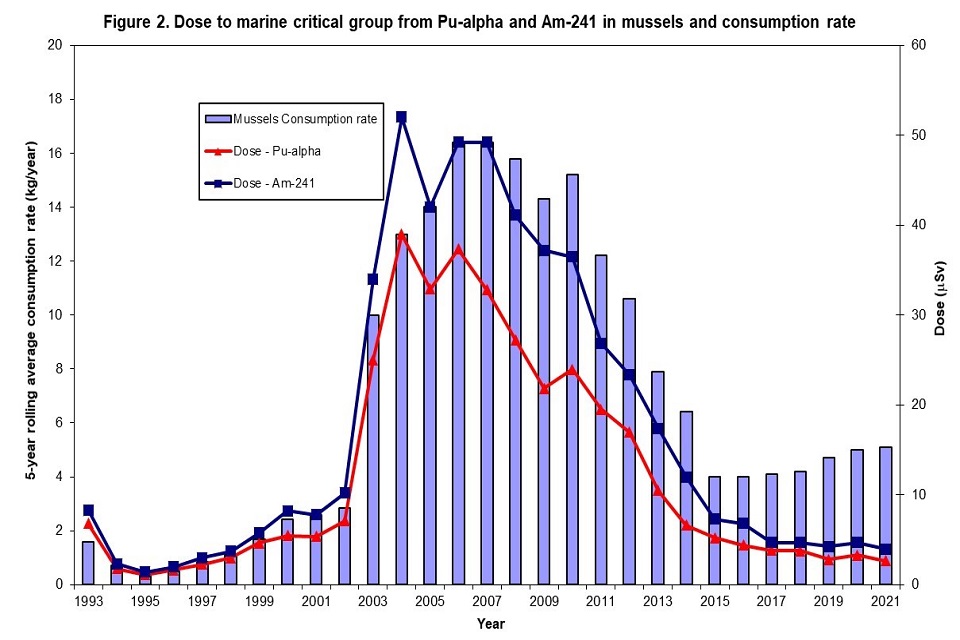
Figure 3. Dose to marine critical group from Pu-α and Am-241 in Nephrops and consumption rate
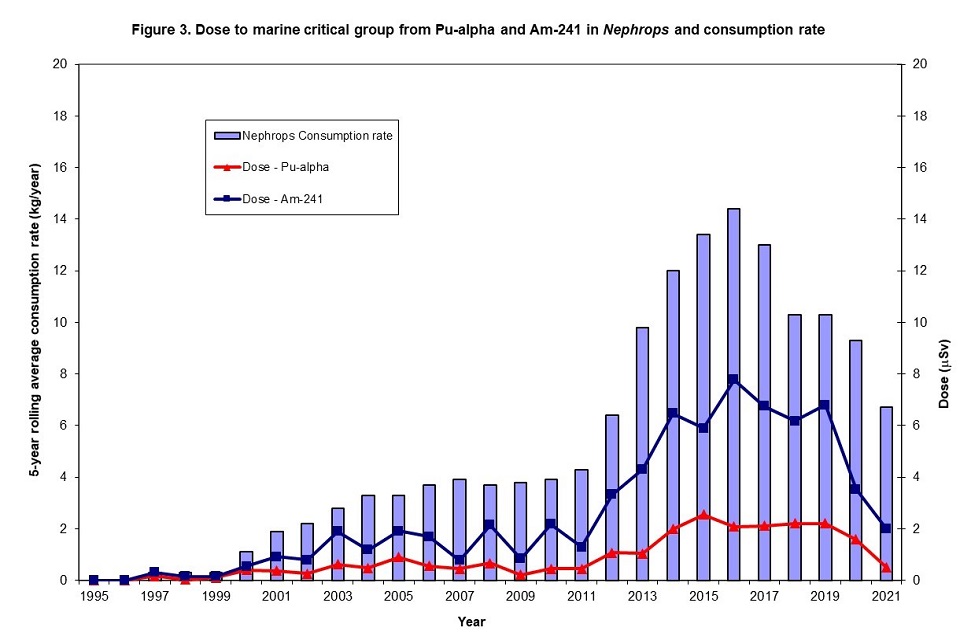
Figure 4. Marine Critical Group Dose (Adult) (Consumption pathways) by Radionuclide

Figure 5. Marine Critical Group Dose (Adult) by Pathways
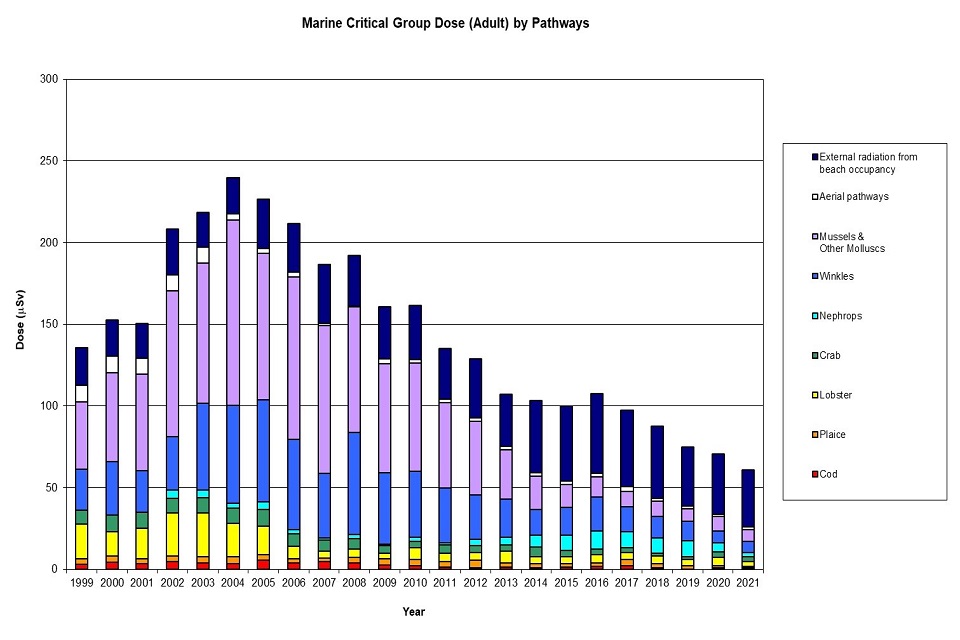
Figure 6. Terrestrial Critical Group Dose (Consumption pathways) by Radionuclide
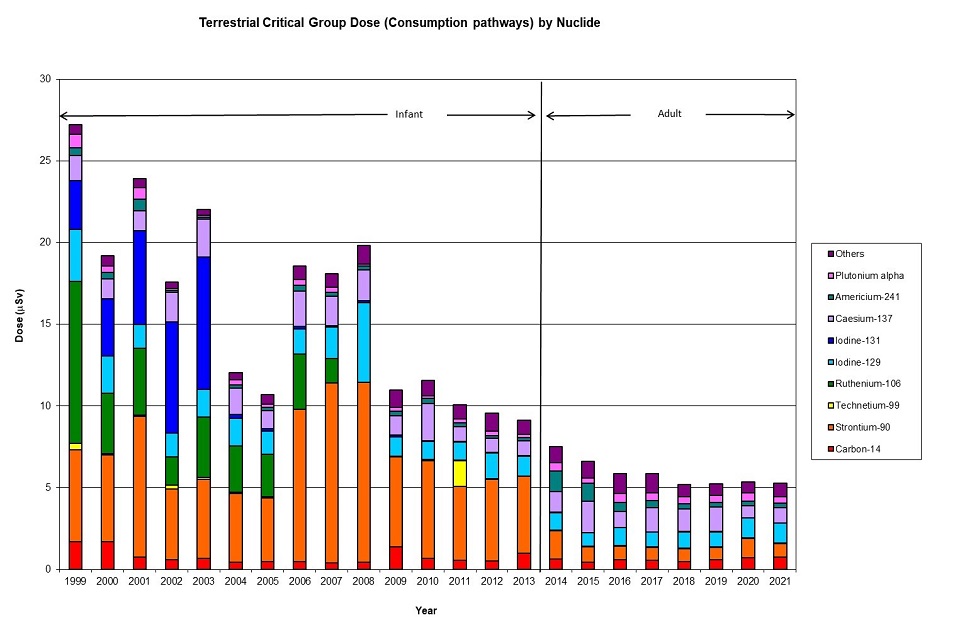
Figure 7. Terrestrial Critical Group Dose by Pathways

6. Beach monitoring
Beach monitoring
Monitoring of beaches has been part of the routine environmental monitoring programme at Sellafield since 1983. In 2003, during a routine survey, a radioactive particle was found which prompted a review of beach monitoring.
Following agreement with the Environment Agency an intensive programme of beach monitoring commenced in 2006 using a vehicle mounted array of radiation detectors.
The monitoring programme is determined by taking account of the find rates in previous years and the occupancy information for each beach.
The programme is reviewed annually to ensure it represents the Best Available Technique (BAT) with its scope and extent being agreed with the Environment Agency (1,2).
The Nuvia Ltd. Groundhog Synergy (2) system is currently used for particle detection on the beaches.
It has an array of 5 76 x 400 mm sodium iodide (NaI) detectors for the detection of beta rich and other radionuclide items and an additional eight Field Instrument for the Detection of Low Energy Radiation (FIDLER) detectors for the enhanced detection of americium-241.
The detection system is mounted in a carbon fibre casing with thin windows beneath the detectors to improve the transmission of beta radiation and to further improve detection of strontium-90 and its daughter product yttrium-90.
The results from the monitoring programme have been used by UK Health Security Agency (UKHSA) to determine the risks to members of the public that are either high consumers of locally caught seafood or spend time on activities that might potentially bring them into contact with the types of finds being recovered from the coastal environment around the Sellafield site (3, 4).
The Environment Agency have published an Intervention Plan (5) that takes account of the UKHSA risk assessment conclusions and explains how the different organisations will work together to:
- protect the public and environment from any harm caused by radioactive objects on west Cumbria beaches
- respond to a discovery of radioactive objects near the Sellafield site – a significantly unusual single find, or a significant overall change in the find rate, activity or trends
- check that the conclusions of a public health risk assessment for the radioactive objects remain valid
- The reader is directed to the comprehensive Sellafield Ltd Particles in the Environment, Annual Report and forward programme series of reports for a more detailed history and analysis of the work undertaken to understand the background and processes behind the current monitoring programme (6).
In 2021, a total area of 121 hectares (ha) of Cumbrian beaches was surveyed meeting the programme’s specification (Table 1).
This identified 98 radioactive items, of which 94 were classified as particles (less than 2 mm in size) and 4 as larger objects (greater than 2 mm in size) (Table 2).
A total of 93 of the particle finds were designated alpha rich, with higher americium-241 activity than caesium-137 activity and one was designated as beta rich, where caesium-137 was the major radionuclide.
All of the larger objects were designated beta rich. The majority of finds were recovered from Northern beaches (69%). Further details of the numbers of radioactive items found are given in Table 3.
The distributions of caesium-137 and americium-241 activities for particles recovered in 2021 were within the range observed since the programme began in 2006 and were comparable to the activity distribution for 2014 - 2020, shown in Figure 1.
This provides reassurance that they are part of the same general population and are within the range of activities that were considered in the UKHSA health risk assessment.
None of the particles or larger objects that were recovered during 2021 exceeded the characterisation criteria specified by the Environment Agency (5) and therefore there was no requirement for further laboratory analysis.
The find rates in 2021 were consistent with those used in the latest UKHSA risk assessment (3,4). These rates did not trigger the Environmental Agency (EA) intervention criteria (5).
UKHSA has advised the EA on the particle risks associated with using the beaches around Sellafield. The current advice is reproduced below (4).
we concluded that the risks from radioactive objects in the environment near to the Sellafield site are very low, and we advise that measures to control those risks to protect the public’s health are not needed.
The same planned monitoring programme as shown in Table 1 is being implemented in 2022.
This has been agreed following consultation with key stakeholders including the Environment Agency, UKHSA, Food Standards Agency, West Cumbria Site Stakeholder Group (WCSSG) and the Department of Health and Social Care Committee on Medical Aspects of Radiation in the Environment (COMARE).
References
- Sellafield Ltd, BAT assessment for monitoring particles in the environment. June 2017, SSEM/2017/29, Nuclear Decommissioning Authority.
- Sellafield Ltd, BAT assessment for monitoring particles in the environment. October 2020, SSEM/2020/23, Nuclear Decommissioning Authority.
- Oatway, W. B., Cabianca T. & Jones, A. L., 2020. Assessing the risk to people’s health from radioactive objects on beaches around the Sellafield site: Summary report, PHE-CRCE-056, Public Health England.
- Oatway, W. B., Cabianca T. & Jones, A. L., 2020. Assessing the risk to people’s health from radioactive objects on beaches around the Sellafield site: Technical report, PHE-CRCE-057, PHE.
- intervention plan, Penrith: Environment Agency. Available online at: https://www.gov.uk/government/publications/sellafield-radioactive-objects-notification-and-intervention-plan/sellafield-radioactive-objects-notification-and-intervention-plan
- Sellafield Ltd, 2018. Particles in the Environment, Annual Report for 2018 and Forward Programme, June 2019 SSEM/2019/15, , Nuclear Decommissioning Authority. Available online.
Table 1. Beach monitoring conducted during 2021
| Programme | Planned monitoring (ha) | Actual monitoring (ha) |
|---|---|---|
| Sellafield | 52 | 57 |
| Northern Beaches | 32 | 36 |
| Southern Beaches | 16 | 24 |
| Allonby | 5 | 5 |
| Total | 105 | 121 |
Table 2. Particle and larger object beach finds recovered during 2021
| No. of particles found ᵃ | No. of larger objects found ᵇ | ||||||
|---|---|---|---|---|---|---|---|
| Programme | Alpha richᶜ | Beta rich ᵈ | Otherᵉ | Alpha rich | Beta rich | Other | Total finds |
| Sellafield | 24 | 1 | 0 | 0 | 4 | 0 | 29 |
| Northern Beaches | 68 | 0 | 0 | 0 | 0 | 0 | 68 |
| Southern Beaches | 1 | 0 | 0 | 0 | 0 | 0 | 1 |
| Allonby | 0 | 0 | 0 | 0 | 0 | 0 | 0 |
| Total | 93 | 1 | 0 | 0 | 4 | 0 | 98 |
a. Particles (less than 2 mm in size)
b. Larger objects (greater than 2 mm in size)
c. Alpha rich, higher americium-241 activity than caesium-137 activity
d. Beta rich, where caesium-137 was the major radionuclide
e. Other, principal radionuclide is neither americium-241 activity or caesium-137, for example cobalt-60
Table 3. Total area monitored and finds by category, beach and calendar year (2017 - 2021)
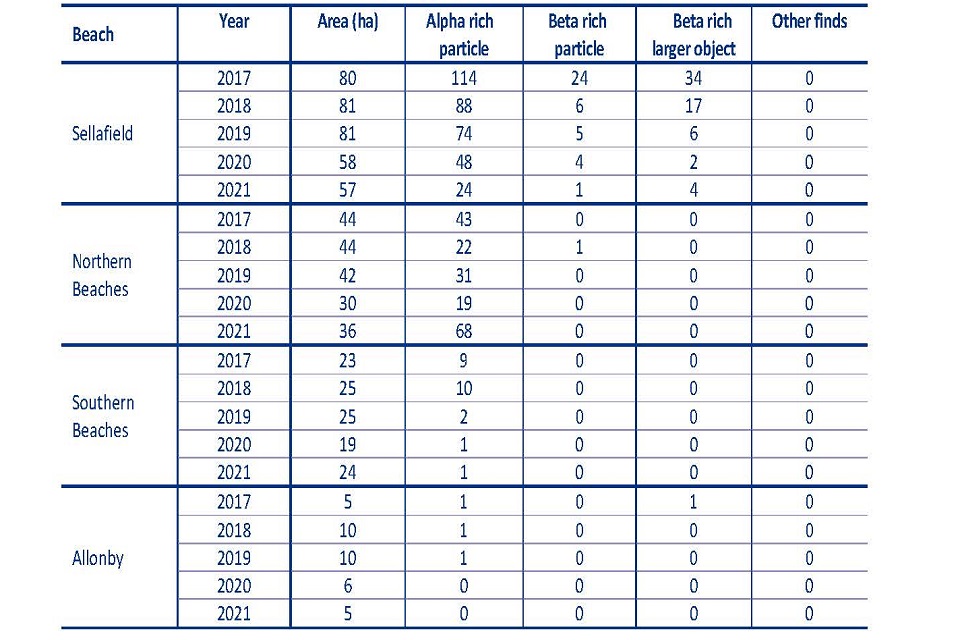
Figure 1. Radioactivity of finds classified as alpha-rich particles (upper) and beta rich particles (lower) between 2014 – 2020 (shown in blue) compared to data from 2021 shown in red)
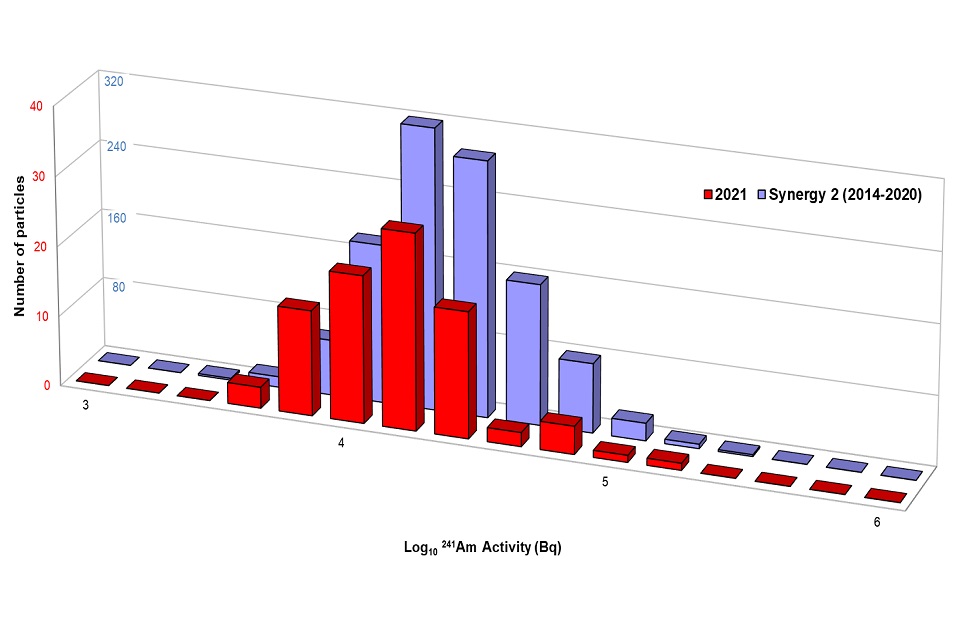
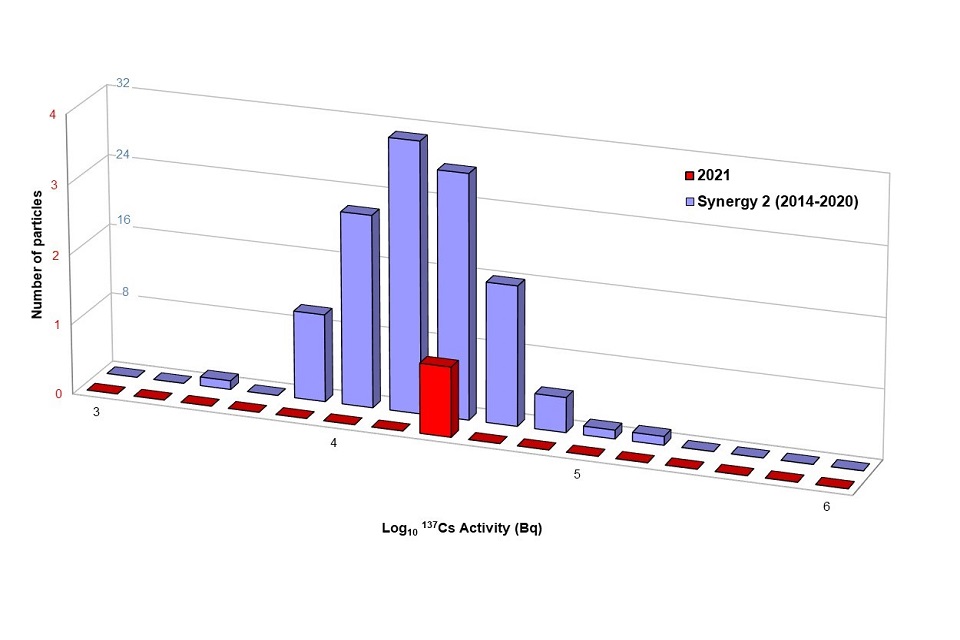
7. Groundwater monitoring
Groundwater Monitoring
During the industrial history of the Sellafield site, there has been radioactive contamination of soils and groundwater.
A programme of contaminated land and groundwater management has been performed since the late 1970s at and around the site to ensure protection of the Sellafield site work force, the public and the environment.
This section describes the status of the Sellafield Ltd groundwater monitoring programme carried out in the calendar year 2021.
The purpose of this review is to present analytical data for groundwater and identify any significant year on year changes in groundwater quality, both underlying and in the vicinity of the Sellafield site.
Geology and hydrogeology
The geology beneath the Sellafield site is Triassic sandstone bedrock covered with more recent glacial deposits of sand, gravel, clay and silts (referred to as superficial deposits).
Figure 1 shows a schematic representation that broadly describes the geology and hydrogeology at Sellafield site.
The source of regional and local groundwater is mainly rainfall and surface water from rivers, streams, lakes and tarns that enter the ground. The water consolidates into laterally continuous aquifers within porous geological material subsurface.
In the Sellafield area there is the upper aquifer in the drift and the main, regional aquifer in the sandstone. Data in this report are from samples collected from both aquifers.
The upper surface of an aquifer approximately follows the land contours, with the direction of groundwater flow passing from recharge areas at higher elevations toward discharge areas at lower elevations.
In general, the groundwater flows from the Cumbrian fells towards the coast in a south-westerly direction.
Typical travel times are considered to be between 10 and 20 years from the northern site boundary to the coast, chemical interactions may increase or inhibit these travel times for contaminants.
The distribution of groundwater contamination at Sellafield is a complicated superposition of multiple ‘plumes’ which originate from multiple sources on site and are transported to the west and southwest in the direction of groundwater flow.
These ‘plumes’ exist at different depths in the regional water table in different areas of the site. The contamination becomes diluted, and the ‘plumes’ merge together as they migrate and disperse slowly down-gradient.
The principal radionuclides that comprise the migrating contamination are the most mobile with a sufficiently slow decay rate e.g., tritium, technetium-99, and the slightly less mobile strontium-90.
The individual radionuclide components migrate and decay at different rates, therefore, the composition of the ‘plume’ changes both with time and distance from the source. Other radionuclides are assumed to be strongly bound to sediments and be geochemically held up nearer to their source.
There is no evidence that there has been significant migration of alpha emitters in groundwater therefore migration may be assumed to be very slow or highly retarded.
Sellafield Ltd undertakes groundwater monitoring to characterise and monitor the groundwater below and adjacent to the Sellafield site. Sellafield Ltd observe any changes in groundwater physical and chemical properties both spatially and temporally.
In addition, groundwater monitoring is undertaken in order to comply with site Environmental Permits. The management of groundwater is underpinned by a Best Available Techniques assessment.
The groundwater monitoring network for 2021 included 171 sample points (figure 2) and was designed to meet the monitoring objectives and provide targeted sampling in areas of interest. 711 individual groundwater samples were successfully collected during 2021.
Each groundwater sample was analysed for up to 26 radiological determinands depending on the location and monitoring requirements at each sample point.
In early 2021, groundwater sampling operations were reduced during the national lockdowns in order to protect the workforce and the wider community.
The reduced sampling programme was developed following a risk-based approach and initially focused on maintaining targeted sampling and statutory samples for the site environmental permits.
Radiological monitoring of groundwater
In order to assess general variations in groundwater radionuclide concentrations across site, datasets have been considered at a monitoring well scale.
Groundwater sample results have been compared against the World Health Organisation (WHO) drinking water guideline levels1 to provide a context for the radionuclide concentrations measured within groundwater.
Average results above WHO drinking water guidelines are indicated by larger diameter points on each figure. WHO drinking water guidelines are used because they define values for a comprehensive list of radionuclides and they are considered to be the most conservative, however it should be noted that these guidelines are not used as compliance targets.
Three wells located along the northern perimeter of Sellafield site measure the regional groundwater condition entering the site.
Results from monitoring wells situated across Sellafield site are compared against those from the northern perimeter wells to provide an indication of how the groundwater condition changes as it flows through the site.
Assessment shows the results from the down gradient wells on the Sellafield site are in line with, or above, those from the northern perimeter wells.
Total alpha
Total alpha screening results are presented in figure 3. The results show that measured total alpha concentrations in the majority of groundwater samples were below the programme target analytical limit of detection (LOD) of 0.03 Bq l -1.
Total alpha activity concentrations that were greater than the WHO drinking water guideline level (0.50 Bql-1) were recorded at two locations, with a maximum activity concentration of 7.37 Bql-1.
The highest total alpha activity concentrations were measured in samples from monitoring wells located within the separation area, adjacent to buildings associated with nuclear fuel reprocessing activities, some of which have had historical incidents of radioactive liquor leaks to ground.
The locations where the highest total alpha activity concentrations were recorded monitor groundwater within the shallower superficial deposits between 9.1 and 14.7 metres below ground level (mBGL).
Analyses for individual alpha-emitting radionuclides that contribute to the total alpha activity were measured at 15 piezometers across Sellafield site in 2021.
Results show that uranium isotopes (specifically uranium-238 and uranium-234) dominated the total alpha activity measured, with low levels of uranium-235 and uranium-236 found in a small number of wells.
Total beta
Figure 4 shows that many groundwater monitoring wells had annual average total beta results above the WHO drinking water guideline level of 1.00 Bq l-1.
The majority of samples that exceeded the WHO drinking water guideline values were from monitoring wells located within the separation area, with a smaller number located outside of this area to the south and north-west.
Figure 4 shows the highest annual average total beta results in 2021 (maximum 85,900 Bq l-1) were from wells located in the Separation Area, adjacent to buildings associated with legacy waste storage.
The locations with the highest total beta activity concentrations monitor superficial deposits between 3.05 and 21.5 mBGL.
Analyses for the individual beta-emitting radionuclides that contribute to gross beta activity found in groundwater samples have been made in selected locations.
These results show that strontium-90 is the dominant beta-emitting radionuclide in groundwater on site and has a similar spatial distribution to gross beta activity, figure 5.
Fewer results exceeded the WHO drinking water guideline for strontium-90 than gross beta.
Tritium
Average tritium concentrations measured during 2021 are presented in figure 6. Tritium concentrations greater than the LOD were measured in monitoring wells both within the separation area and in a predominantly south-westerly direction towards the coast.
Elevated tritium activity concentrations are observed in monitoring locations in the eastern part of Separation Area. Tritium is measured in monitoring wells that are screened in sandstone and shallower superficial deposits.
Two monitoring wells had an annual average concentration above the WHO drinking water guideline value (10,000 Bq l-1).
Technetium
Technetium-99 concentrations are shown in figure 7 and show a similar spatial and vertical distribution to tritium.
Results show that technetium-99 was detectable at low concentrations in groundwater samples collected across the Separation Area, to the south of the Separation Area and from newly installed wells to the west of the Separation Area.
No annual average results exceed the WHO drinking water guideline value of 100 Bq l-1.
The highest concentrations were from monitoring wells located south-west of the Separation Area.
Annual Comparison
There are 15 monitoring wells located around the site perimeter to detect any significant migration of radioactivity in groundwater. Table 1 indicates the results from these locations over the last 5 years.
The results for the majority of locations are broadly consistent year on year. Tritium activity concentrations show a slight decrease particularly in locations 10339, 6986p1 and 6228p1. Gross beta and strontium-90 indicate a slowly increasing trend at 6948p1.
Non-radiological monitoring of groundwater
The Environmental Permit (2) requires that Sellafield Ltd record any changes to the groundwater quality throughout the life of the permit.
The overall aim is to maintain a good groundwater quality status as the environmental protection infrastructure on the site is developed and enhanced. Environmental permit monitoring locations are shown in figure 2.
Table 2 summarises the average concentration for the environmental permit determinants in the non-radiological dataset over the last five years.
The majority of annual average results from wells that are monitored as part of the environmental permit have remained broadly consistent between 2017 and 2021 and were all below the Environmental Screening Criteria values (where applicable), except for the total petroleum hydrocarbons (TPH, ESC of 0.03 mg l-1). Results for TPH (all bands, C6-C40) range between 0.12 and 0.21 mg l-1 between 2017 and 2020 but 2021 results indicate a decrease to 0.06 mg l (-1).
Major ion analysis
Determining the groundwater composition yields information that provides a picture of hydrogeological and chemical conditions at a particular monitoring well at that specified point in time.
Many natural factors affect the groundwater composition across the Sellafield site. The primary factors include: the source and chemical composition of recharge water, the lithological properties of the geological unit, the chemical reactions occurring within the geological unit, and the residence time of the groundwater.
The ionic composition of water samples is used to classify the groundwater into types based on the dominant cations and anions present, a summary of the groundwater types for the samples collected during 2021 are shown in figure 8.
In 2021, 38 samples had an ionic balance greater than 10% or less than -10%. In most cases the imbalance was due to a higher proportion of cation results recorded in the sample.
The vast majority of the groundwater can be classified as mixed with bicarbonate, calcium, chloride and sodium being the dominant ions at most locations. 25 sample locations can be classed as sodium-chloride type and 16 sample locations can be classed as calcium-bicarbonate type.
References
-
WHO (2011). Guidelines for drinking-water quality, fourth edition. World Health Organization, Geneva, Switzerland.
-
HMSO (2016). The Environmental Permitting (England and Wales) Regulations 2016. Her Majesty’s Stationery Office, London.
Table 1. Radioactivity in groundwater at Sellafield, 2017 - 2021 (Bq l-1)
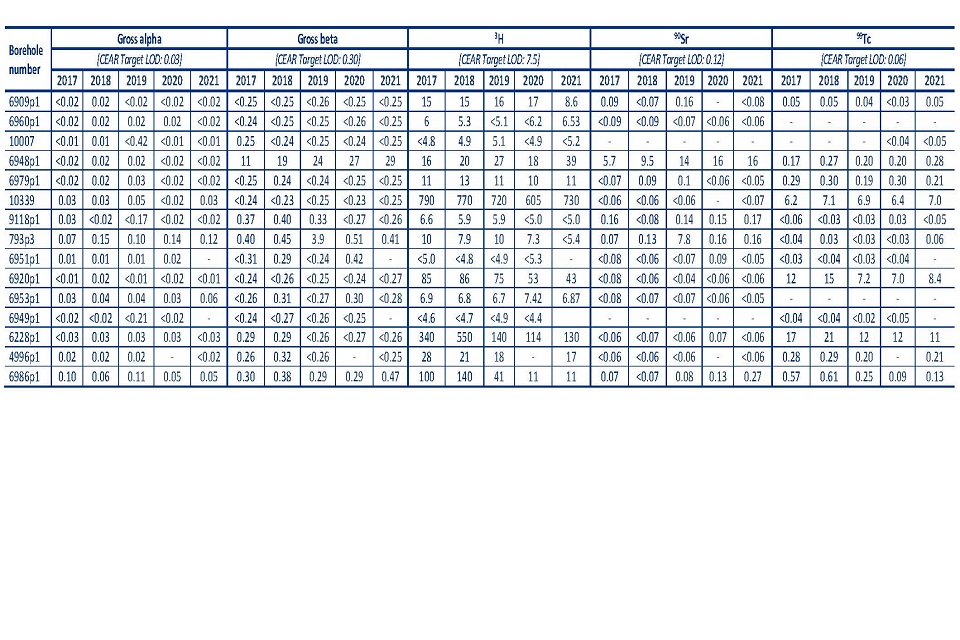
Table 2. Environmental permit determinands summary table showing annual average results (mg l-1)
| Analyte | 2017 | 2018 | 2019 | 2020 | 2021 |
|---|---|---|---|---|---|
| Ammonium | 0.04 | 0.03 | 0.03 | 0.02 | 0.02 |
| Barium | 0.07 | 0.07 | 0.07 | 0.08 | 0.07 |
| Chloride | 36 | 40 | 41 | 46 | 43 |
| Chromium | 0.001 | 0.001 | 0.002 | 0.002 | 0.001 |
| Gadolinium | <0.001 | <0.001 | <0.001 | <0.001 | <0.001 |
| Iron | 0.40 | 0.67 | 0.30 | 0.57 | 0.47 |
| Magnesium | 7.4 | 7.6 | 6.1 | 5.7 | 6.3 |
| Nitrate | 13 | 14 | 15 | 16 | 15 |
| Potassium | 2.3 | 2.6 | 2.5 | 2.4 | 2.8 |
| Sodium | 31 | 32 | 33 | 38 | 32 |
| Sulphate | 33 | 31 | 27 | 31 | 27 |
| TPH Total (C6-C40) | 0.13 | 0.21 | 0.13 | 0.12 | 0.06 |
Figure 1. Schematic representation of Sellafield site geology and hydrogeology
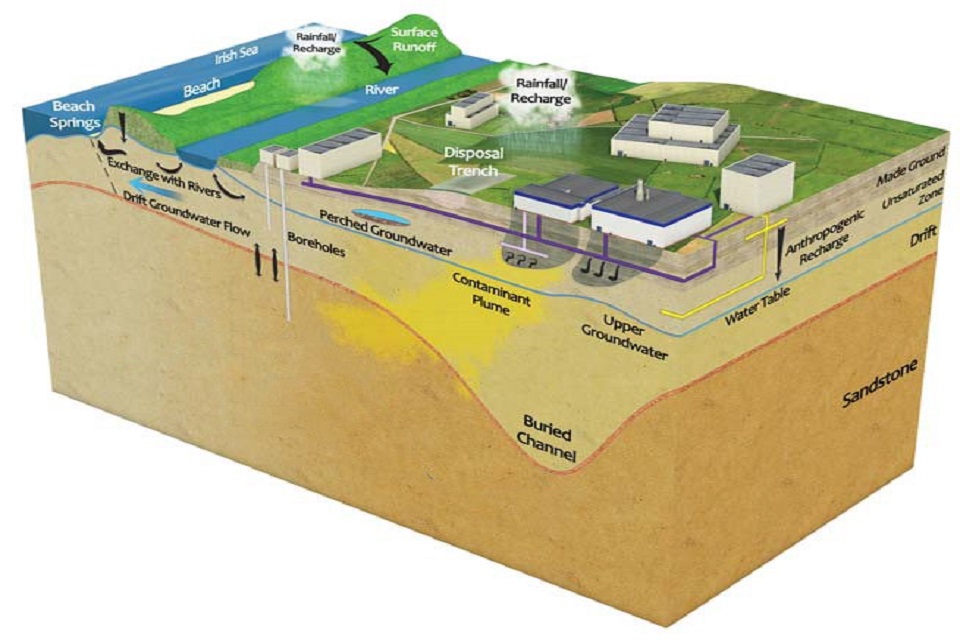
Figure 2. Groundwater Monitoring Network
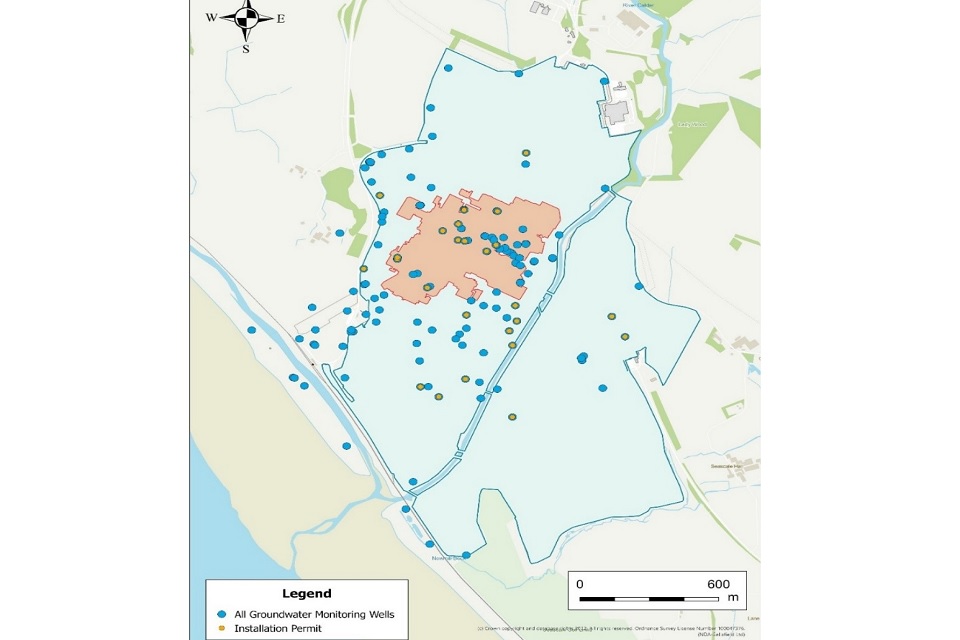
Figure 3. Average Total Alpha Concentrations (Bq l-1)
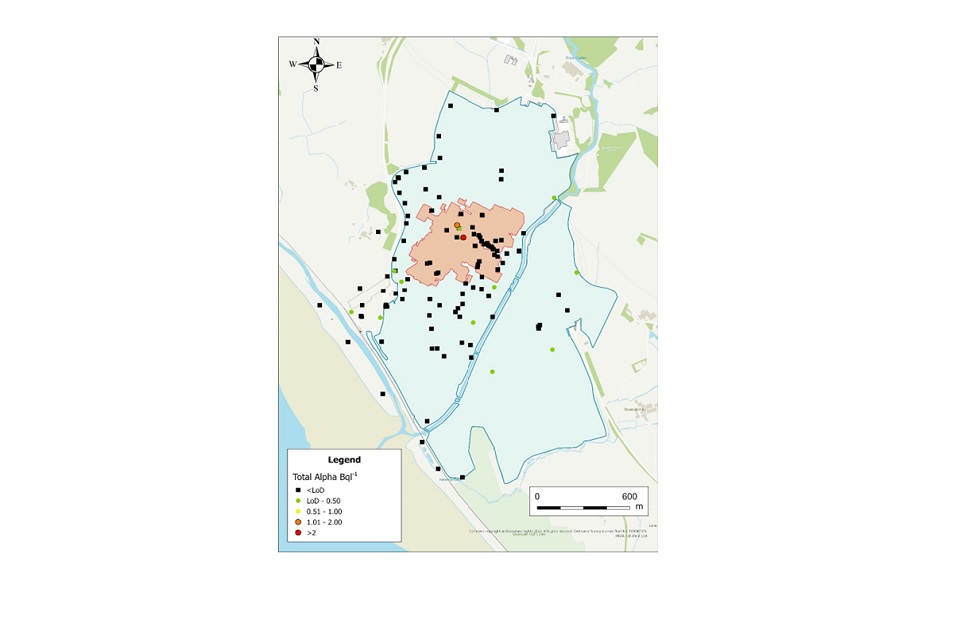
Figure 4. Average Total Beta concentrations (Bq l-1)
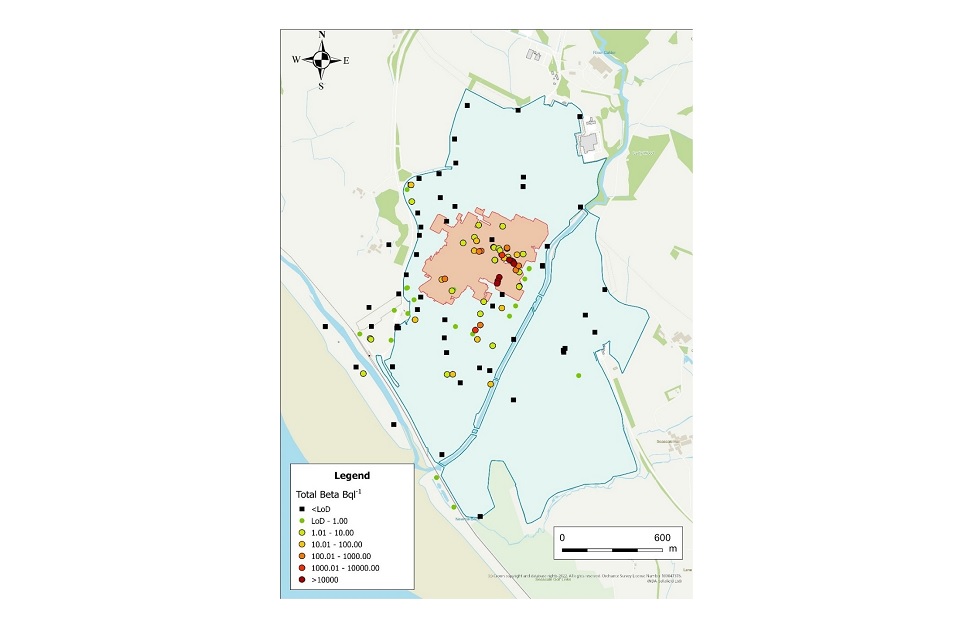
Figure 5. Average strontium-90 concentrations (Bq l-1)
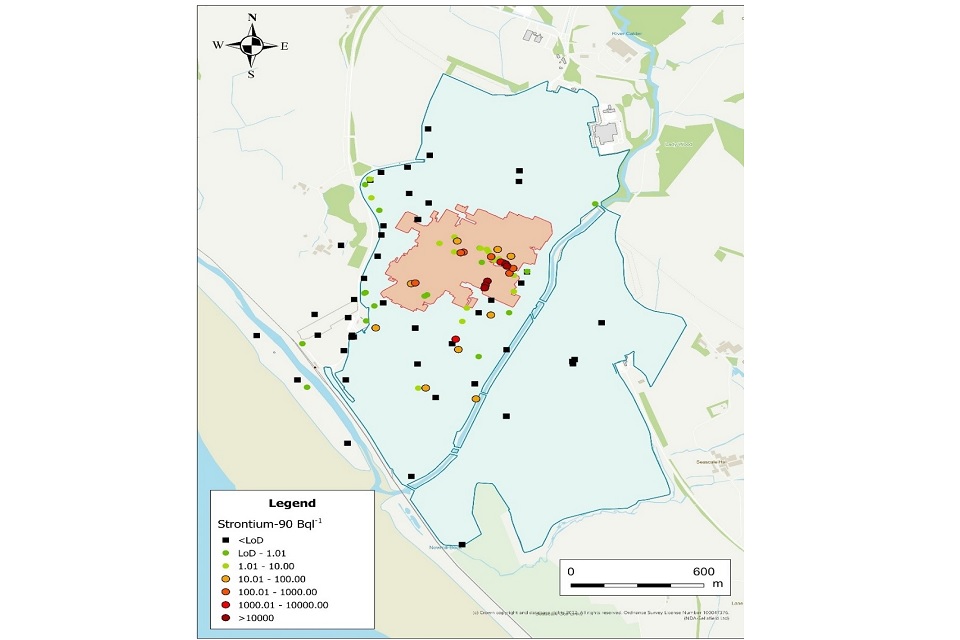
Figure 6. Average tritium concentrations (Bq l-1)
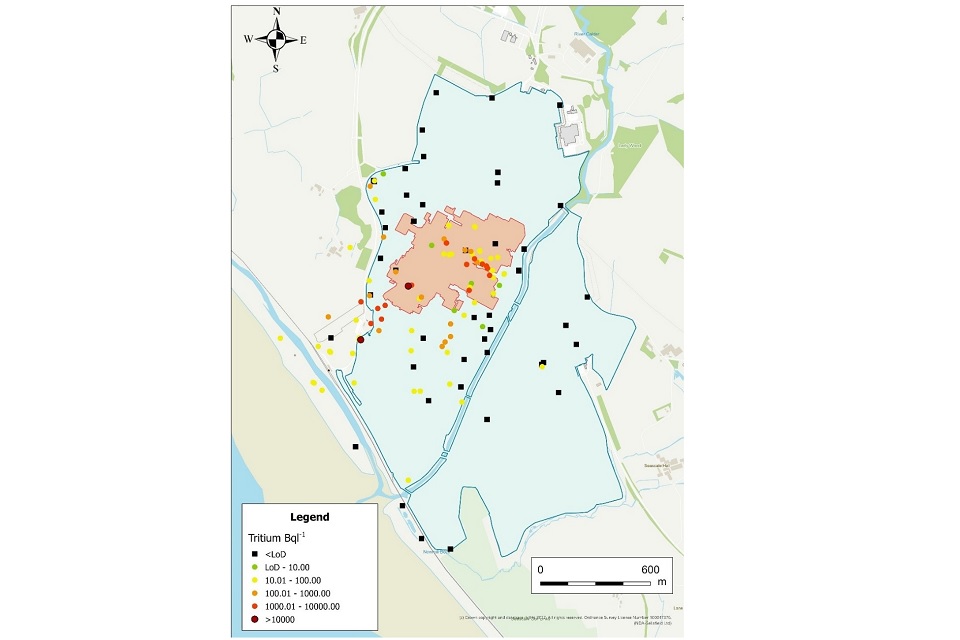
Figure 7. Average technetium-99 concentrations (Bq l-1)

Figure 8. Groundwater types identified
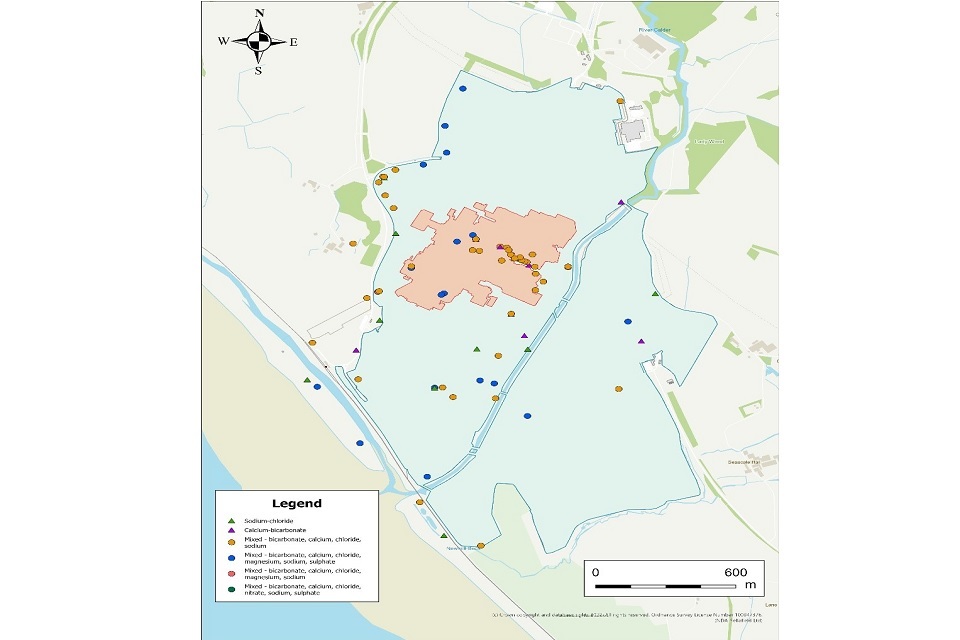
8. Corporate Carbon Footprint 2021/22
Sellafield Ltd’s Carbon Footprint
Sellafield Ltd must comply with both domestic and international legislation concerning energy use and the emission of greenhouse gases.
The United Kingdom Greenhouse Gas Emissions Trading Scheme (UKETS) (1) is the most significant of these obligations and requires Sellafield Ltd to purchase sufficient allowances to cover certain carbon dioxide (CO₂) emissions due to the combustion of fossil fuels.
Further obligations include: the Climate Change Levy (CCL) main rate and carbon price support (CPS)2; and conditions within Sellafield Ltd’s EPR Installation environmental permit (3).
Sellafield Ltd produces an annual carbon footprint, which is developed against the Greenhouse Gas (GHG) Protocol using GHG conversion factors (4) and is a recognised methodology for calculating emissions for the power and heat output from the Combined Heat and Power Plant (CHPP).
It has been derived according to a location-based approach which calculates carbon emissions from procured electricity using the national grid average.
Since 01 April 2019, Sellafield Ltd has also been required to report energy use and associated carbon emissions within the Company Annual Report (5) to comply with UK Government Streamlined Energy and Carbon Reporting (SECR) requirements (6).
The Sellafield Ltd annual carbon footprint for the 2021/22 financial year is 215,000 tonnes CO2e and represents all Sellafield’s total direct emissions (Scope 1 and 2); and includes a small proportion of indirect emissions (Scope 3), namely business travel and commuting (figure 1).
Annual carbon emissions have reduced by 6% when compared to the 2020/21 financial year. This reduction is primarily due to 2 factors: continuation of the reduced operational activity due to the COVID-19 pandemic into the 2021/22 financial year; and reduction in electricity generated at CHPP thus leading to a greater proportion of the electricity used on the Sellafield site being imported from the National Grid.
The carbon footprint does not currently include Scope 3 emissions from purchased goods and services, supply chain activities and waste generated in operations. These are estimated to be around 600,000 tonnes CO2e based on best available expenditure data.
The company is working to identify Scope 3 primary data sources to progressively improve these data and incorporate them in annual carbon foot printing in the future.
Taking account of the total carbon emissions for Sellafield Ltd reported in the annual carbon footprint and those estimated for Scope 3 in addition, the key contributors to Sellafield Ltd carbon emissions are identified as:
Scope 1 - energy produced at Fellside and consumed on the Sellafield Ltd site
Scope 2 - Electricity imported from the National Grid
Scope 3 - Purchased goods and services (currently estimated from expenditure data and not included in the 2021/22 carbon footprint)
Following the development of Sellafield Ltd’s first Carbon Management Plan (7), work has continued to implement the plan to support the reduction in capital and operational carbon emissions, both now and in future years.
Focusing on the key contributors to the company’s carbon emissions highlighted above, carbon reduction opportunities have been identified in the key areas of electricity and steam generation, energy distribution, energy demand, and procurement of goods and services through our supply chain.
These carbon reduction opportunities are now being developed with stakeholders across the business to enable their delivery and identify further opportunities to embed carbon into decision making and governance.
References
- Established by UK Parliament (2021). Greenhouse Gas Emissions Trading Scheme Order (2020).
- UK Government (2018). Climate Change Levy - The Climate Change Levy (General) (Amendment) Regulations 2018.
- HMSO (2016). The Environmental Permitting (England and Wales) Regulations 2016. Her Majesty’s Stationery Office, London.
- UK Government (2022). UK Government GHG Conversion Factors for Company Reporting.
- Sellafield Ltd (2021). Sellafield Ltd annual report and financial statements Results for Year Ended 31 March 2022.
- UK Government (2019). Environmental Reporting Guidelines: Including streamlined energy and carbon reporting and Annex D (Heat Steam and CHP).
- Sellafield Ltd (2021). Sellafield Ltd Carbon Management Plan 2020 – 2050.
Figure 1. Schematic representations of corporate contributions to the carbon use in Scope 1 - 3 categories

9. Future Effluent Discharge Projections
Discharge Projections
Liquid and gaseous radioactive and non-radioactive effluents are generated during activities undertaken at the Sellafield Site.
The Sellafield Effluent Management Strategy outlines current and future requirements and recommendations for managing such effluents.
Sellafield Ltd produce annual reports containing a summary of estimates of current and future site gaseous and aqueous waste discharges by main activities in response to environmental permit requirements and in support of the government’s obligations under the OSPAR Convention.
In this report, discharges are split into 2 main categories: Operational and Historic/Legacy.
These categories align to the OSPAR definitions (1):
- Operational - Discharges from existing or planned production operations associated directly with the generation of a ‘product’ for which there are clear benefits, such as reprocessing.
- Historic/Legacy - Discharges from existing and legacy facilities that clearly are not associated with the carrying on of production operations at those facilities, such as remediation, decommissioning and clean-up of the historical legacy.
The emphasis at Sellafield is shifting to environmental remediation, decommissioning and clean-up of the historic legacy with an increasing degree of uncertainty.
The Overall Effluent Strategy Model (OESM) at Sellafield has been developed to predict current and future discharges from the Sellafield site.
This model deals with a complex and varying set of interacting source terms and is of increasing importance in forward predictions and identifying associated Best Available Technique (BAT) arrangements.
There is continual improvement in source data and forward predictions. A better understanding of uncertainties relating to future discharges is an ongoing aspect of preparation for the retrieval and associated treatment plant capabilities.
The expected outcomes and forward discharge profiles are based on assumptions about future activities and plant performance at the time of writing.
Such forecasting uncertainties are related either to schedule, plant performance, or challenge, such as.
- Time taken to empty a legacy waste store
- Performance of new treatment capabilities
- Uncertainties on activity, volumes and duration associated with Post Operational Clean Out (POCO), decommissioning and retrievals
- Variations in performance of any current plants, as flowsheets change
- Success of POCO in removing or fixing radioactive contamination
- Future scheduling changes are inevitable as risks are managed – including opportunities to accelerate plans
Reduction of forecasting uncertainties is an ongoing task aimed at increasing confidence, transparency, visibility and management of flowsheet uncertainties and expected outcomes.
Better understanding of these uncertainties is an ongoing aspect of preparation for the retrieval, POCO, decommissioning and treatment of old radioactive wastes, however some cannot be fully resolved until work is well underway.
A structured lead and learn approach are in-place.
Past and projected environmental discharge profiles of key individual and groups of radionuclides are presented in figures 1 to 3 (liquid discharges) and figures 4 to 6 (gaseous discharges).
On these figures, discharges up to and including 2021 are categorised as ‘Past’ and represent data reported to the Environment Agency. Discharges from 2022 onwards represent data projected from the OESM.
Operational liquid and gaseous discharges are projected to reduce substantially as reprocessing activities are completed. In particular, tritium (as well as krypton-85 and antimony-125) discharges are dominated by operational activities and will virtually cease when reprocessing POCO is completed.
Historic/legacy liquid and gaseous total alpha and total beta discharges have increased recently due to commencement of removing fuels and sludges from legacy storage and are projected to continue at these levels while high hazard risk reduction activities proceed.
Sellafield Ltd staff have continued to address requirements relating to the OSPAR Radioactive Substances Strategy (RSS), as part of the UK’s commitments under the OSPAR Convention.
The UK (Department for Business, Energy and Industrial Strategy) seeks progressive and substantial reductions in radioactive discharges, whilst acknowledging the need for flexibility during periods of future uncertainties.
Better understanding of these uncertainties is an ongoing aspect for the preparation of retrievals, POCO, decommissioning and associated treatment plant capabilities.
The UK Strategy for Radioactive Discharges² (UKSRD) states that the UK is making good progress in reducing radioactive discharges and continues to apply BAT.
Discharge predictions based upon the latest understanding and assumptions indicate that: discharges pose no threat to current permitted discharge limits, are not expected to compromise the UKSRD requirements and are not expected to impact adversely on Sellafield Ltd’s plans, so long as Sellafield Ltd continues to demonstrate the application of BAT.
References
- OSPAR Commission. Reporting Formats for the Collection of Data on Liquid Discharges from Nuclear Installations. OSPAR Agreement 2013-10, 2014 Update.
- Department for Business, Energy and Industrial Strategy (2018). UK strategy for radioactive discharges. 2018 review of the 2009 strategy. Department for Business, Energy and Industrial Strategy.
Figure 1. Past and projected total alpha discharges from liquid effluents
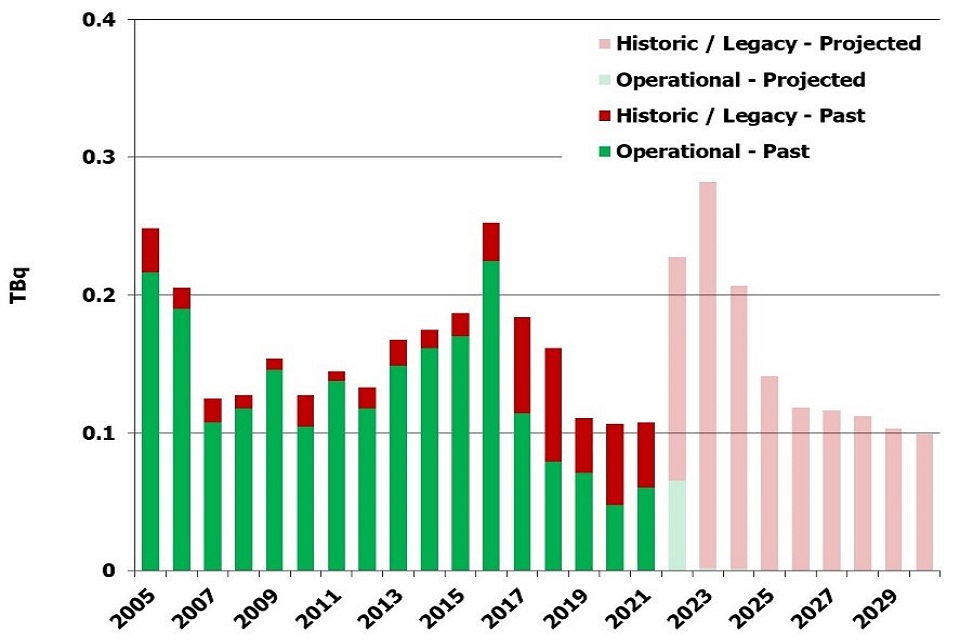
Figure 2. Past and projected total beta (excluding tritium) discharges from liquid effluents
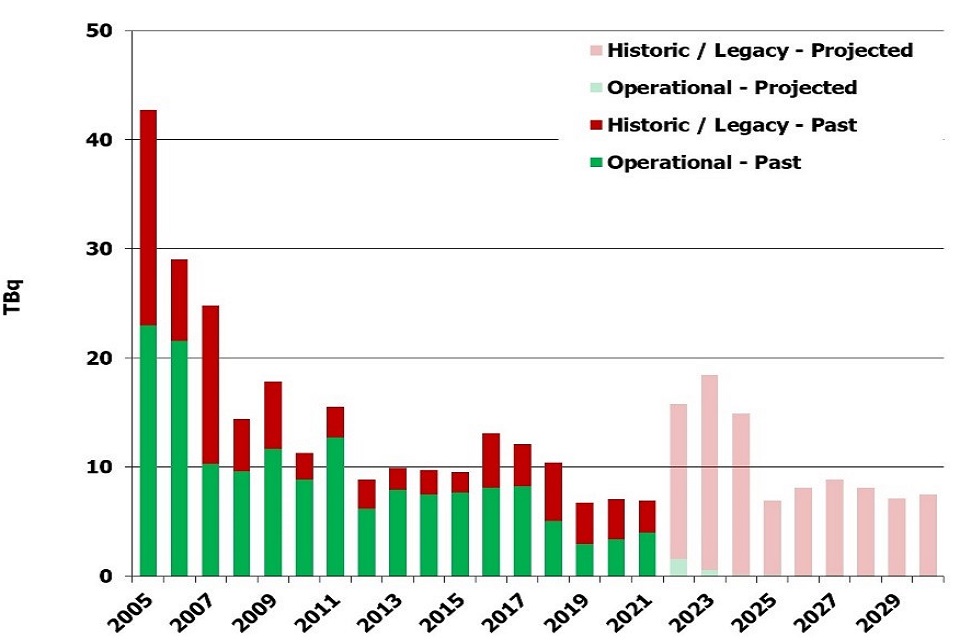
Figure 3. Past and projected tritium discharges from liquid effluents
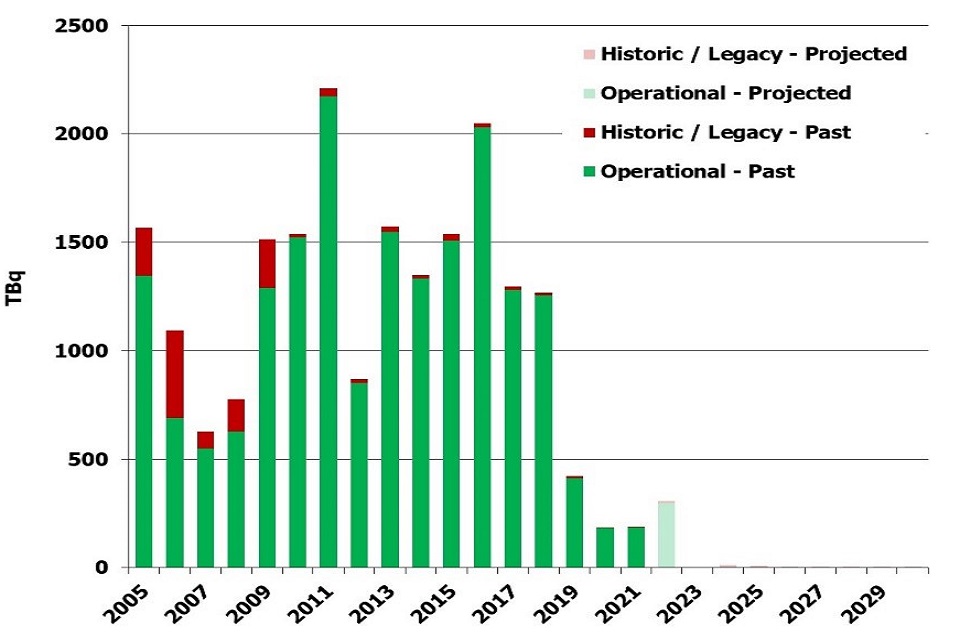
Figure 4. Past and projected total alpha discharges associated with particulates from gaseous effluents

Figure 5. Past and projected total beta discharges associated with particulates from gaseous effluents
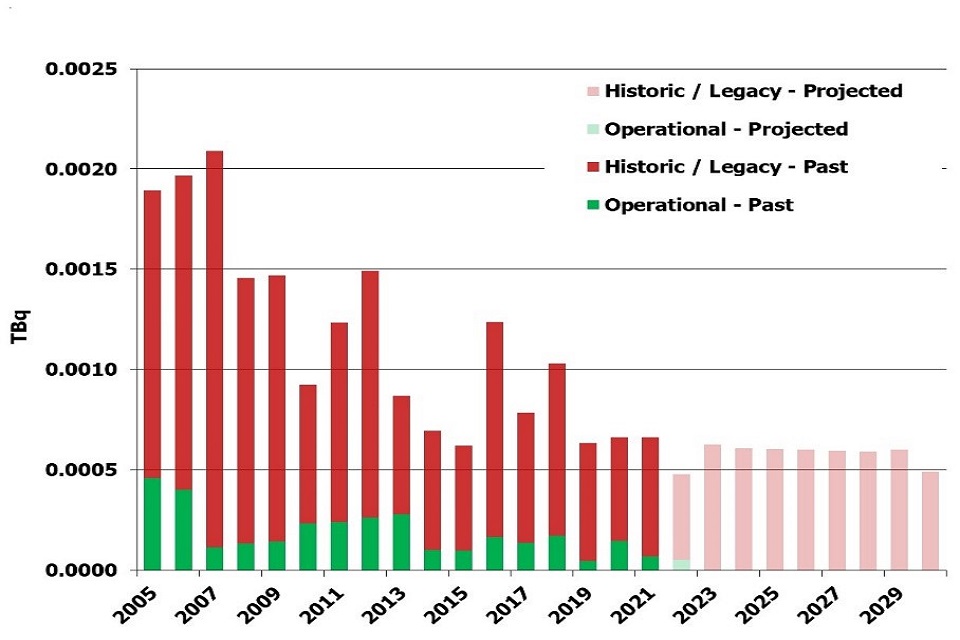
Figure 6. Past and projected tritium discharges from gaseous effluents
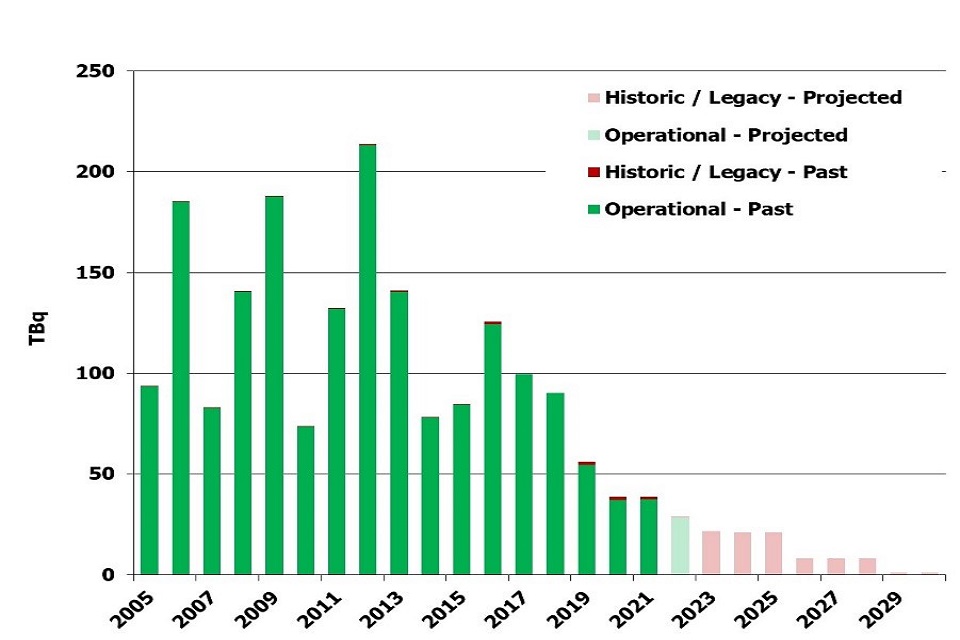
10. Appendix A
Dosimetric considerations for individual and collective doses
Critical group doses
A key concept for assessment of dose to the public is the ‘critical group’: the individual members of a population who can realistically be expected to receive the highest dose due to their lifestyle, location and habits (1,2).
This term is equivalent to the term ‘representative person’, used by the ICRP (3,4). A description of the ‘representative person’ approach using recent monitoring data is given in Appendix C.
The dose to members of a critical group is assessed as the mean of the sums of committed effective doses from intakes of radionuclides during the year and their effective doses from external irradiation.
These sums are for convenience termed effective doses and are calculated by combining dose per unit intake data with estimates of annual radionuclide intakes by ingestion and inhalation (5,6).
In determining the critical group appropriate to a particular site, it is recognised that the relative doses from different pathways will depend on the habits of particular groups of individuals.
Such doses should be summed as required to obtain the critical group dose. Therefore, a high-rate consumer of seafood may receive only a minor exposure via pathways such as milk consumption or proximity to the site perimeter.
For another group, consumption of locally produced meat and milk may combine to result in an elevated exposure. Accordingly, it is common practice to define exposure groups in terms of a dominant pathway or habit (e.g. seafood consumers, boat dwellers, anglers, inhalation pathways etc.)
For simplicity, these may at times be referred to in this report as ‘critical groups’, although strictly speaking UKHSA (2) defines only the most exposed group at any given time as the critical group.
This report focuses mainly on doses to members of critical groups; the small groups of people that are most exposed to radiation from the Sellafield Ltd site.
The doses received by the rest of the population, from operations at Sellafield Ltd site, will be very much less than those received by critical groups.
Details of the critical group consumption habits used in this report are given in table A1 (seafood consumption) and table A2 (terrestrial food consumption). Calculations related to plume immersion and inhalation dose are provided in table A3.
Critical group dose limits and constraints
UK dose limits and constraints, which are applicable to controlled releases of radioactivity, are based on the ‘1990 Recommendations’ of the ICRP¹ in which it reviewed the quantities used in radiological protection, the biological effects of radiation relevant to radiological protection, the conceptual framework of radiological protection and recommendations on dose limitation.
Under these recommendations, the primary dose quantity was redefined as effective dose, taking into account ‘weighting factors’ which reflect the sensitivity of different body organs to induction of cancer following exposure to radiation. For members of the public, the ICRP recommended an annual limit on effective dose of 1 mSv.
The ‘1990 Recommendations’ also placed emphasis on the optimisation of radiological protection and on the concept of source-related restrictions on individual dose, relating to the optimisation process, termed ‘dose constraints’.
A dose constraint is an upper bound on the annual dose to the overall critical group, summed over all exposure pathways, from the planned operation of a controlled source (1).
Dose constraints may introduce additional restrictions within the overall dose limit.
In 1993, the then National Radiological Protection Board (NRPB) published guidance based on ICRP’s ‘1990 Recommendations’ and recommended that for proposed new controlled sources, the maximum dose constraint should be 300 µSv per year².
Constraints lower than this could be set where such doses are readily achievable.
Existing facilities are expected to operate within the appropriate constraints but where it is not possible to comply with the recommended dose constraint, UKHSA advise that the operating regime be reviewed with the regulatory body to ensure that doses are ‘as low as reasonably achievable’ (ALARA).
Exposures arising from past controlled releases should be included in any comparison with the 1000 µSv dose limit but not in comparison with the dose constraint of 300 µSv. UKHSA advice includes the caveat that doses should in any case be below the 1000 µSv limit on annual dose.
The 1 mSv dose limit was incorporated into the Euratom Basic Standards Directive 1996. Ministers have directed the Environment Agency, when discharging their duties under RSA 1993, to ensure that the directive limit on annual dose to the public is not exceeded, and that a maximum source constraint of 300 µSv and a site constraint of 500 µSv are applied for authorising radioactive discharges.
The annual dose limit of 1 mSv should be compared with the sum of doses from the sites, from discharges from all other sources and from any historical accumulation of radionuclides in the environment from past discharges.
Critical group dose considerations
Radionuclides taken into the body, either by ingestion or by inhalation, cause exposure both to the local tissue and to the whole body.
For the purposes of dosimetry, monitoring and control, it is the whole-body exposure which is often of prime concern. The actual exposure will depend on many factors, such as the solubility of the radionuclide and its characteristic retention time in the body.
The dose coefficients in tables A4 and A5 reflect the most recent advice of the ICRP7. They represent the committed effective dose (CED) that would be incurred by an individual up to the age of 70 years following the uptake of a unit amount of a radionuclide.
Since biokinetic behaviour (and hence dose incurred) may change with age, differing values are presented depending on the age of the individual at the time of intake. The methods and parameter values used for the radiological assessments generally follow the values and relationships given in Annexes II and III to the Council Directive 96/29/Euratom.
In determining the dose arising from ingestion of material containing radioactivity, it is necessary to consider the fraction of the radioactivity which may be absorbed across the wall of the gastro-intestinal tract (the gut uptake factor, f1) and varies with the physical and chemical form of the radionuclide and with the metabolism and physiology of the individual.
In general, young infants absorb some molecular species more readily than older children or adults and f1 values tend to be correspondingly larger for infants in a number of cases.
In general, more soluble elements such as caesium or tritium tend to be absorbed more readily than less soluble elements, such as plutonium, across all age ranges.
A number of studies (8,9,10) have established more appropriate gut uptake values for the actinides present in winkles and other molluscs in the Sellafield area for use in critical group studies.
For winkles, these values are used herein and have been endorsed by UKHSA11 and supported by other studies (12). For seafood other than winkles close to Sellafield, UKHSA considers that using a gut transfer factor of 0.0005 for both plutonium and americium will not lead to underestimates of critical group doses (10,13).
These approaches are consistent with the dose assessments performed within RIFE (14).
Dose per unit intake values for the inhalation of radionuclides are derived from the most recent recommendations of ICRP (1,7).
The dose following inhalation of radionuclides depends upon a number of factors in addition to radioactive properties.
These include the particle size of the inhaled material (which influences the extent and distribution of deposition within the respiratory tract) and the rate at which deposited material can be absorbed into body fluids within the respiratory tract and subsequently enter general systemic circulation.
A significant proportion of particulate material deposited in the respiratory tract is cleared directly via the gastro-intestinal tract in swallowed mucus, therefore the proportion of this swallowed material which is absorbed across the gut wall also influences the dose.
ICRP recommends the calculation of doses to members of the public assuming an activity median aerodynamic diameter of 1 micron (10-6 m) for inhaled material⁷. For most radionuclides, this maximises the resulting dose by maximising deposition in the alveolar region of the respiratory tract.
ICRP has derived a standard classification for inhaled material (the ‘lung absorption type’) based on the rate of absorption of different chemical forms of radionuclides into body fluids.
These absorption types are denoted as V, F, M and S, type V being the most rapidly absorbed and type S the slowest. For each absorption type ICRP recommends an appropriate factor (the ‘f1 value’) for the fraction of swallowed material which is absorbed through the gut wall.
ICRP has provided calculated values for the committed effective dose to members of the public of different ages, for inhalation of airborne particles with a median diameter of 1 micron for all the radionuclides of relevance to this report (7).
For most radionuclides, ICRP recommends a default absorption type which may be assumed in the absence of specific information about absorption behaviour; in most cases the dose per unit intake values corresponding to those default absorption types are used in the dose assessments in this report.
For some radionuclides, ICRP does not specify a default absorption type and in these instances the absorption type producing the highest value of dose per unit intake is assumed for dose assessments.
Sellafield Ltd has considered the information in ICRP Publication 8815, which provides dose coefficients for the embryo and foetus after intakes of radionuclides by the mother but does not advise on dose limitation or dose constraints for the embryo16.
A report produced by UKHSA (17) provides guidance on the use of the ICRP dose coefficients and advice regarding the situations for which the assessment of foetal dose is required.
In consulting this document, the foetal dose has been calculated by multiplying the adult dose by the ratio of the foetus to adult dose conversion factors (17).
Only radionuclides which are known to be present in Sellafield Ltd discharges from Sellafield and are listed in the discharge authorisations are included here.
In the case of krypton-85 which is present in aerial discharges, no dose per unit intake value is presented since exposure for this nuclide is determined by external rather than internal dosimetry.
Collective doses
In addition to estimating doses to critical groups, doses to populations as a whole can be estimated. This involves the concept of ‘collective dose’: the summation of all individual radiation doses received by a population over a defined period of time.
Since radionuclides persist in the environment, subject to processes of dilution, dispersion, radioactive decay and ingrowth of daughter products, the public will continue to receive radiation doses (generally at a decreasing rate) for some time after a discharge is made.
Calculating the collective dose therefore involves predicting the behaviour of radionuclides over extended periods following the discharge.
In practice, collective doses are often dominated by the summation of a large number of exceedingly small doses received by individuals who are remote, in both space and time, from the point of discharge.
Consequently, the calculation of collective dose relies heavily on the use of theoretical models that predict the dispersion of radionuclides over large geographical areas and long timescales.
The unit for collective dose is the man Sievert (man Sv) which emphasises that the value quoted is the sum of doses received by a number of individuals.
The time and geographical area over which a collective dose is integrated is necessarily stated with the estimated value. Current UKHSA advice emphasises a 500-year integration period (4) and this is used throughout this report.
Doses are generally calculated to the populations of UK, EU (including the UK) and the World. The EU population chosen is 12 countries which allow a consistent presentation between the aerial and marine model results (Belgium, Luxembourg, Denmark, France, Germany, Greece, Ireland, Italy, Netherlands, Portugal, Spain, and United Kingdom; EU12 population of 360 million).
Collective doses play an important role in the optimisation of radiological protection using the ALARA (As Low As Reasonably Achievable) principle.
This is recognised by UKHSA (2) as being a useful technique for aiding decisions between different options for radiological protection.
Its advice gives monetary values for unit collective doses, which allows the cost of collective doses to be compared with the capital and operating costs of preventing those doses from arising.
Collective dose considerations
The collective committed effective dose estimates resulting from Sellafield discharges have been calculated using the 2008 upgrade of the UKHSA model PC CREAM (18).
This is based on the methodology for assessing the radiological consequences of routine releases to the environment published by the European Commission (19).
Generally, the PC CREAM default dose per unit intake values have been applied. Where required, the pulmonary retention classes for radionuclides have been modified on a site-specific basis.
The values presented in tables A6 and A7 for Sellafield are site specific and are given as man Sieverts per Becquerel discharged.
Only radionuclides which are known to be present in Sellafield Ltd discharges from Sellafield and are listed in the discharge authorisations, are included here.
Worked example of committed effective dose calculation for an individual member of a critical group
CED received by an adult member of the seafood consuming critical group from Am-241 in winkles
| Parameter | Value | Location in report | |
|---|---|---|---|
| A | Am-241 activity concentration in winkles | 7.6 Bq kg-1 | Monitoring chapter, Table 4 |
| B | Consumption rate of winkles by adults | 6.0 kg y-1 | Appendix A, Table A1 |
| C | Committed effective dose per unit intake value for ingestion for Am-241 in Cumbrian winkle consumed by an adult | 8.0E-08 Sv Bq-1 | Appendix A, Table A4 |
CED received by an adult member of the seafood consuming critical group from Am-241 in winkles is:
CED = A x B x C in units of Sv per year
CED = 7.6 Bq kg-1 x 6.0 kg y-1 x 8.0E-08 Sv Bq-1 = 3.6E-06 Sv y-1
which is equivalent to 3.6 μSv y-1, as reported in Radiological Impact chapter, Table 1.
This approach is repeated for all radionuclides of interest in each seafood species of interest, through the incorporation of the appropriate consumption rates and committed effective dose per unit intake values.
Care is needed in using the correct dose per unit intake values for Cumbrian winkles as a specific set of data for transuranic radionuclides are available (appendix A, table A4). All other seafood species consumed use the generic data given in A4.
References
- International Commission on Radiological Protection (1991). The 1990 recommendations of the ICRP. ICRP Publication 60. Ann. ICRP 21 (1-3).
- National Radiological Protection Board (1993). Occupational, public and medical exposure: Guidance on the 1990 recommendations of ICRP. Documents of the NRPB 4 (2).
- International Commission on Radiological Protection (2007). The 2007 Recommendations of the International Commission on Radiological Protection. ICRP Publication 103. Ann. ICRP 37 (2-4).
- Health Protection Agency (2009). Application of the 2007 Recommendations of the ICRP to the UK: Advice from the Health Protection Agency. Documents of the Health Protection Agency.
- Hunt G J and Shepherd J G (1980). The identification of critical groups. Fifth International Congress of IRPA. Jerusalem. III: 149-152.
- International Commission on Radiological Protection (1977). Recommendations of the ICRP. ICRP Publication 26. Ann. ICRP 1 (3).
- ICRP (2012). Compendium of Dose Coefficients based on ICRP Publication 60. ICRP Publication 119. Ann. ICRP 41 (Suppl).
- Hunt G J, Leonard D R P and Lovett M B (1986). Transfer of environmental plutonium and americium across the human gut. Sci. Tot. Environ. 53: 89-109.
- Hunt G J, Leonard D R P and Lovett M B (1990). Transfer of environmental plutonium and americium across the human gut: a second study. Sci. Tot. Environ. 90: 273-282.
- Hunt G J (1998). Transfer across the human gut of environmental plutonium, americium, cobalt, caesium and technetium: studies with cockles (Cerastoderma edule L.) from the Irish Sea. J. Radiol. Prot. 18: 101-110.
- Harrison J D and Stather J W (1990). Gut transfer factors - plutonium and americium in shellfish and ‘best estimates’ for activities in food. Documents of the NRPB 1(2): 17-26.
- McKay W A and Halliwell C M (1994). The levels of particulate associated nuclides in Irish Sea shellfish and the implications for dose assessment. J. Radiol. Prot. 14: 43-53.
- Harrison J D (1998). Gut transfer and doses from environmental plutonium and americium. J. Radiol. Prot. 18: 73-76.
- Environment Agency, Food Standards Agency, Food Standards Scotland, Natural Resources Wales, Northern Ireland Environment Agency and Scottish Environment Protection Agency (2022). Radioactivity in food and the environment, 2021. RIFE-27. EA, FSA, FSS, NRW, NIEA and SEPA; Preston, London, Aberdeen, Cardiff, Belfast and Stirling.
- ICRP (2001). Doses to the embryo and fetus from intakes of radionuclides by the mother. ICRP Publication 88. Ann. ICRP 31 (1-3).
- Jones S R (2002). Foetal dosimetry - is the ICRP dosimetric system for humans now complete? J. Radiol. Prot. 22: 1-4.
- Cooper J R, Bailey M R, Fry F A, Harrison J D, McDonnell C E, Meara J R, Phipps A W, Simmonds J R, Stather J W and Tattersall P J (2005). Guidance on the application of dose coefficients for the embryo and fetus from intakes of radionuclides by the mother. Documents of the NRPB 16(2).
- Smith J, Oatway W, Brown I and Sherwood J (2009). PC-CREAM 08 user guide. RPD-EA-9-2009. Health Protection Agency.
- Smith G and Simmonds J R (2009). The methodology for assessing the radiological consequences of routine releases of radionuclides to the environment used in PC-CREAM 08. HPA-RPD-058. Health Protection Agency.
- Smith K R and Jones A L (2003). Generalised habit data for radiological assessments. NRPB Report W41.
Appendix Tables
Table A1. Seafood consumption rates from people associated with marine discharges (2017 – 2021 average data)
| Consumption rates (kg y-y) | |||
|---|---|---|---|
| Seafood | Critical group (Sellafield fishing community) a | Consumers associated with Whitehaven fishery b | Typical seafood consumers (Whitehaven) b |
| Fish: | |||
| Cod | 15.4 | 20 | 7.5 |
| Plaice | 27.4 | 20 | 7.5 |
| Crustacea: | |||
| Crabs | 9.7 | 0 | 0 |
| Lobsters | 15.1 | 0 | 0 |
| Nephrops | 6.7 | 9.7 | 0 |
| Molluscs: | |||
| Winkles | 6.0 | 0 | 0 |
| Mussels | 5.1 | 0 | 0 |
a. CEFAS, 2022. Radiological Habits Survey: Sellafield, 2021. b. 2. RIFE-27.
Table A2. Consumption rates of critical group consumers associated with aerial discharges, 2021
| Consumption rate (kg y-1)bc | |||
|---|---|---|---|
| Foodstuff (a) | Adult | Child | Infant |
| milk | 95 | 110 | 130 |
| beef | 15 | 15 | 3 |
| beef liver | 2.75 | 1.5 | 0.5 |
| mutton | 8 | 4 | 0.8 |
| poultry | 10 | 5.5 | 2 |
| game | 6 | 4 | 0.8 |
| fish (cod + plaice) | 15 | 3 | 0.75 |
| leafy vegetables | 15 | 6 | 3.5 |
| potatoes | 120 | 85 | 35 |
| root vegetables | 10 | 6 | 5 |
| legumes | 20 | 8 | 3 |
| domestic fruit | 75 | 50 | 35 |
| wild fruit | 7 | 3 | 1 |
| mushrooms | 3 | 1.5 | 0.6 |
| honey | 2.5 | 2 | 2 |
| eggs | 8.5 | 6.5 | 5 |
a. Based on UKHSA/FSA recommendations. b. Consumption rates for foetal exposure taken to be same as those of adults. c. Domestic fruit and potatoes as high-rate consumers
Table A3. Parameters for calculation of plume immersion and inhalation doses a
| Adult | Child | Infant | |
|---|---|---|---|
| Occupancy (%) | 100% | 100% | 100% |
| Time Indoors (%) | 50% | 90% | 90% |
| Cloud Shielding Factor | 0.2 | 0.2 | 0.2 |
| Ground Shielding Factor | 0.1 | 0.1 | 0.1 |
| Breathing rate (m3 a-1) | 9,860 | 5,600 | 1,900 |
| Drinking Water (l a-1) | 600 | 350 | 260 |
a. Foetal dose is calculated from the adult dose multiplied by the ratio of the foetus to the adult dose conversion factors (following NRPB, 2003) (20).
Table A4. Committed effective doses per unit intake for ingestion
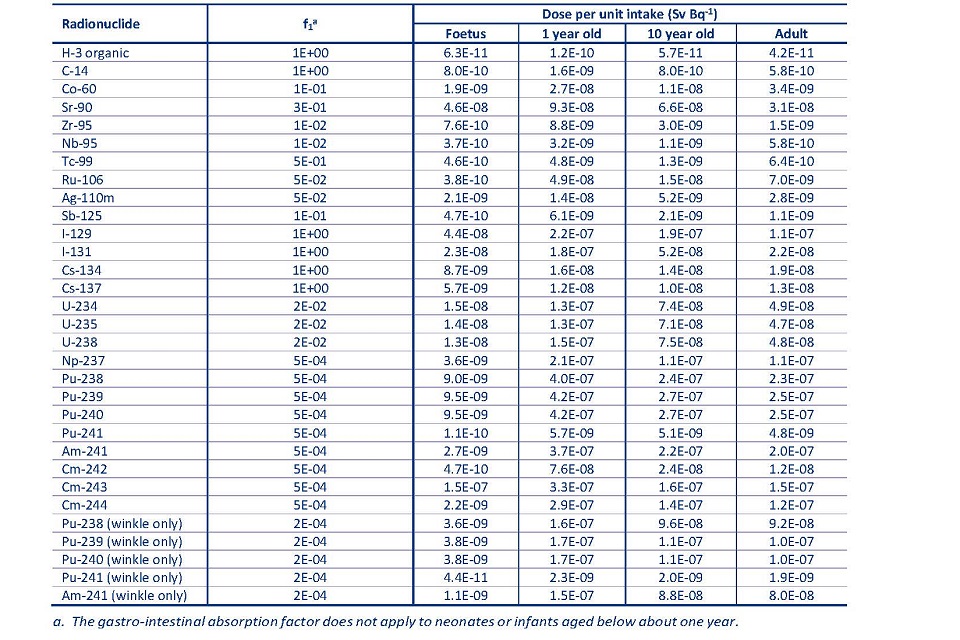
Table A5. Committed effective doses per unit intake for inhalation
| Radionuclide | Lung absorption type | f1a | Foetus - dose per unit intake (Sv Bq-1) | 1 year old - dose per unit intake (Sv Bq-1 | 10-year-old - dose per unit intake (Sv Bq-1 | Adult - dose per unit intake (Sv Bq-1 | Basis for choice of lung absorption type |
|---|---|---|---|---|---|---|---|
| H-3 organic | V | 1E+00 | 6.3E-11 | 1.1E-10 | 5.5E-11 | 4.1E-11 | Organically bound tritium |
| C-14 | M | 1E-01 | 6.6E-11 | 6.6E-09 | 2.8E-09 | 2.0E-09 | ICRP recommended default |
| Co-60 | M | 1E-01 | 1.2E-09 | 3.4E-08 | 1.5E-08 | 1.0E-08 | ICRP recommended default |
| Sr-90 | M | 1E-01 | 1.0E-08 | 1.2E-07 | 5.4E-08 | 3.8E-08 | ICRP recommended default |
| Zr-95 | M | 2E-03 | 4.6E-10 | 2.1E-08 | 9.0E-09 | 6.3E-09 | ICRP recommended default |
| Nb-95 | M | 1E-02 | 1.6E-10 | 5.2E-09 | 2.2E-09 | 1.5E-09 | ICRP recommended default |
| Tc-99 | M | 1E-01 | 8.3E-11 | 1.3E-08 | 5.7E-09 | 4.0E-09 | ICRP recommended default |
| Ru-106 | M | 5E-02 | 4.1E-10 | 1.1E-07 | 4.1E-08 | 2.8E-08 | ICRP recommended default |
| Ag-110m | M | 5E-02 | 1.5E-09 | 2.8E-08 | 1.2E-08 | 7.6E-09 | ICRP recommended default |
| Sb-125 | M | 1E-02 | 2.6E-10 | 1.6E-08 | 6.8E-09 | 4.8E-09 | ICRP recommended default |
| I-129 | F | 1E+00 | 1.5E-08 | 8.6E-08 | 6.7E-08 | 3.6E-08 | ICRP recommended default |
| I-131 | F | 1E+00 | 8.1E-09 | 7.2E-08 | 1.9E-08 | 7.4E-09 | ICRP recommended default |
| Cs-134 | F | 1E+00 | 3.0E-09 | 7.3E-09 | 5.3E-09 | 6.6E-09 | ICRP recommended default |
| Cs-137 | F | 1E+00 | 2.0E-09 | 5.4E-09 | 3.7E-09 | 4.6E-09 | ICRP recommended default |
| U-234 | M | 2E-02 | 4.9E-08 | 1.1E-05 | 4.8E-06 | 3.5E-06 | ICRP recommended default |
| U-235 | M | 2E-02 | 4.5E-08 | 1.0E-05 | 4.3E-06 | 3.1E-06 | ICRP recommended default |
| U-238 | M | 2E-02 | 4.4E-08 | 9.4E-06 | 4.0E-06 | 2.9E-06 | ICRP recommended default |
| Pu-238 | M | 5E-04 | 1.1E-06 | 7.4E-05 | 4.4E-05 | 4.6E-05 | ICRP recommended default |
| Pu-239 | M | 5E-04 | 1.2E-06 | 7.7E-05 | 4.8E-05 | 5.0E-05 | ICRP recommended default |
| Pu-240 | M | 5E-04 | 1.2E-06 | 7.7E-05 | 4.8E-05 | 5.0E-05 | ICRP recommended default |
| Pu-241 | M | 5E-04 | 1.4E-08 | 9.7E-07 | 8.3E-07 | 9.0E-07 | ICRP recommended default |
| Am-241 | M | 5E-04 | 3.2E-07 | 6.9E-05 | 4.0E-05 | 4.2E-05 | ICRP recommended default |
| Cm-242 | M | 5E-04 | 5.1E-08 | 1.8E-05 | 7.3E-06 | 5.2E-06 | ICRP recommended default |
| Cm-243 | M | 5E-04 | 3.1E-05 | 6.1E-05 | 3.1E-05 | 3.1E-05 | ICRP recommended default |
| Cm-244 | M | 5E-04 | 2.6E-07 | 5.7E-05 | 2.7E-05 | 2.7E-05 | ICRP recommended default |
a. The gastro-intestinal absorption factor does not apply to neonates or infants aged below about one year.
b. No default inhalation class recommended – most restrictive value cited by ICRP used.
Table A6. Collective dose commitment (man Sv per Bq discharged, integrated to 500 years): atmospheric discharges
| Radionuclide | UK | EU | World |
|---|---|---|---|
| H-3 | 6.7 E-16 | 1.2E-15 | 1.5E-15 |
| C-14 | 2.0E-13 | 1.0E-12 | 1.3E-11 |
| Kr-85 | 4.3E-18 | 1.5E-17 | 2.6E-16 |
| Sr-90 | 1.9E-12 | 8.8E-12 | 8.8E-12 |
| Ru-106 | 3.1E-13 | 4.2E-13 | 4.2E-13 |
| Sb-125 | 1.2E-13 | 1.7E-13 | 1.7E-13 |
| I-129 | 4.5E-11 | 2.1E-10 | 2.9E-10 |
| I-131 | 7.8E-13 | 4.8E-13 | 4.8E-13 |
| Cs-137 | 1.8E-12 | 6.1E-12 | 6.1E-12 |
| Pu-239 & Pu-240 | 1.7E-10 | 2.4E-10 | 2.4E-10 |
| Pu-241 | 3.0E-12 | 4.4E-12 | 4.4E-12 |
| Am-241 | 1.4E-10 | 2.0E-10 | 2.0E-10 |
a. EU is defined as the population of the EU12 member states, 360 million (19).
Table A7. Collective dose commitment (man Sv per Bq discharged, integrated to 500 years): liquid dischargesᵃ
| Radionuclide | UK | EU | World |
|---|---|---|---|
| H-3 | 4.6E-19 | 1.9E-18 | 3.5E-17 |
| C-14 | 2.0E-13 | 6.6E-13 | 6.8E-12 |
| Co-60 | 6.7E-14 | 1.9E-13 | 2.4E-13 |
| Sr-90 | 7.0E-16 | 1.8E-15 | 3.0E-15 |
| Zr-95 | 7.3E-17 | 1.5E-16 | 1.6E-16 |
| Nb-95 | 1.7E-17 | 3.5E-17 | 3.8E-17 |
| Tc-99 | 2.5E-15 | 7.6E-15 | 9.5E-15 |
| Ru-106 | 1.9E-14 | 5.1E-14 | 5.6E-14 |
| I-129 | 1.9E-14 | 5.7E-14 | 2.2E-13 |
| Cs-134 | 1.3E-14 | 3.0E-14 | 4.6E-14 |
| Cs-137 | 1.6E-14 | 4.1E-14 | 7.1E-14 |
| Ce-144 | 6.9E-17 | 1.8E-16 | 2.0E-16 |
| Pu-239 & Pu-240 | 3.0E-13 | 8.4E-13 | 9.8E-13 |
| Pu-241 | 2.5E-14 | 7.1E-14 | 7.9E-14 |
| Am-241 | 1.3E-12 | 3.6E-12 | 3.9E-12 |
| Cm-242 | 2.3E-15 | 6.1E-15 | 6.8E-15 |
| Cm-243 & Cm-244 | 4.3E-14 | 1.1E-13 | 1.2E-13 |
a. The collective dose factors include the contribution from the first decay product where appropriate. b. EU is defined as the population of the EU12 member states, 360 million (19)
11. Appendix B
Supporting monitoring and dose data
Table B1. Radioactivity in seaweed, 2021
| Mean concentration (Bq kg-1 wet weight) | |||||||||||||
|---|---|---|---|---|---|---|---|---|---|---|---|---|---|
| Species/Location | Total α | Total β | 14Ca | 60Co | 90Sr | 99Tc | 106Ru | 129I | 134Cs | 137Cs | U(α) | Pu(α) | 241Am |
| Fucus vesiculosis - Nethertown | 13 | 220 | 19 | 0.17 | 0.42 | 480 | <0.55 | <0.33 | <0.07 | 1.8 | 3.3 | 7.1 | 2.8 |
| Fucus vesiculosis - Drigg Barnscar | 19 | 270 | 29 | 0.32 | 0.84 | 690 | <0.58 | <0.98 | <0.07 | 1.2 | 5.9 | 13 | 2.9 |
| Fucus vesiculosis - Walney Island | 13 | 250 | 22 | 0.11 | 0.67 | 440 | <0.53 | <0.44 | <0.07 | 1.3 | 5.4 | 5.2 | 1.3 |
| Porphyra umbilicalis - St Bees | 3.5 | 140 | 20 | - | 0.18 | 1.3 | <0.62 | - | <0.08 | 0.56 | 0.24 | 1.2 | 2.4 |
| Porphyra umbilicalis - Braystones | 6.3 | 160 | 35 | 0.06 | <0.22 | 1.3 | <0.55 | - | <0.07 | 0.86 | 0.33 | 2.0 | 3.1 |
| Porphyra umbilicalis - Sellafield | 5.3 | 160 | 61 | 0.14 | 0.29 | 0.96 | <0.61 | - | <0.08 | 0.56 | 0.26 | 1.7 | 2.7 |
| Porphyra umbilicalis - Seascale Neb | 7.5 | 160 | 33 | 0.10 | <0.40 | 1.4 | <0.58 | - | <0.07 | 0.98 | 0.32 | 2.3 | 4.2 |
| Porphyra umbilicalis - St. Bees - Selker (Av) | 5.6 | 150 | 37 | 0.11 | 0.27 | 1.2 | <0.59 | - | <0.07 | 0.74 | 0.29 | 1.8 | 3.1 |
a. 14C data include natural background
Table B2. Radioactivity in coastal samples of seawater from the Irish Sea, 2021
| Mean concentration (Bq l-1) | |||||||||||||
|---|---|---|---|---|---|---|---|---|---|---|---|---|---|
| Location | Total α | Total β | 3H | 14C | 90Sr | 99Tc | 129I | 137Cs | U(α) | 237Np | Pu(α) | 241Pu | 241Am |
| St Bees - filtrate | <3.0 | 11 | <4.8 | <0.50 | 0.03 | <0.01 | <0.03 | 0.03 | 0.09 | <0.0009 | 0.002 | 0.04 | 0.001 |
| St Bees - solids | 0.14 | 0.11 | - | - | 0.006 | - | - | <0.009 | 0.002 | 0.00003 | 0.02 | 0.07 | 0.04 |
| Sellafield - filtrate | <2.8 | 10 | 5.8 | <0.53 | 0.05 | 0.01 | <0.03 | 0.04 | 0.08 | <0.0008 | 0.003 | 0.04 | 0.001 |
| Sellafield - solids | 0.25 | 0.17 | - | - | 0.007 | - | - | 0.02 | 0.003 | 0.00006 | 0.05 | 0.15 | 0.08 |
| Seascale - filtrate | <2.9 | 10.0 | 4.4 | <0.64 | 0.05 | <0.02 | <0.03 | <0.04 | 0.08 | <0.0009 | 0.004 | 0.04 | 0.002 |
| Neb - solids | 0.21 | 0.16 | - | - | 0.006 | - | - | 0.02 | 0.003 | 0.00005 | 0.04 | 0.14 | 0.07 |
| Drigg - filtrate | <3.1 | 9.7 | <7.5 | 0.47 | 0.04 | <0.02 | <0.03 | 0.04 | 0.09 | <0.0009 | 0.003 | <0.05 | 0.002 |
| Barnscar - solids | 0.13 | 0.15 | - | - | 0.003 | - | - | 0.01 | 0.002 | 0.00002 | 0.02 | 0.08 | 0.04 |
Table B3. Radioactivity in sediment from the West Cumbrian Coast, 2021
| Mean radionuclide concentration (Bq kg-1 dry weight) | |||||||||||||
|---|---|---|---|---|---|---|---|---|---|---|---|---|---|
| Location | Total α | Total β | 60Co | 90Sr | 99Tc | 106Ru | 134Cs | 137Cs | U-α | Pu-α | 241Pu | 241Am | |
| Sand | St Bees | 500 | 370 | 0.30 | - | - | <0.96 | <0.10 | 41 | - | 110 | - | 110 |
| Braystones | 400 | 370 | 0.20 | - | - | <1.0 | <0.11 | 47 | - | 88 | - | 100 | |
| Sellafield | 360 | 300 | 0.18 | - | - | <1.0 | <0.11 | 34 | - | 78 | - | 92 | |
| Seascale Neb | 510 | 430 | 0.14 | - | - | <1.1 | <0.12 | 20 | - | 86 | - | 100 | |
| Drigg Barnscar | 360 | 330 | 0.12 | - | - | <0.93 | <0.11 | 18 | - | 67 | - | 75 | |
| Silt | Ravenglass Ford | 850 | 680 | <0.97 | 7.7 | 9.0 | <10 | <1.2 | 52 | 33 | 150 | 500 | 210 |
| Ravenglass Garth | 390 | 520 | <0.80 | 1.2 | 5.1 | <6.6 | <0.86 | 19 | 18 | 65 | 180 | 95 | |
| Ravenglass Opp Raven Villa | 1,000 | 750 | <1.1 | 12 | 12 | <10 | <1.2 | 71 | 39 | 250 | 690 | 290 | |
| Eskmeals, R Esk south bank downstream of viaduct | 1,100 | 640 | <1.1 | 8.2 | 9.6 | <13 | <1.6 | 70 | 46 | 140 | 470 | 230 | |
| Eskmeals Newbiggin Marsh | 1,700 | 900 | <1.6 | 50 | 31 | <17 | <1.9 | 160 | 61 | 300 | 1,000 | 530 | |
| R Esk Muncaster Rd Bridge; Downstream | 2,700 | 1,000 | 1.9 | 74 | 31 | <19 | <1.7 | 420 | 61 | 660 | 2,200 | 1,100 | |
| Whitehaven Outer Harbour (south) | 520 | 380 | <1.4 | 0.54 | 7.8 | <15 | <1.6 | 75 | 19 | 110 | 330 | 140 | |
| Silt from River Calder | 660 | 430 | <0.69 | 6.7 | 2.3 | <7.0 | <0.85 | 44 | 36 | 140 | 450 | 190 | |
| Silt from River Ehen | 2,600 | 940 | <1.2 | 18 | 42 | <13 | <1.3 | 600 | 84 | 850 | 1,800 | 1,300 | |
| Waberthwaite | 3,300 | 850 | <1.4 | 42 | 25 | <16 | <1.6 | 350 | 47 | 860 | 2,300 | 1,100 |
Table B4. Radioactivity in total deposition, 2021
| Mean radionuclide concentration (Bq m-3) | ||||||||||
|---|---|---|---|---|---|---|---|---|---|---|
| Location | Total α | Total β | 3H | 90Sr | 106Ru | 125Sb | 134Cs | 137Cs | Pu- α | 241Am |
| Calder Gate | 27 | <170 | <4,500 | 4.5 | <49 | <12 | <5.5 | 12 | 0.24 | 0.39 |
| Met Station | 48 | <370 | <4,400 | 25 | <46 | <12 | <5.4 | 33 | 0.48 | 1.2 |
| North Gate | 30 | 230 | 5,600 | 38 | <48 | <12 | <5.7 | 74 | 1.2 | 1.2 |
| South Side | 33 | <170 | <4,500 | 3.6 | <43 | <12 | <4.9 | 6.2 | 0.44 | 0.31 |
| West Ring Road | 43 | 210 | <4,300 | 12 | <56 | <14 | <6.5 | <9.0 | 0.26 | 0.87 |
Table B5. Radioactivity in grass, 2021
| Mean concentration (Bq kg-1 {wet weight}) | ||||||||||||||
|---|---|---|---|---|---|---|---|---|---|---|---|---|---|---|
| Location | Total α | Total β | 3H | 14Ca | 14Cb | 90Sr | 99Tc | 106Ru | 125Sb | 134Cs | 137Cs | U- α | Pu- α | 241Am |
| Calder Gate | 8.0 | 110 | 5.0 | 27 | 1.2 | 2.1 | 3.1 | <0.86 | <0.32 | <0.10 | 2.7 | 0.29 | 0.15 | 0.14 |
| Met Station | 3.4 | 100 | 11 | 23 | <0.93 | 8.2 | 1.7 | <1.1 | <0.31 | <0.12 | 5.0 | 0.06 | 0.35 | 0.32 |
| North Gate | 3.2 | 140 | 15 | 27 | <1.0 | 22 | 2.6 | <0.91 | <0.33 | <0.09 | 26 | 0.12 | 0.31 | 0.21 |
| South Side | 5.3 | 130 | 5.5 | 26 | <1.0 | 1.4 | 8.6 | <0.91 | <0.27 | <0.10 | 2.4 | 0.18 | 0.10 | 0.14 |
| West Ring Rd | 4.0 | 110 | <9.2 | 22 | <0.87 | 1.2 | 3.8 | <0.98 | <0.30 | <0.12 | 3.0 | 0.24 | 0.26 | 0.27 |
a. 14C data includes background. b. Excluding natural background calculated assuming 218 Bq natural 14C per kg carbon.
Table B6. Radioactivity in soil, 2021
| Mean concentration (Bq kg-1 {wet weight}) | |||||||||||||
|---|---|---|---|---|---|---|---|---|---|---|---|---|---|
| Location | Total α | Total β | 3H | 14Ca | 14Cb | 90Sr | 106Ru | 125Sb | 134Cs | 137Cs | U- α | Pu- α | 241Am |
| Calder Gate | 570 | 610 | 9.6 | 5.3 | 1.8 | 2.6 | <14 | <4.2 | <1.4 | 84 | 49 | 27 | 12 |
| Met Station | 700 | 770 | 3.0 | 4.8 | 0.49 | 12 | <19 | <5.3 | <1.7 | 200 | 61 | 77 | 29 |
| North Gate | 1,000 | 1,000 | 10 | 6.2 | 1.6 | 28 | <14 | <5.2 | <1.5 | 430 | 65 | 230 | 37 |
| South Side | 740 | 430 | 5.7 | 8.1 | <0.40 | 2.3 | <15 | <4.7 | <1.8 | 57 | 65 | 11 | 4.5 |
| West Ring Road | 640 | 740 | 11 | 5.5 | 0.59 | 5.1 | <22 | <5.8 | <1.9 | 130 | 56 | 47 | 41 |
a. 14C data includes background. b. Excluding natural background calculated assuming 218 Bq natural 14C per kg carbon.
Table B7. Summary of doses to marine critical group from marine foodstuffs (µSv), 2021
| Radionuclide | Cod | Plaice | Lobsters | Crabs | |||||||||||||
|---|---|---|---|---|---|---|---|---|---|---|---|---|---|---|---|---|---|
| Adult | Child | Infant | Foetus | Adult | Child | Infant | Foetus | Adult | Child | Infant | Foetus | Adult | Child | Infant | Foetus | ||
| Carbon-14a | 0.15 | 0.04 | 0.02 | 0.20 | 0.35 | 0.10 | 0.05 | 0.48 | 0.34 | 0.09 | 0.05 | 0.47 | 0.34 | 0.09 | 0.05 | 0.47 | |
| Cobalt-60 | - | - | - | - | - | - | - | - | - | - | - | - | 0.005 | 0.003 | 0.002 | 0.003 | |
| Strontium-90 | - | - | - | - | - | - | - | - | - | - | - | - | 0.01 | 0.006 | 0.002 | 0.02 | |
| Technetium-99 | 0.003 | 0.001 | 0.001 | 0.002 | 0.04 | 0.02 | 0.01 | 0.03 | 0.56 | 0.23 | 0.21 | 0.40 | 0.04 | 0.02 | 0.02 | 0.03 | |
| Ruthenium-106 | 0.02 | 0.01 | 0.008 | 0.001 | 0.05 | 0.02 | 0.02 | 0.003 | - | - | - | - | 0.07 | 0.03 | 0.03 | 0.004 | |
| I | odine-129 | - | - | - | - | - | - | - | - | 0.32 | 0.11 | 0.03 | 0.13 | - | - | - | - |
| Caesium-137 | 0.54 | 0.08 | 0.02 | 0.24 | 0.50 | 0.08 | 0.02 | 0.22 | 0.11 | 0.02 | 0.005 | 0.05 | 0.05 | 0.008 | 0.003 | 0.02 | |
| Neptunium-237 | - | - | - | - | - | - | - | - | - | - | - | - | - | - | - | - | |
| Plutonium-alpha | 0.01 | 0.002 | 0.0008 | 0.0004 | 0.03 | 0.007 | 0.003 | 0.001 | 0.26 | 0.06 | 0.02 | 0.01 | 0.56 | 0.12 | 0.05 | 0.02 | |
| Plutonium-241 | - | - | - | - | - | - | - | - | - | - | - | - | - | - | - | - | |
| Americium-241 | 0.01 | 0.003 | 0.001 | 0.0002 | 0.04 | 0.008 | 0.003 | 0.0005 | 1.5 | 0.33 | 0.14 | 0.02 | 1.7 | 0.37 | 0.15 | 0.02 | |
| Curium-alpha | - | - | - | - | - | - | - | - | - | - | - | - | - | - | - | - | |
| Total | 0.74 | 0.14 | 0.06 | 0.44 | 1.0 | 0.22 | 0.11 | 0.73 | 3.1 | 0.83 | 0.45 | 1.1 | 2.8 | 0.65 | 0.30 | 0.59 |
| Radionuclide | Nephrops | Winkles | Mussels | ||||||||||
|---|---|---|---|---|---|---|---|---|---|---|---|---|---|
| Adult | Child | Infant | Foetus | Adult | Child | Infant | Foetus | Adult | Child | Infant | Foetus | ||
| Carbon-14a | 0.11 | 0.03 | 0.02 | 0.15 | 0.11 | 0.03 | 0.02 | 0.15 | 0.09 | 0.03 | 0.01 | 0.13 | |
| Cobalt-60 | - | - | - | - | 0.008 | 0.005 | 0.003 | 0.005 | 0.005 | 0.003 | 0.002 | 0.003 | |
| Strontium-90 | - | - | - | - | 0.08 | 0.04 | 0.01 | 0.13 | 0.02 | 0.009 | 0.003 | 0.03 | |
| Technetium-99 | 0.10 | 0.04 | 0.04 | 0.07 | 0.05 | 0.02 | 0.02 | 0.03 | 0.05 | 0.02 | 0.02 | 0.04 | |
| Ruthenium-106 | - | - | - | - | 0.05 | 0.02 | 0.02 | 0.003 | 0.03 | 0.01 | 0.01 | 0.002 | |
| Iodine-129 | - | - | - | - | 0.08 | 0.03 | 0.008 | 0.03 | - | - | - | - | |
| Caesium-137 | 0.09 | 0.01 | 0.004 | 0.04 | 0.13 | 0.02 | 0.006 | 0.06 | 0.04 | 0.007 | 0.002 | 0.02 | |
| Neptunium-237 | - | - | - | - | 0.003 | 0.0007 | 0.0003 | 0.0001 | - | - | - | - | |
| Plutonium-alpha | 0.52 | 0.11 | 0.04 | 0.02 | 2.5 | 0.53 | 0.21 | 0.09 | 2.7 | 0.58 | 0.22 | 0.10 | |
| Plutonium-241 | - | - | - | - | 0.17 | 0.04 | 0.01 | 0.004 | 0.19 | 0.04 | 0.01 | 0.004 | |
| Americium-241 | 2.0 | 0.44 | 0.19 | 0.03 | 3.6 | 0.80 | 0.34 | 0.05 | 4.0 | 0.88 | 0.37 | 0.05 | |
| Curium-alpha | - | - | - | - | 0.05 | 0.01 | 0.005 | 0.05 | - | - | - | - | |
| Total | 2.8 | 0.64 | 0.29 | 0.31 | 6.8 | 1.5 | 0.64 | 0.60 | 7.1 | 1.6 | 0.65 | 0.38 |
a. Background corrected data.
Table B8. Summary of doses to terrestrial critical group from terrestrial foodstuffs and inhalation (µSv)a, 2021

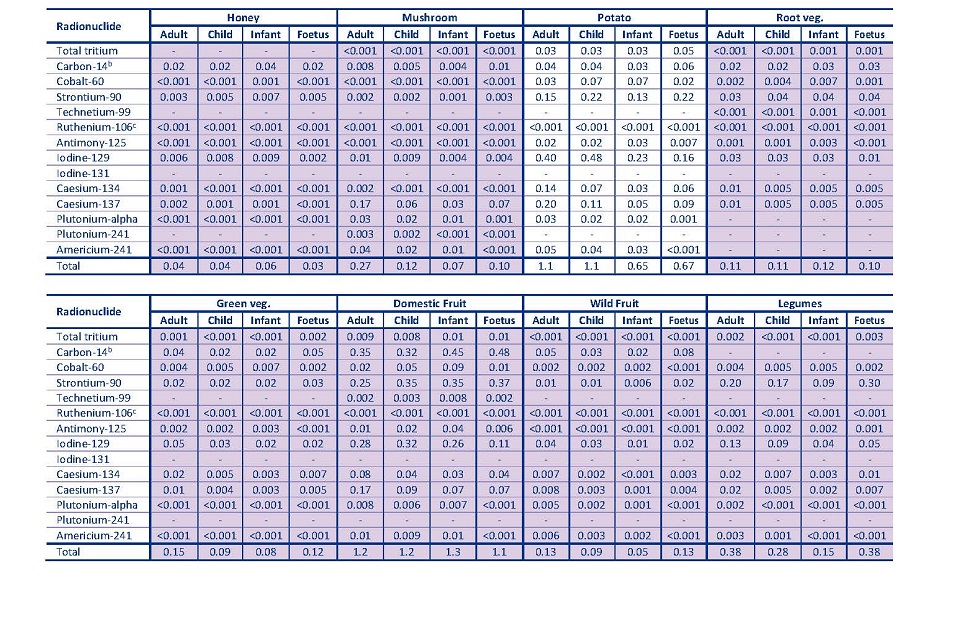
Table B8. Summary of doses to terrestrial critical group from terrestrial foodstuffs and inhalation (μSv)a, 2021 cont.

Table B9. Summary of doses to the terrestrial critical group from seafood consumption (µSv) in 2021
| Radionuclide | Adult | Child | Infant | Foetus |
|---|---|---|---|---|
| Carbon-14a | 0.16 | 0.04 | 0.02 | 0.22 |
| Technetium-99 | 0.007 | 0.003 | 0.003 | 0.005 |
| Ruthenium-106 | 0.02 | 0.01 | 0.008 | 0.001 |
| Caesium-137 | 0.36 | 0.06 | 0.02 | 0.16 |
| Plutonium-alpha | 0.01 | 0.002 | 0.0009 | 0.0004 |
| Americium-241 | 0.02 | 0.004 | 0.002 | 0.0002 |
| Total | 0.58 | 0.12 | 0.05 | 0.39 |
a. Calculated using background corrected activity concentrations
Table B11. Modelled concentrations of Ru-106 in terrestrial foodstuffs (Bq kg-1 or Bq l-1) in 2021
| Milk | Beef | Mutton | Liver | Green Veg. | Root Veg. | Fruit | Poultry | Eggs |
|---|---|---|---|---|---|---|---|---|
| 2.16E-07 | 1.17E-04 | 1.70E-04 | 1.70E-04 | 7.41E-04 | 6.69E-06 | 6.47E-05 | 5.39E-08 | 4.62E-08 |
Figure B1. – Technetium-99 in Fucus vesiculosus at Nethertown
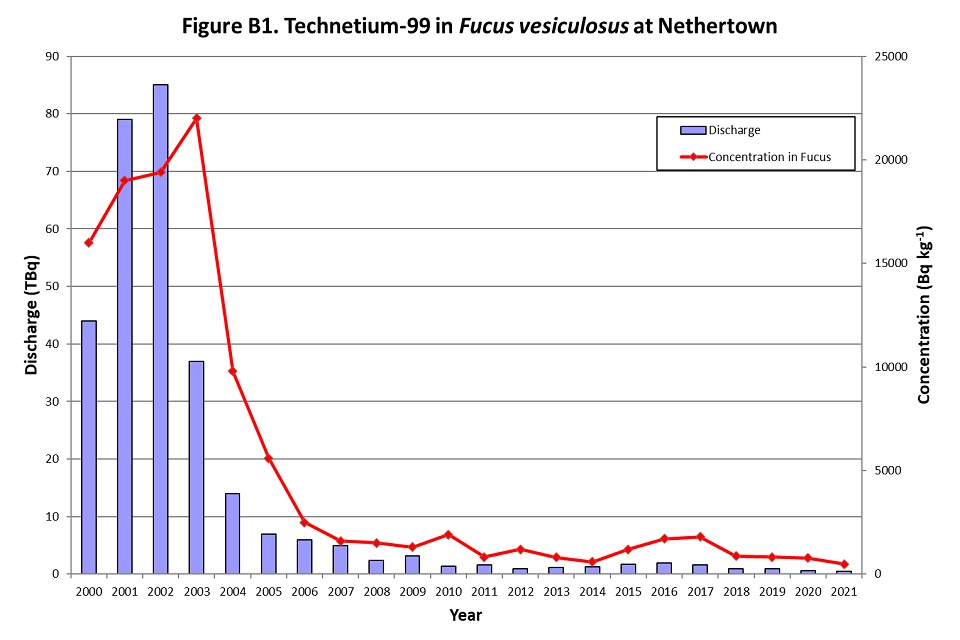
Figure B2. – Caesium-137 in seawater filtrate at Sellafield beach

Figure B3. – Plutonium-alpha in seawater filtrate at Sellafield beach
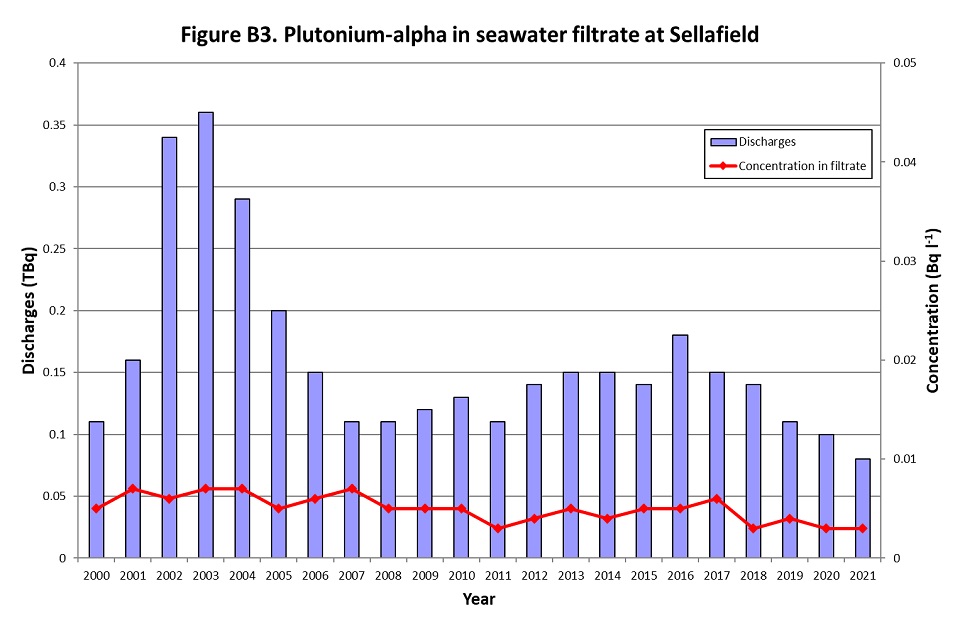
Figure B4. – External gamma dose rates at Newbiggin compared to sediment

12. Appendix C
Representative person dose calculations
A representative person is defined as an individual receiving a dose that is representative of the more highly exposed individuals in the population¹.
This term is the equivalent of, and replaces, ‘average member of the critical group’ described in previous ICRP Recommendations.
The representative person approach is applied in the RIFE series of publications. This approach applies habit data, collected by Cefas through surveys of the local population, to identify realistic profiles of foodstuff consumption and occupancy habits (e.g. time spent over sediment) for groups of individuals in the local population.
The profiles are deliberately aligned to the habits and locations where groups of individuals may be expected to receive the highest radiological doses. Dose profiles are based on the 2018 comprehensive habit survey².
An assessment was conducted for this report applying the RIFE dose profiling methodology using the Cefas habit data for 2017 to 2021 (as applied in RIFE).
Local terrestrial food habits are updated every five years whereas the marine habits vary annually. The data for concentrations in foodstuffs, external dose rates and direct shine were taken from the relevant Sellafield Limited Discharges and Environmental Monitoring reports.
This assessment of dose profiles therefore differs from that presented in RIFE as it more closely represents the doses attributed to the Sellafield site as it does not include the contributions from naturally occurring radioactivity or from anthropogenic radionuclides released from other industries.
The results from the dose profiling can therefore be directly compared with those obtained from the calculations of doses to members of the critical group used in the Sellafield Ltd reports.
It should be noted that, in line with dose calculations applied elsewhere in this report, the representative persons dose calculations assumed that concentrations at the limit of detection (e.g. < 10 Bq kg-1, indicating the range 0 - 10 Bq kg-1) were at the upper limit of this range (i.e. 10 Bq kg-1).
The doses therefore represent an upper bound to those that would actually be received by the more highly exposed individuals in the population.
Doses to adults are shown in Figure C1 and demonstrate that the 3 highest dose profiles overall were mollusc consumers, occupants over sediment and occupants over saltmarsh.
Doses to the mollusc consumers in 2021 were 45 µSv with 36% of this dose being from external gamma irradiation whilst on sediments. The consumption of molluscs accounted for 55% of the total.
There was a small reduction in total dose to that reported in 2020 (71 µSv). Doses in 2021 for occupants over sediment were 32 µSv with 96% of this dose being from exposure to external gamma irradiation whilst on sediments and the remainder being mostly from the consumption of marine foodstuffs.
The radiological impact of operations at Sellafield section of this report presents the dose to adult members of the marine critical group as 24 µSv through marine foodstuff consumption, and a total dose, including exposure on sediments, terrestrial pathways and direct shine as 60 µSv.
This demonstrates that the dose assessment methodology applied in the radiological impact of operations at Sellafield section of this report provides conservative results.
Doses from terrestrial exposure pathways in 2021 to adult representative persons were highest for the profile Local Inhabitants (0.25 – 0.5 km).
This group received a dose of 4.9 µSv. This dose was from direct shine from the site (60%), consumption of terrestrial foodstuffs (27%) and inhalation (13%).
The estimated dose to adults in the terrestrial critical group, presented earlier in this report, was 12 µSv which is higher than the estimates for the representative person and demonstrates that the methodology in the radiological impact of operations at Sellafield section provides conservative results.
Figure C2 presents the doses to children. As found for adults the 2 highest groups overall were Mollusc Consumers (16 µSv) and Occupants over Sediment (16 µSv), with doses being approximately one third of those estimated for adults.
Doses to children where terrestrial pathways dominated were highest for Local Inhabitants (0.25 – 0.5 km), with a dose of 4.4 µSv being estimated for 2021 with 66% due to direct shine.
It should be noted that the representative persons methodology assumes that adults, children and infants have the same direct shine exposure. The dose to a child member of the terrestrial critical group, detailed earlier in this report, was 6.5 µSv.
Although the Cefas habit data (2) did not identify any children living close to the site, for the sake of completeness an additional 2.9 µSv due to direct shine from the site could be determined based on child habit data.
The total dose of 10 µSv is in broad agreement with that estimated for the representative person (4.4 µSv), noting the differences in the assumption regarding direct shine exposure, and demonstrates that the methodology in the radiological impact of operations at Sellafield section provides conservative results.
Figure C3 presents the doses to infants using the representative persons methodology. The 2 highest groups overall were Local Inhabitants (0.25 - 0.5 km) (4.3 µSv) and root vegetable consumers (4.0 µSv).
Doses were lower than the doses to adult or child representative persons. The dose assessment earlier in this report calculated a dose to infant members of the terrestrial critical group of 4.4 µSv with an additional 2.9 µSv being calculated from direct shine from the site based on Cefas habit data (2).
The doses from the different methodologies are in broad agreement, noting the differences in the assumption regarding direct shine exposure, although demonstrate that the methodology in the radiological impact of operations at Sellafield section provides conservative results.
In conclusion, the representative persons methodology, as applied in the RIFE series of reports, provides realistic estimates of peak doses to the most exposure individuals in the population and the critical group approach applied by Sellafield Ltd is more conservative.
There is therefore no requirement to modify the critical group methodology applied in this report for determining radiological doses to the public.
References
-
International Commission on Radiological Protection (2006). Assessing dose of the representative personfor the purpose of radiation protection of the public and the optimisation of radiological protection: Broadening the process. ICRP Publication 101. Ann. ICRP 36 (3).
-
Greenhill B J and Clyne F J (2021). Radiological habits survey: Sellafield Review, 2020. Environment Report RL01/21. Cefas, Lowestoft (under contract to the EA and the FSA).
-
Environment Agency, Food Standards Agency, Foods Standards Scotland, Natural Resources Wales. Northern Ireland Environment Agency and Scottish Environmental Protection Agency (2018). Radioactivity in Food and the Environment, 2017. RIFE-23. EA, FSA, FSS, NRW, NIEA and SEPA; Preston, London, Aberdeen, Cardiff and Stirling.
-
Environment Agency, Food Standards Agency, Foods Standards Scotland, Natural Resources Wales. Northern Ireland Environment Agency and Scottish Environmental Protection Agency (2022). Radioactivity in Food and the Environment, 2021. RIFE-27. EA, FSA, FSS, NRW, NIEA and SEPA; Preston, London, Aberdeen, Cardiff and Stirling
Table C1. Summary of representative person dose calculations for various age groups. 2021. Highlighted entries denote top two dose contribution pathways per age and source category.

Figure C1. Radiological doses to adult representative persons (2017-2021)

Figure C2. Radiological doses to child representative persons (2017-2021)
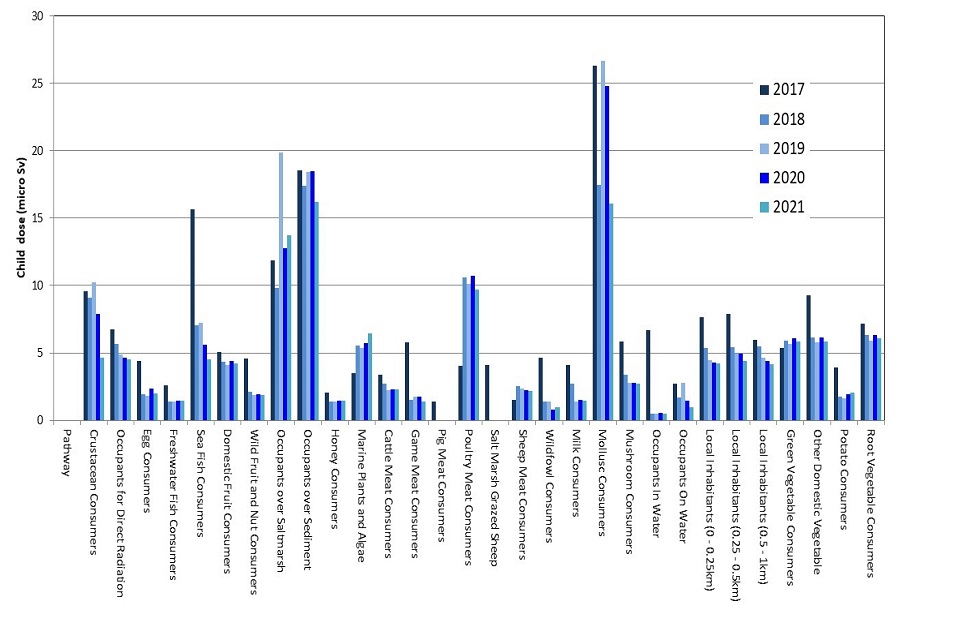
Figure C3. Radiological doses to infant representative persons (2017-2021)
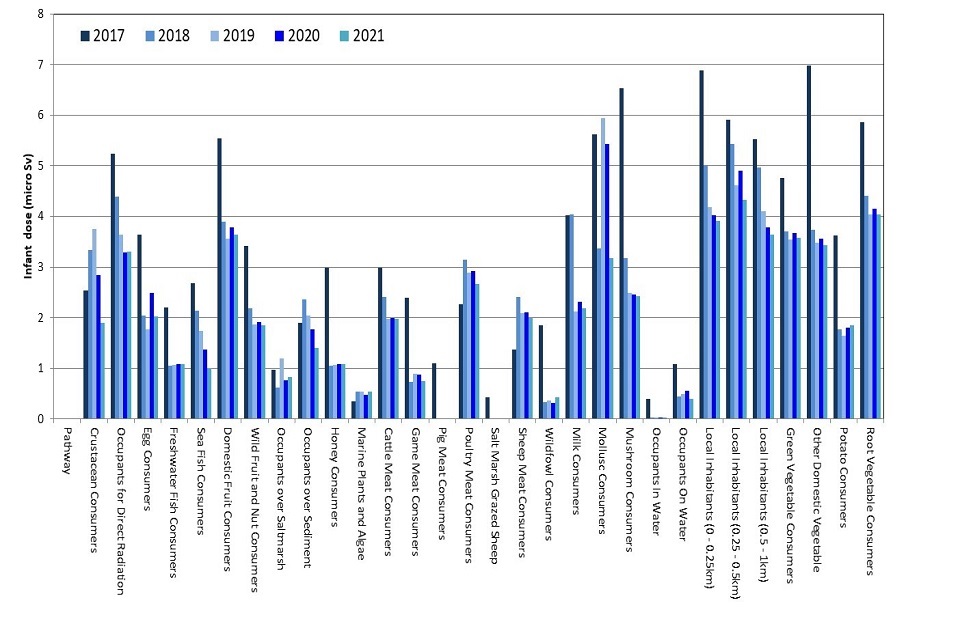
13. Glossary
Glossary of terms and abbreviations
- Absorbed radiation dose - Quantity of energy imparted by ionising radiation to unit mass of matter such as tissue. The unit is the Gray (Gy). 1 Gy = 1 joule per kilogram.
- Activation products - Radionuclides produced by the interaction of neutrons with stable nuclides. *Activity - See radioactivity.
- Alpha activity - Radionuclides that decay by emitting an alpha particle. The latter consists of two protons and two neutrons.
- ALARA (As Low as Reasonably Achievable) - Radiation doses from a source of exposure are ALARA when they are consistent with the relevant dose or target standard and have been reduced to a level that represents a balance between radiological and other factors, including social and economic. The level of protection may then be said to be optimised. *Aquifer A - body of permeable rock which can transmit and allow abstraction of groundwater.
- Authorisation - Permission given by regulatory authority under the Radioactive Substances Act or Environmental Protection Act - to dispose of respectively radioactive and non-radioactive waste, subject to conditions.
- Basic Safety Standards Directive (BSS) - European Community Directive 80/836/Euratom, Basic Safety Standards for the Health Protection of the General Public and Workers against the Dangers of Ionising Radiation. These standards were adopted as European Law in 1980. A revised Directive 96/29/Euratom was adopted in May 1996 for implementation in Member States by May 2000. The Radioactive Substances (Basic Safety Standards) Direction 2000 is the means by which the BSS Directive has been implemented in England and Wales, and in Scotland, with respect to the Radioactive Substances Act 1993. Other provisions of the BSS Directive were implemented through the Ionising Radiation Regulations 1999.
- Becquerel - The SI unit of radioactivity equal to one transformation per second.
- BAT (Best Available Technique) - “Best” – means the most effective techniques for achieving a high level of protection of the environment as a whole. “Available” – means techniques developed on a scale which allows them to be used in the relevant industrial sector, under economically and technically viable conditions, taking into account of the costs and advantages. “Techniques” – includes both the technology and the way the installation is designed, built, maintained, operated and decommissioned. Application of BAT is central to PPC compliance and guidance on what constitutes BAT is provided by the EA.
- Beta activity - Radionuclides that decay by emitting a beta particle (an electron with high energy).
- Borehole - A hole that is drilled into the ground, generally used to locate water or oil and to characterise ground conditions.
- CPS - Carbon Price Support.
- Cefas - The Centre for Environment, Fisheries and Aquaculture Science is a scientific research and advisory centre for fisheries management and environmental protection. It is an Agency of the UK Government’s Department for Environment, Food and Rural Affairs (Defra). It was formed in 1997 from the Fisheries Research Laboratory of MAFF and its Lowestoft laboratory carries out habit surveys and monitoring of radioactivity in the environment on behalf of the Food Standards Agency.
- CHP - Combined Heat and Power Plant.
- CCL - Climate Change Levy.
- Collective dose - See dose.
- Committed effective dose - See dose
- Critical group - A group of members of the public whose radiation exposure is reasonably homogeneous and is typical of the people receiving the highest dose from a radiation source. The critical group dose is calculated as the mean effective dose to members of the group. The average member of the critical group is equivalent to the ‘representative person’.
- Defra (Department for Environment, Food and Rural Affairs) - Formed in 2001 from MAFF and is the environmental section of the Department of Environment, Transport and the Regions (DETR). It is the sponsoring department for the EA, and is responsible inter alia for environmental policy in England, including that for the management and disposal of radioactive wastes.
- Direct radiation - Term used to refer to radiation direct from a nuclear site as distinct from the radiation emitted from discharged radioactive wastes.
- Dose - A measure of radiation received, which may be quantified in several different ways. The dose quantities most commonly referred to are defined below. In this document it is used primarily to mean the ‘effective dose’ received by members of critical groups.
- Absorbed dose - The mean energy imparted by ionising radiation to matter in a given volume divided by the mass of the matter. Normally used in the context of the dose averaged over an organ or tissue. The unit is the Gray (Gy) (see inside front cover).
- Equivalent dose - The absorbed dose in a tissue or organ weighted by the radiation weighting factor (e.g. alpha particles = 20, beta particles = 1, gamma rays = 1) which allows for the different effectiveness of various types of ionising radiations in causing harm to tissues. The unit is the Sievert (Sv) (see inside front cover).
- Effective dose - The sum of the equivalent doses in all tissues and organs of the body from internal and external radiation multiplied by the tissue weighting factor (e.g. skin = 0.01, thyroid = 0.05, red bone marrow = 0.12, gonads = 0.20). It allows the various equivalent doses in the body to be represented by a single number giving a broad indication of the detriment to the health of an individual from exposure to ionising radiation, regardless of the energy and type of radiation. For comparison with dose limits, the term takes on a specific meaning (see below).
- Committed effective dose - The time integral of the effective dose from ingested and inhaled radioactivity delivered over 50 years (adults, who are cautiously assumed to be 20 years old at the time of intake) or to age 70 years (children). For a particular radionuclide, it is a function of the distribution within and clearance from the body and also the radioactive half-life. For radionuclides which are cleared quickly from the body (e.g. caesium-137) or which have a short half-life (e.g. sulphur-35), most of the committed effective dose is delivered in the year in which the intake of activity took place. For others, such as plutonium, the committed dose is delivered over the remaining lifetime of the individual and so the dose in the year of intake is much lower than the committed dose.
- Effective dose - (definition used for calculation of critical group doses and for comparison with dose limits) The overall annual effective dose is the sum of committed effective doses from intakes of radionuclides in a given year and the effective dose from external irradiation in that year. It is this quantity that should be compared with the annual limit on effective dose (dose limit).
- Collective dose - The summation of individual effective doses received by the population of a defined geographical area over a defined period of time. A 500-year integration period is used in this report (see paragraph 20 of Appendix A). The unit is the man sievert (man Sv).
- Dose constraint - A restriction on annual dose to an individual from a single source, applied at the design and planning stage of any activity in order to ensure that when aggregated with doses from all sources, excluding natural background and medical procedures, the dose limit is not exceeded.
- Dose limit - For the purpose of discharge authorisations, since 1986 the UK has applied a dose limit of 1 mSv (1000 µSv) per annum to members of the public from all man-made sources of radiation (other than medical exposure). This limit is now incorporated into UK law (see Basic Safety Standards Directive).
- Drift Soil - deposits left after the retreat of glaciers and ice- sheets.
- EA (Environment Agency) - The leading public body for protecting and improving the environment in England and Wales (see Defra).
- Effective dose - See dose.
- EUETS - European Union Emissions Trading Scheme.
- Environment Act 1995 - The legislation giving the EA its powers, aims and objectives.
- Environmental Permitting (England and Wales) Regulations (2016) - These extend the permitting regime introduced in 2010 which included water discharge consents, groundwater permits and radioactive substances regulations.
- ESC - Environmental Screening Criteria. A concentration, generally defined by regulation, of a hazardous or non- hazardous chemical in an environmental sample(s), that if exceeded could result in harm to human health or the environment.
- Equivalent dose - See dose.
- Fission products - nuclear fission is the splitting of a heavy atomic nucleus such as uranium into (usually) two nuclei, either spontaneously or under the impact of another particle, with resulting increase of energy. The two nuclei are called fission products.
- Fluorinated Greenhouse Gases - Powerful greenhouse gases that trap heat in the atmosphere and contribute to global warming. The most commonly used fluorinated greenhouse gases belong to a class of chemicals known as hydrofluorocarbons (HFCs) and are being used to replace ozone depleting substances, an example being refrigeration and air conditioning equipment.
- Food Standards Agency - Formed in April 2000 from parts of MAFF and the Department of Health. It is responsible for food safety issues in the UK. Although it is a government agency it does not report to a specific minister and is free to publish any advice it issues. It is accountable to Parliament through Health Ministers and to the devolved administrations in Scotland, Wales and Northern Ireland for its activities within their respective areas.
- Gray - The SI unit of absorbed dose.
- Groundwater - Term for water that completely fills cracks and voids within rock or soil below the ground surface and which, in principle, can be extracted from a well or * discharged to a spring.
- Groundwater Monitoring Well - A borehole into which a piezometer and headworks have been installed. The purpose of which is to provide controlled access to groundwater in order to obtain quality samples and hydrogeological data.
- GWP - Global Warming Potential
- Half-life (radioactive) - The time taken for the radioactivity of a radionuclide to decrease to one half of its initial value by radioactive decay. Half-lives range from fractions of a second to millions of years.
- Half-life (biological) - The effective half-life in the human body of a quantity of ingested radioactivity is a function of the radioactive half-life and biokinetic behaviour.
- High Level Waste (HLW) - Waste that is sufficiently radioactive that the generation of heat needs to be taken into account in the design of disposal or storage facilities.
- Historic/Legacy discharges - Effluent discharges from existing and legacy facilities that are not associated with the carrying on of production operations at those facilities, such as remediation, decommissioning and clean-up of the historical legacy.
- HPA (Health Protection Agency) - A non-departmental public body established in 2003 to provide an integrated approach to protecting UK public health. Now UKHSA. Intermediate Level Waste (ILW) - Waste with radioactivity levels exceeding the upper boundaries for low level waste but which does not require heat generation by the waste to be accounted for in the design of disposal or storage facilities.
- ICRP - International Commission on Radiological Protection. An independent group of experts founded in 1928 which provides guidance on principles and criteria in the field of radiological protection. The recommendations are not legally binding but are accepted as the basis for national legislation in most countries including the UK. Ionising Radiation Regulations 1999 (IRRs 1999) - These regulations under the Health and Safety at Work Act 1974 in part implement the European Basic Safety Standards Directive of 1996.
- LOD - Limit of Detection.
- Low level waste (LLW) - Waste containing levels of radioactivity greater than those acceptable for dustbin disposal but not exceeding 4 GBq per tonne of alpha- emitting radionuclides or 12 GBq per tonne of beta-emitting radionuclides.
- LLWR - The UK’s national low level radioactive waste facility, located close to the West Cumbrian coastline in the north-west of England.
- LQ - Land Quality group at Sellafield Ltd.
- MAFF (Ministry of Agriculture, Fisheries and Food) - Superseded by Defra. MAFF’s statutory responsibilities for food safety issues in the UK have been passed to the Food Standards Agency.
- Magnox - A magnesium/aluminium alloy that is used in the manufacture of the canister for uranium fuel metal (‘Magnox fuel’) used in a type of nuclear reactor (‘Magnox reactor’).
- m AOD - metres Above Ordnance Datum.
- meq - Milliequivalents.
- National Dose Assessment Working Group (NDAWG) - Publishes guidance on the assessment of public dose from past, present and future discharges and direct radiation from the nuclear industry and minor users of radioactivity. Membership comprises UK Government agency, nuclear industry and independent experts.
- NDA (Nuclear Decommissioning Authority) - The public body set up in 2005, tasked by Her Majesty’s Government with taking strategic responsibility for the decommissioning of civil public sector nuclear sites in the UK. The NDA owns the 20 nuclear legacy sites in the UK including the operating and decommissioning plants at Sellafield in West Cumbria. The NDA does not carry out the operations or clean-up work itself but places contracts with Sellafield Ltd who are responsible for operations on site.
- NIEA - Northern Ireland Environment Agency.
- NNL - National Nuclear Laboratory.
- NRPB (National Radiological Protection Board) - Merged with the Health Protection Agency on 1 April 2005 forming its new Radiation Protection Division. An independent statutory body set up by the Radiological Protection Act 1970 to advance the acquisition of knowledge about the protection of mankind from radiation hazards and to provide information and advice on matters relating to radiological protection and radiation hazards, including the interpretation of ICRP recommendations.
- NRW - Natural Resources Wales.
- ONR (Office for Nuclear Regulation) - Part of the Health and Safety Executive. It is responsible for enforcing legislation relating to nuclear safety under the nuclear installations Act 1965.
- OSPAR Convention - The Oslo Paris Convention. Contracting parties (including the UK) have signed up to deliver the North- East Atlantic Environment Strategy which includes the OSPAR Radioactive Substances Strategy. This includes a strategic objective, with regard to radioactive substances, to prevent pollution of the OSPAR maritime area from ionising radiation. The Radioactive Substances strategy includes numerous different elements, relating to discharges, concentrations and application of BAT.
- Ozone Depleting Substances (ODS) - Substances that, if allowed to escape, damage the ozone layer in the upper atmosphere. Ozone depleting substances include chlorofluorocarbons (CFCs) and hydrochlorofluorocarbons (HCFCs). Many ODS are banned or are being phased out by the Fluorinated Greenhouse Gases Regulations 2009.
- PHE (Public Health England) - An executive agency of the Department of Health established 1 April 2013 to bring together public health specialists, including those in the Health Protection Agency, to form a single organisation tasked with public health protection. PHE’s Centre for Radiation, Chemical and Environmental Hazards provides expert advice on all aspects of radiological protection. Now replaced by UKHSA.
- Piezometer - Individual boreholes that contain multi-level installations are made up of a number of individual access pipes that incorporate a screen interval that monitors a selected depth. These individual access pipes are referred to as piezometers. In the Sellafield site numbering system, the deepest piezometer in an individual borehole is labelled as “p1”. Successively shallower piezometers are labelled as “p2”, “p3”, and “p4” (as appropriate) with the highest number representing the shallowest piezometer interval in that individual borehole.
- PPC - Pollution Prevention and Control Regulations 2000.
- Quarterly Notification Level (QNL) - Quarterly discharge or disposal levels that the EA may specify in RSA authorisations. They enable the application of BAT to be monitored by the EA. Exceeding a QNL requires the operator to submit a written justification of the BPM used to limit discharges.
- Radioactive Substances Act (RSA) 1960, 1993 - Statutory legislation to control the keeping and use of radioactive substances and the accumulation discharge or disposal of radioactive waste.
- Radioactive waste - Material that contains radioactivity above the levels specified in the Radioactive Substances Act 1993 and which meets the definition of waste given in the Act.
- PPC - Pollution Prevention and Control Regulations 2000.
- Quarterly Notification Level (QNL) - Quarterly discharge or disposal levels that the EA may specify in RSA authorisations. They enable the application of BAT to be monitored by the EA. Exceeding a QNL requires the operator to submit a written justification of the BPM used to limit discharges.
- Radioactive Substances Act (RSA) 1960, 1993 - Statutory legislation to control the keeping and use of radioactive substances and the accumulation discharge or disposal of radioactive waste.
- Radioactive waste - Material that contains radioactivity above the appropriate levels specified in the Radioactive Substances Act 1993 and which meets the definition of waste given in the Act.
- Radioactivity - The spontaneous disintegration of atomic nuclei. Radioactive substances or the radiation they emit (e.g. alpha particles, beta particles, gamma rays); the rate of radioactive decay. Measured in the standard international (SI) unit, Becquerels (Bq) or their multiples or sub-multiples (see inside front cover).
- Radionuclide - A radioactive isotope of an element.
- Recharge - Generally where rainwater moves downward from the surface towards the water table. Recharge may be influenced by the nature of surface cover, i.e. at Sellafield site recharge in some areas may be low due to hard standing, roads etc.
- Representative person - An individual receiving a dose that is representative of the more highly exposed individuals in the population. This term is equivalent to ‘average member of the critical group’.
- SEMP - Statutory Environmental Monitoring Programme.
- SEPA - Scottish Environment Protection Agency.
- Separation Area - Radiologically classified area of Sellafield site.
- Sievert - The SI unit of equivalent dose and effective dose.
- Thorp (Thermal Oxide Reprocessing Plant) - A plant at Sellafield where oxide fuels from Advanced Gas Cooled Reactors and Light Water Reactors were reprocessed between 1995 - 2019.
- TPH - Total Petroleum Hydrocarbons.
- Triassic Period - A geological period of time spanning 50.9 million years and running from 252.17 million years ago to 201.3 million years ago.
- UKAEA - United Kingdom Atomic Energy Authority.
- UKHSA (UK Health Security Agency) - An executive agency, sponsored by the Department of Health and Social Care. It is responsible for protecting every member of every community from the impact of infectious diseases, chemical, biological, radiological and nuclear incidents and other health threats.
- Waste hierarchy - The waste hierarchy is a framework which sets out the order in which options for waste management should be considered, based on environmental impact. The framework is based on trying to avoid the creation of waste then working down the hierarchy trying to minimise, re-use/recycle as much of the waste as possible. The last resort is to dispose of the waste to landfill.
- WHO - World Health Organisation.

